PlantUML Web Server
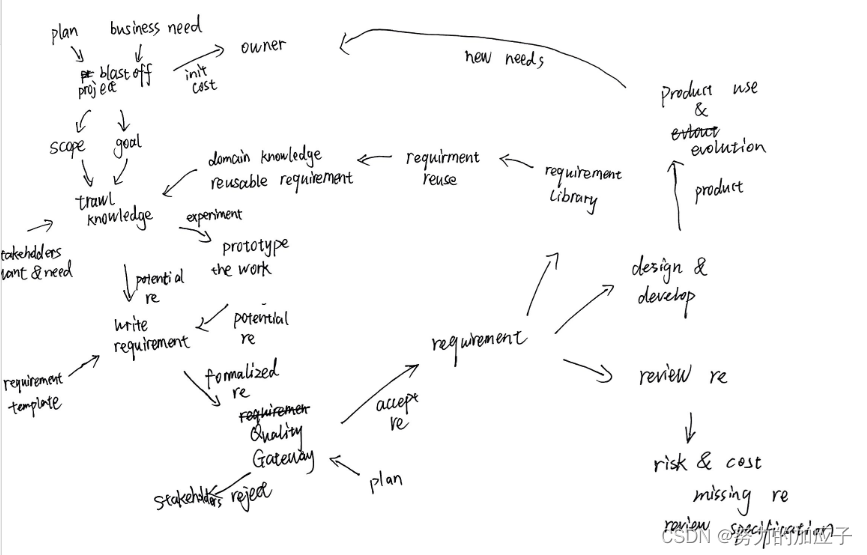

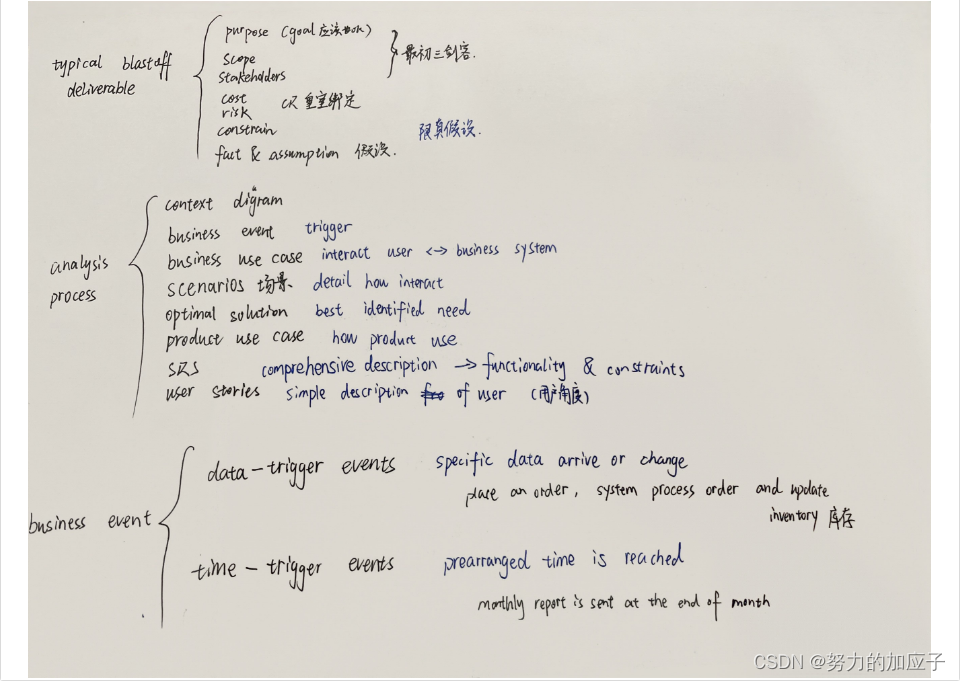


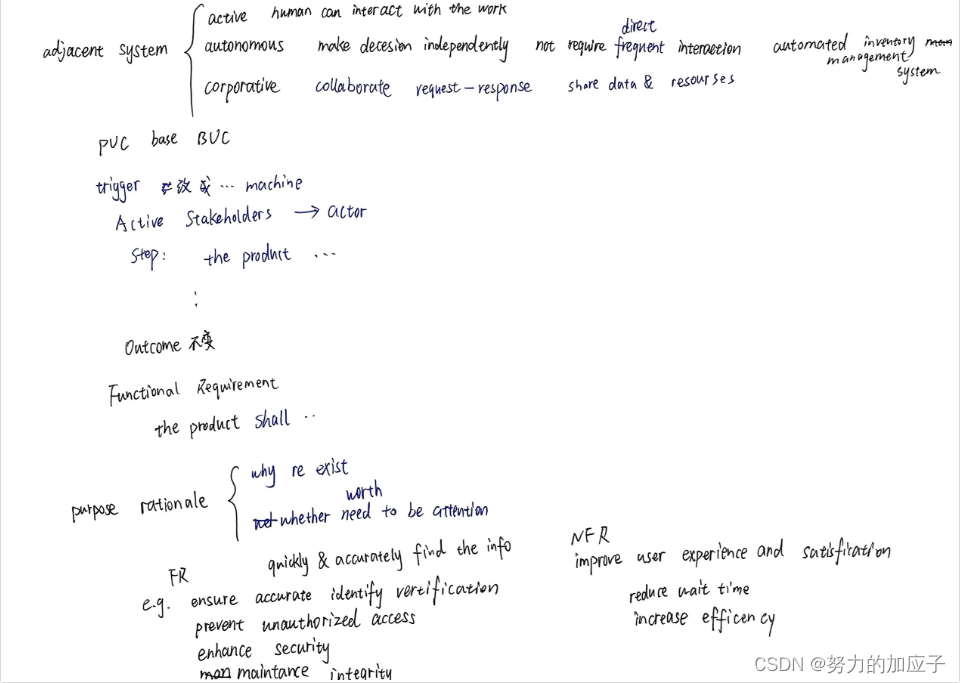

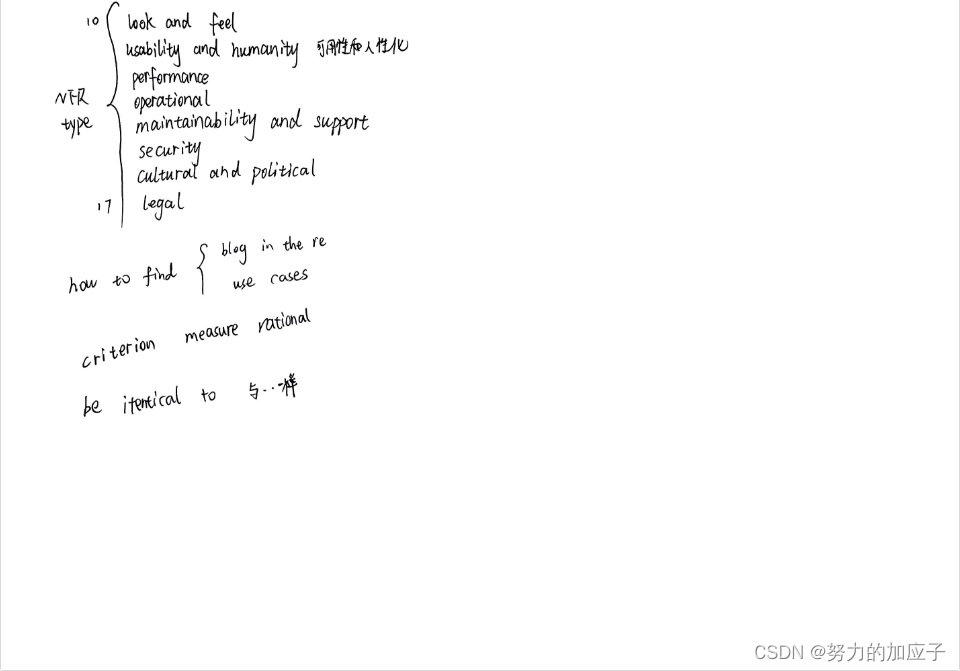
1

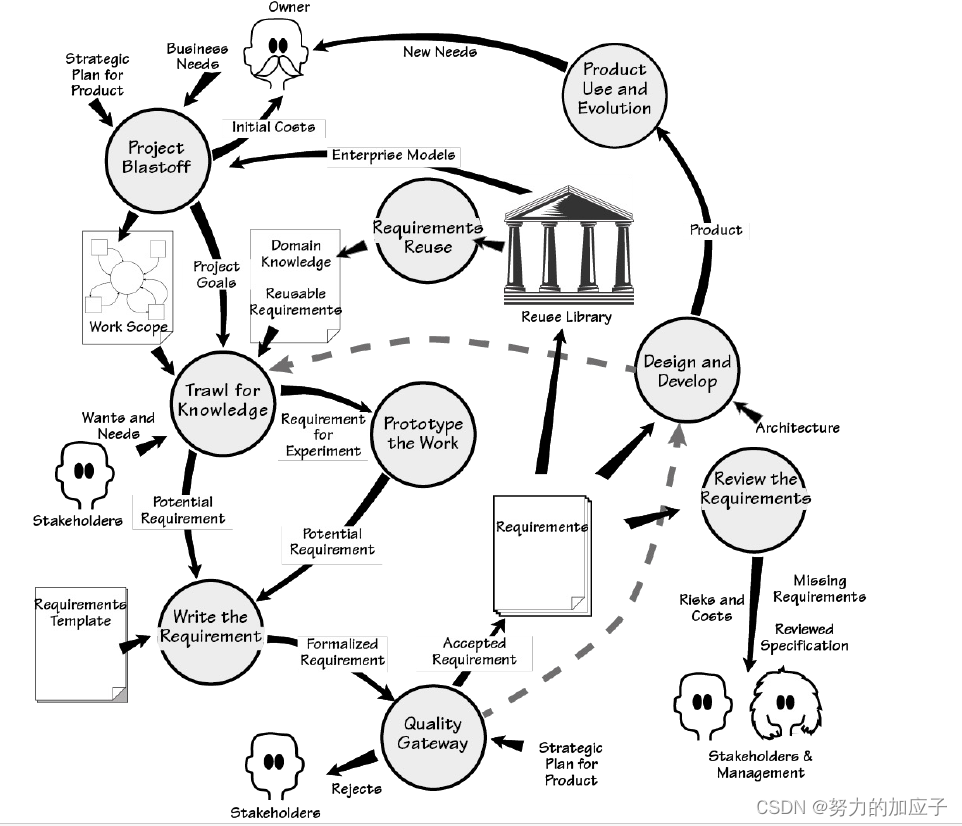
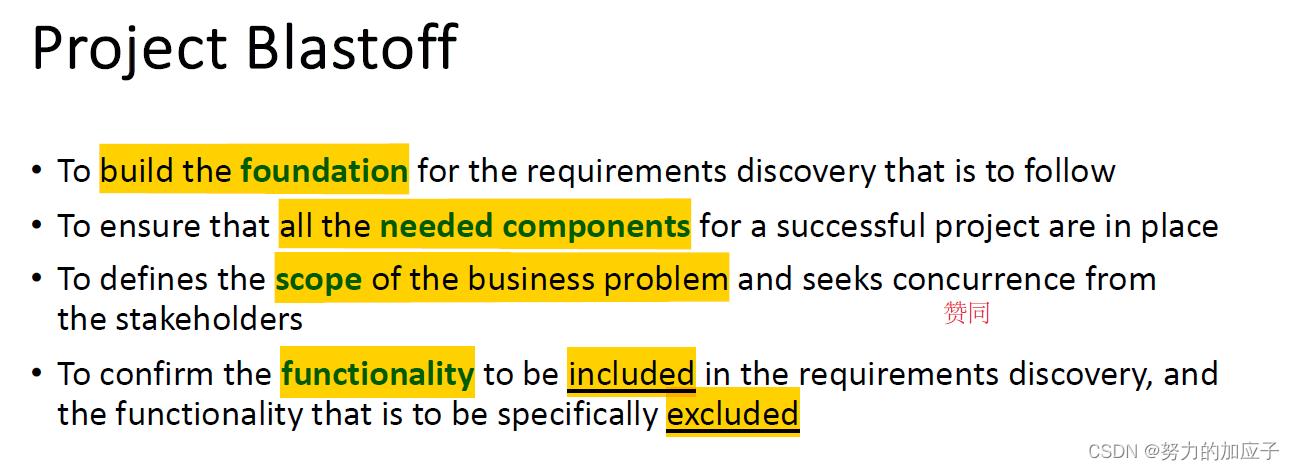
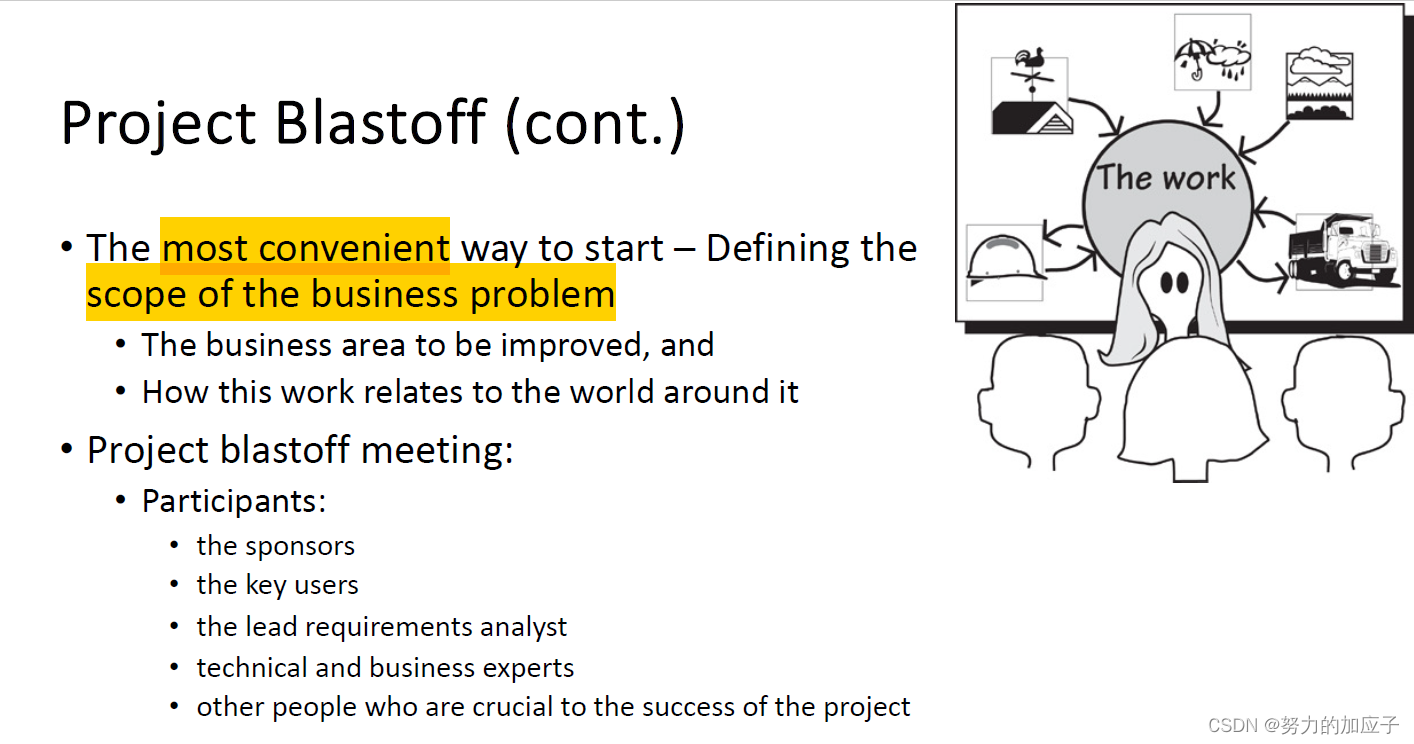
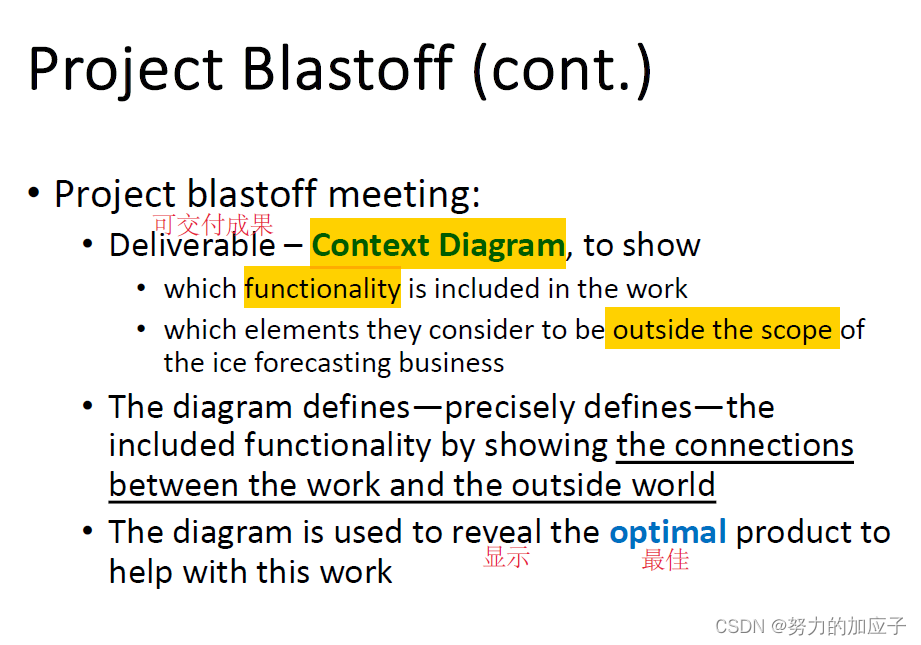

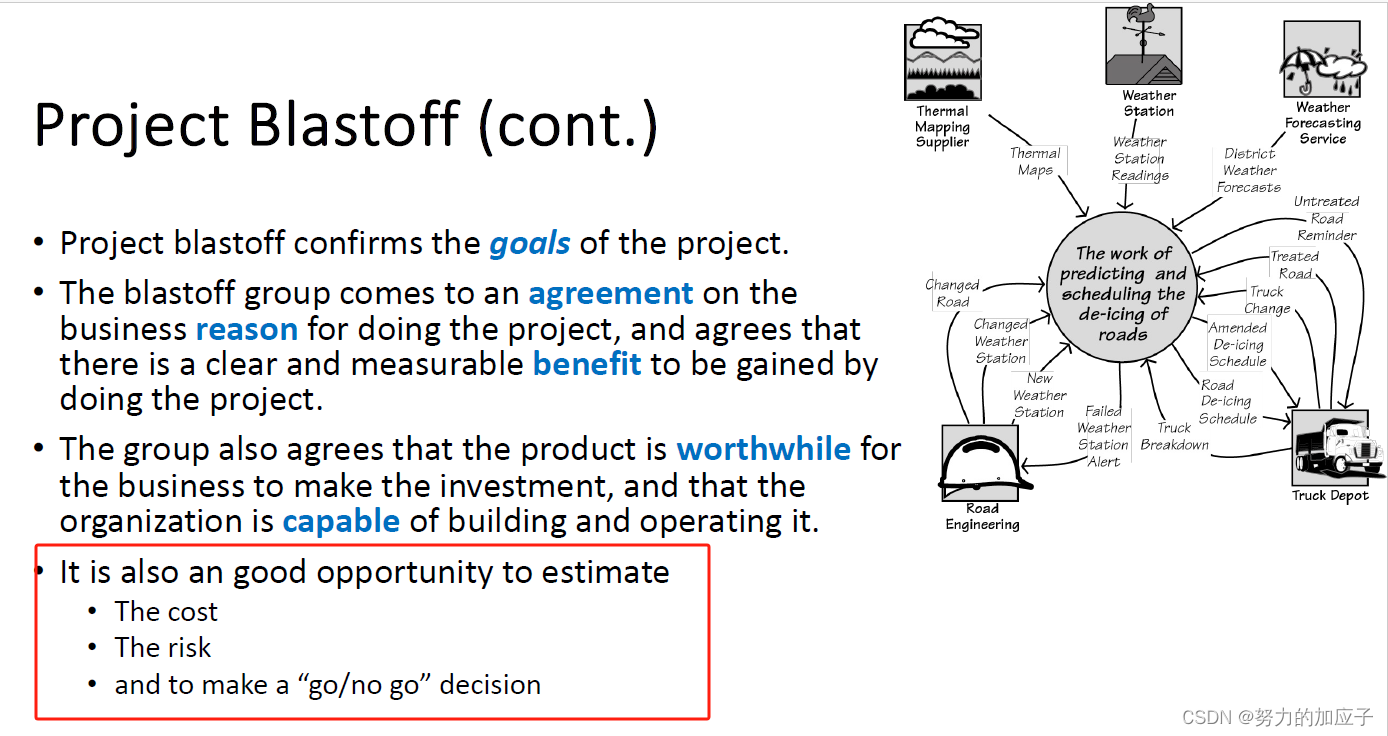

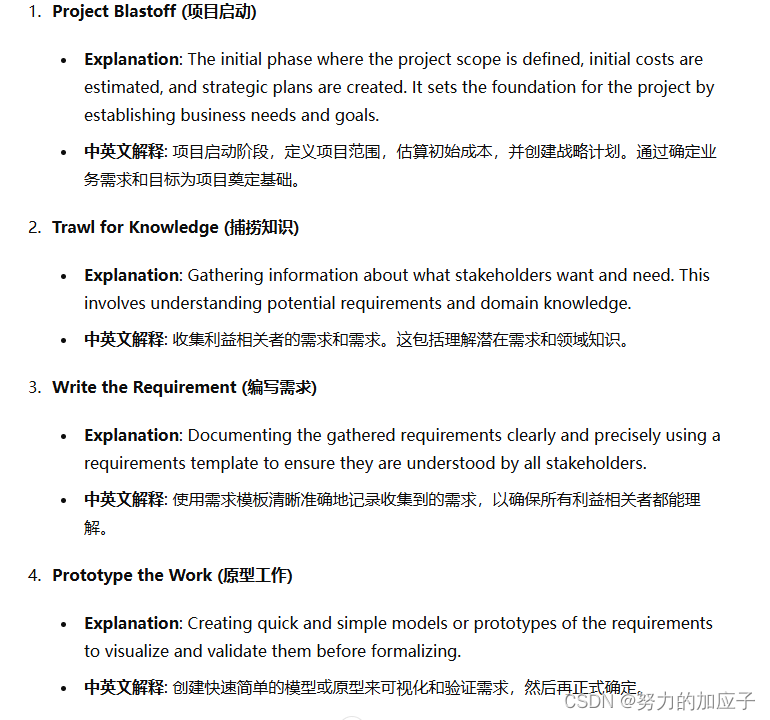

2


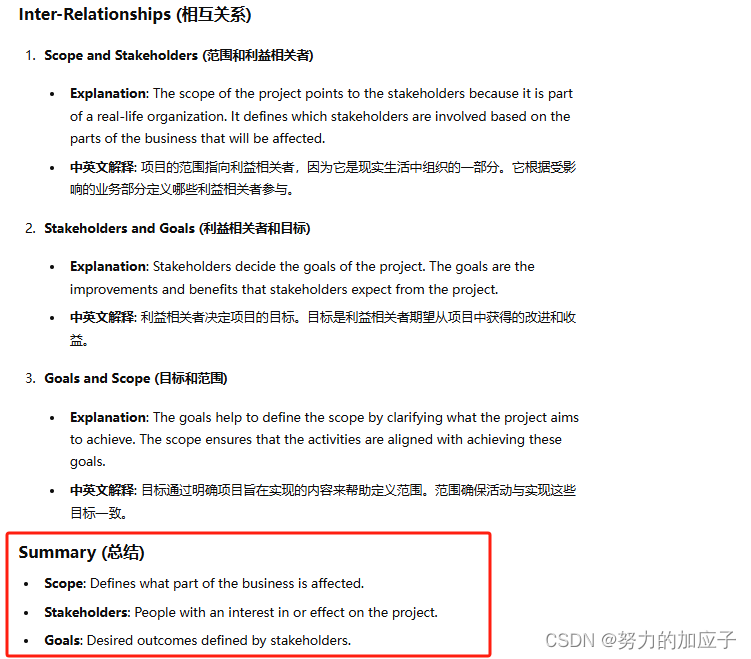
3



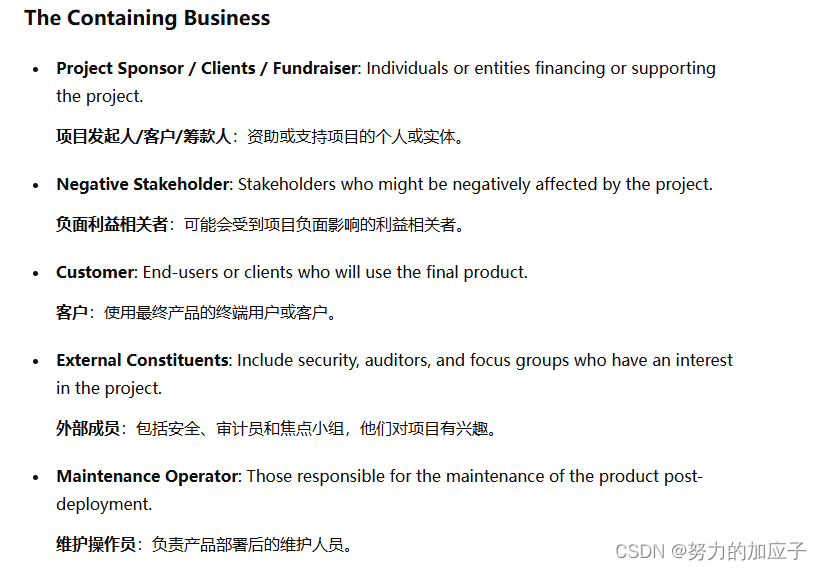
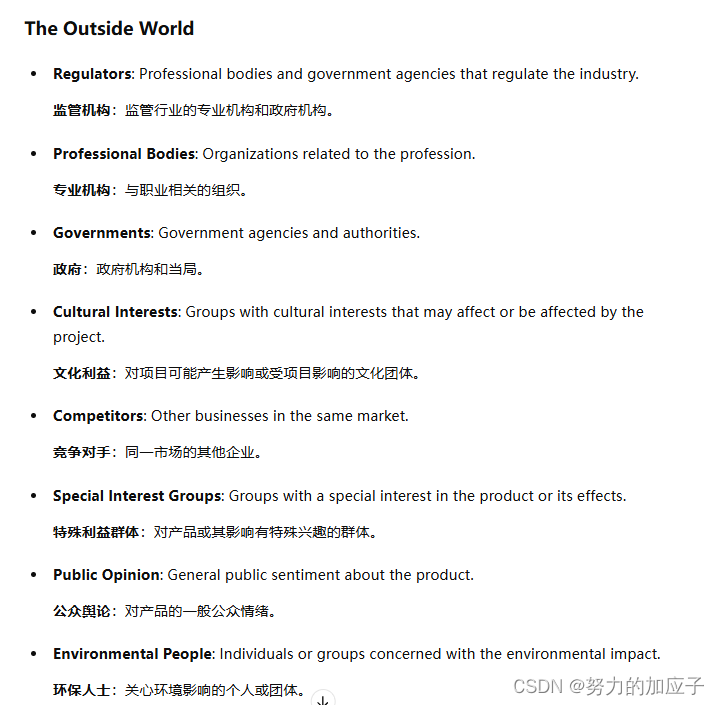
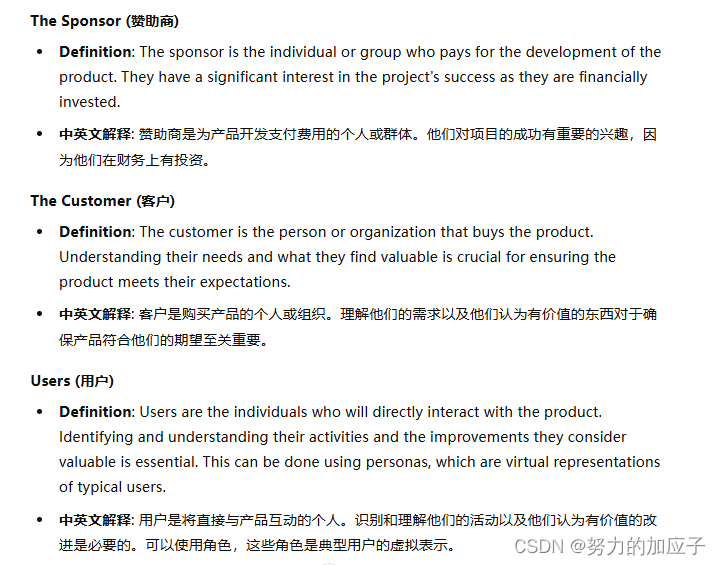
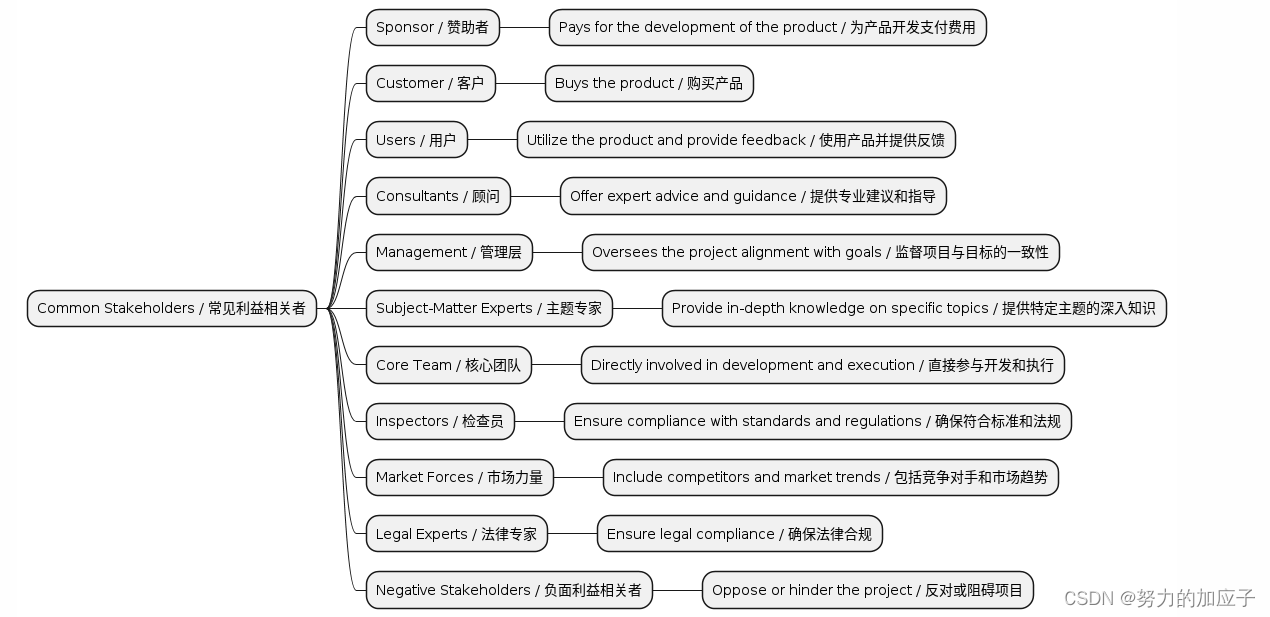
@startmindmap
* Common Stakeholders / 常见利益相关者
** Sponsor / 赞助者
*** Pays for the development of the product / 为产品开发支付费用
** Customer / 客户
*** Buys the product / 购买产品
** Users / 用户
*** Utilize the product and provide feedback / 使用产品并提供反馈
** Consultants / 顾问
*** Offer expert advice and guidance / 提供专业建议和指导
** Management / 管理层
*** Oversees the project alignment with goals / 监督项目与目标的一致性
** Subject-Matter Experts / 主题专家
*** Provide in-depth knowledge on specific topics / 提供特定主题的深入知识
** Core Team / 核心团队
*** Directly involved in development and execution / 直接参与开发和执行
** Inspectors / 检查员
*** Ensure compliance with standards and regulations / 确保符合标准和法规
** Market Forces / 市场力量
*** Include competitors and market trends / 包括竞争对手和市场趋势
** Legal Experts / 法律专家
*** Ensure legal compliance / 确保法律合规
** Negative Stakeholders / 负面利益相关者
*** Oppose or hinder the project / 反对或阻碍项目
@endmindmap
4


@startmindmap
* Constraints / 约束
** Requirements Constraints / 需求约束
*** Determine which subset of requirements can be included / 确定可以包含哪些需求子集
** Solution Constraints / 解决方案约束
*** Describe mandated designs or solutions / 描述任何强制设计或解决方案
** Project Constraints / 项目约束
*** Describe time and financial budgets / 描述项目的时间和财务预算
*** Indicate product complexity and necessity / 表明产品复杂性和必要性
@endmindmap
5

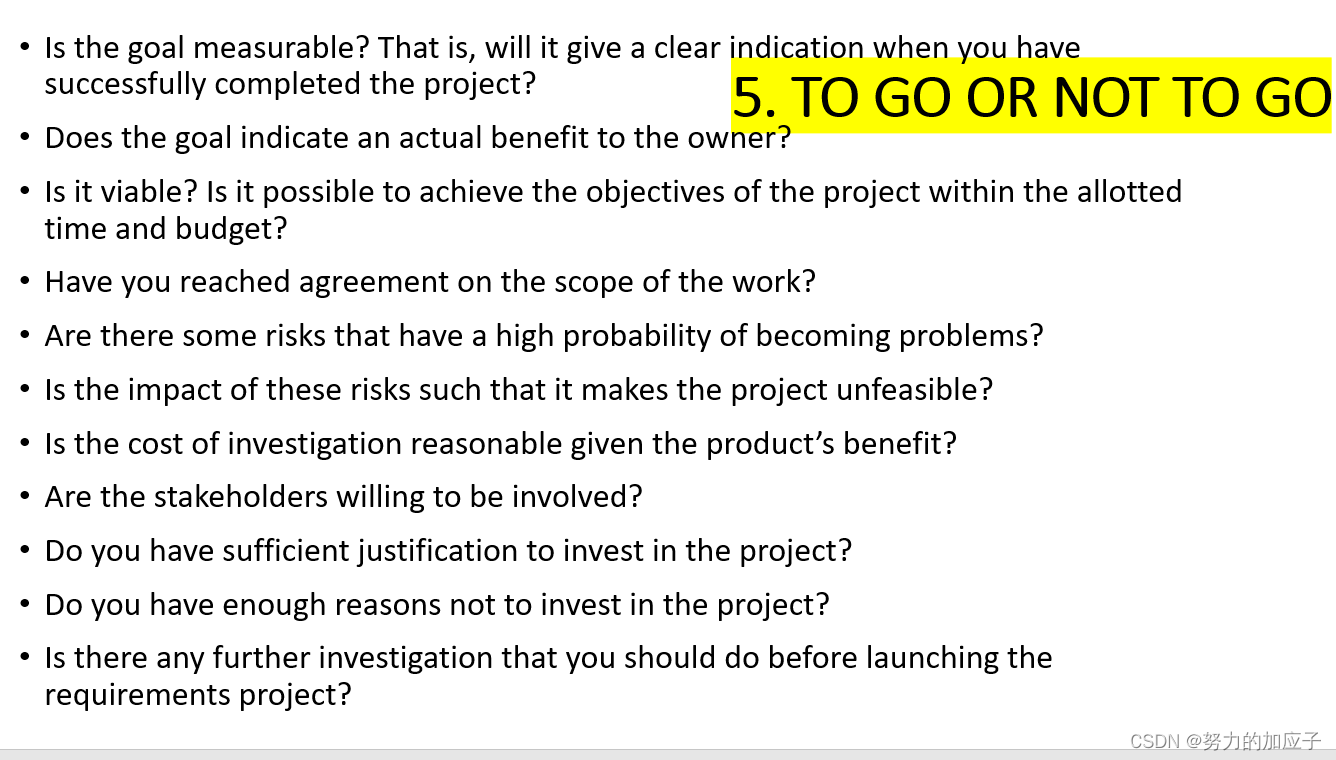
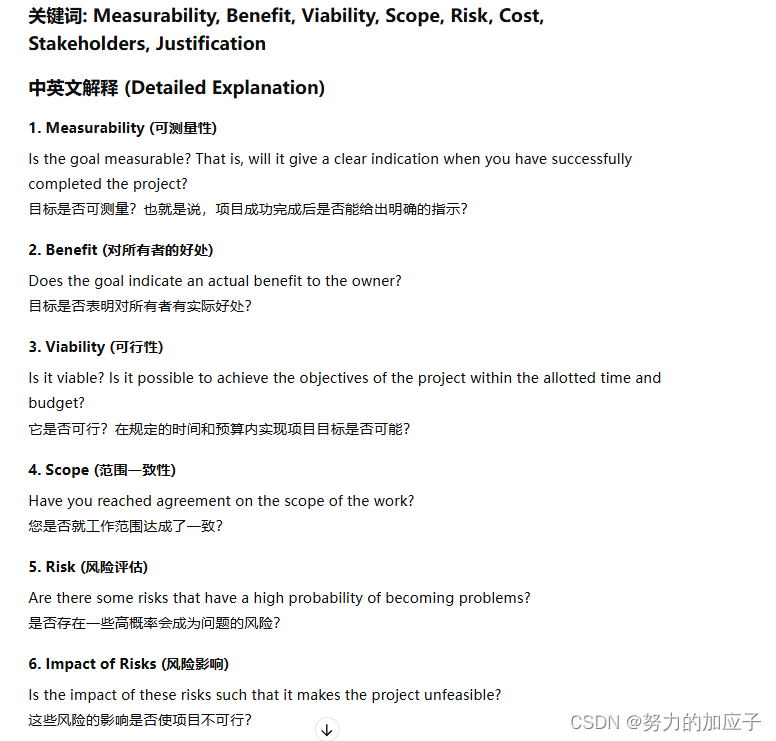
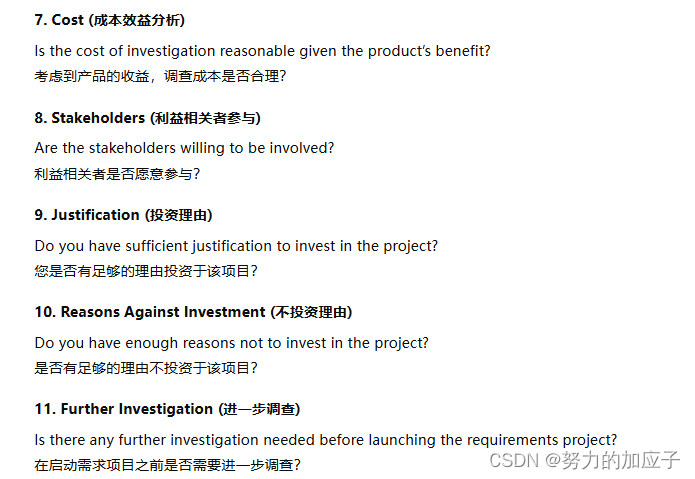
@startmindmap
* To Go or Not to Go Decision Rationale
** Measurability
*** Is the goal measurable?
** Benefit
*** Does the goal indicate an actual benefit to the owner?
** Viability生存能力
*** Is it possible to achieve the objectives within the allotted time and budget?
** Scope
*** Have all stakeholders agreed on the scope of the work?
** Risk
*** Are there high-probability risks that could impact the project?
** Impact of Risks
*** Are the risks significant enough to make the project unfeasible?
** Cost
*** Is the cost of investigation reasonable given the product’s benefit?
** Stakeholders
*** Are stakeholders willing to be involved?
** Justification
*** Do we have sufficient justification to invest in the project?
** Reasons Against Investment
*** Are there enough reasons not to invest in the project?
** Further Investigation
*** Is there any further investigation needed before launching the requirements project?
@endmindmap6

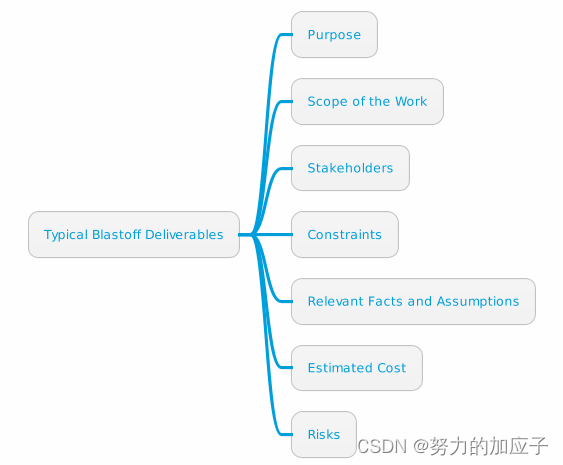
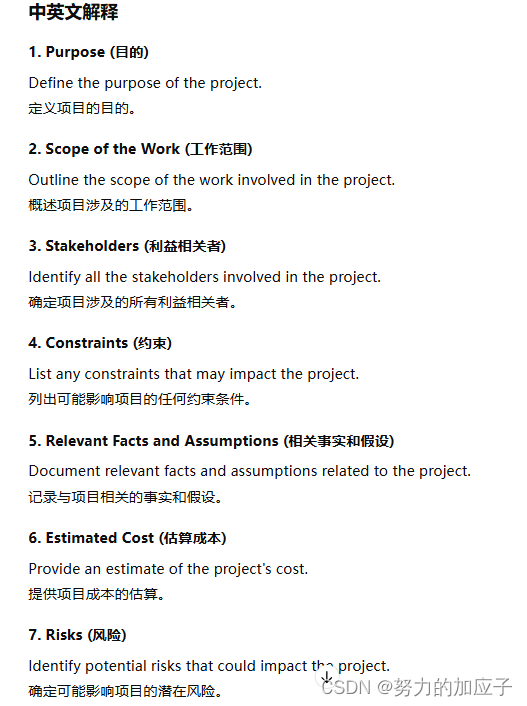
7



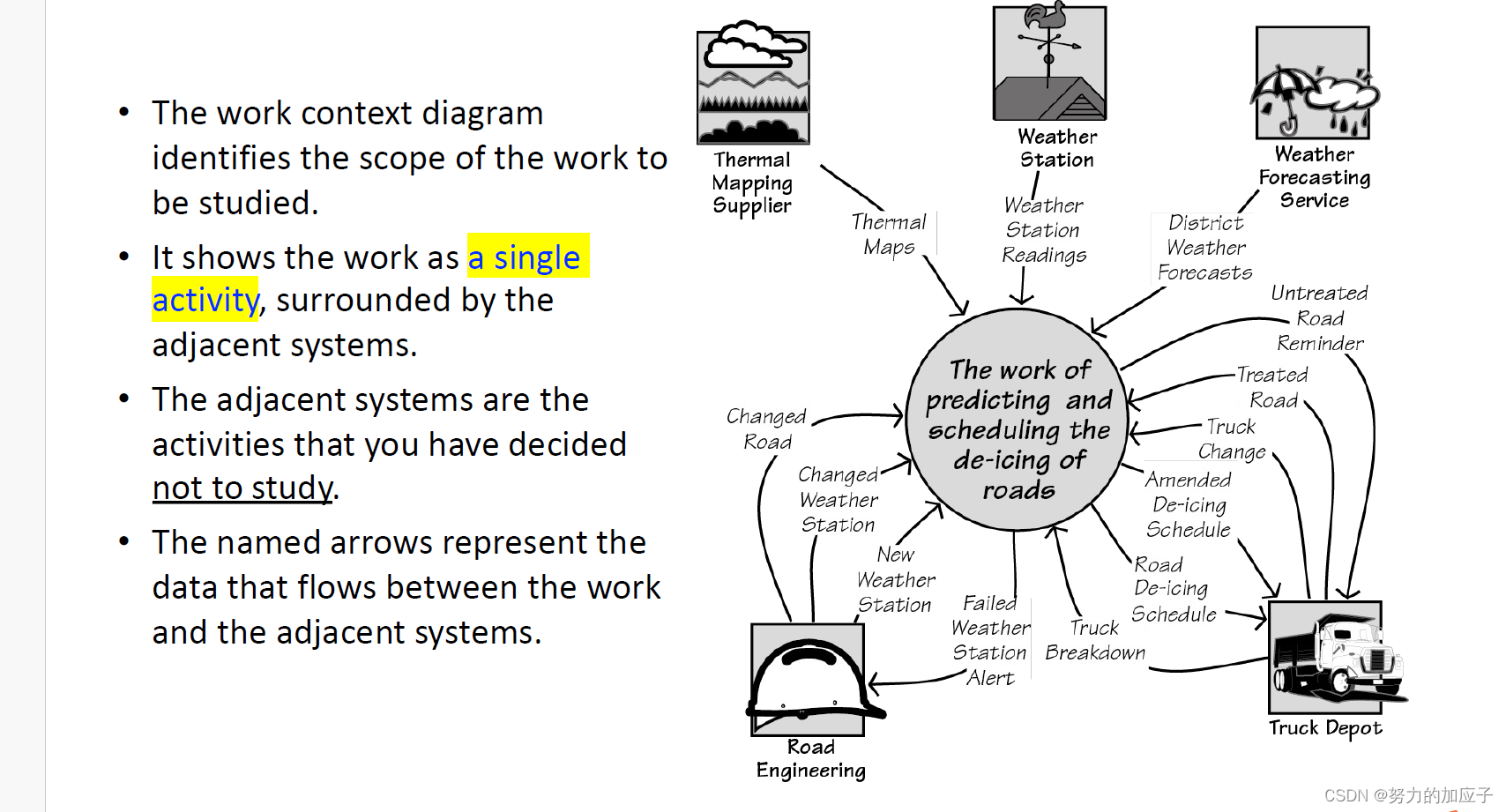
@startmindmap
* Work Context Diagram / 工作上下文图
** Work Context / 工作上下文
*** Identifies the scope of the work to be studied / 确定要研究的工作的范围
** Adjacent Systems / 相邻系统
*** Activities not included in the study / 未包括在研究中的活动
** Data Flow / 数据流
*** Represents the data flow between work and adjacent systems / 表示工作与相邻系统之间的数据流动
** Responsibilities / 职责
*** Shows where responsibilities start and end / 显示职责的起点和终点
** Product-Centric Context / 以产品为中心的上下文
*** Contains only the intended software product / 只包含预期的软件产品
@endmindmap
8

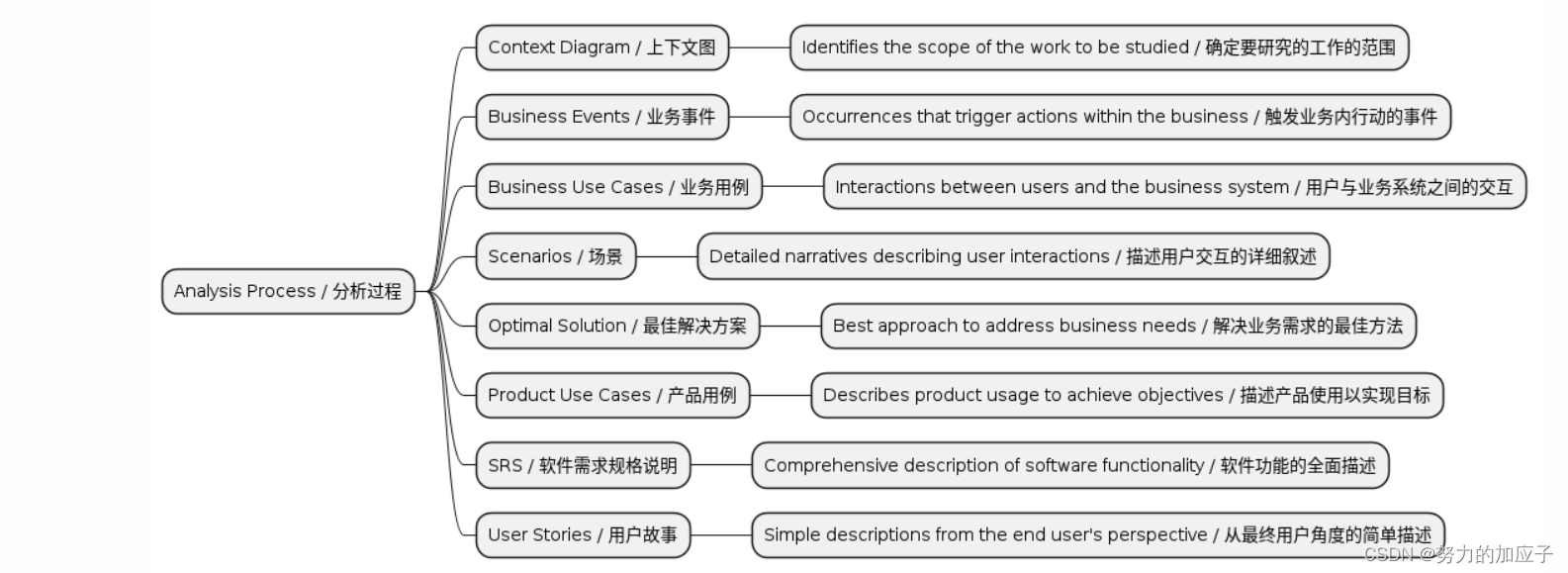
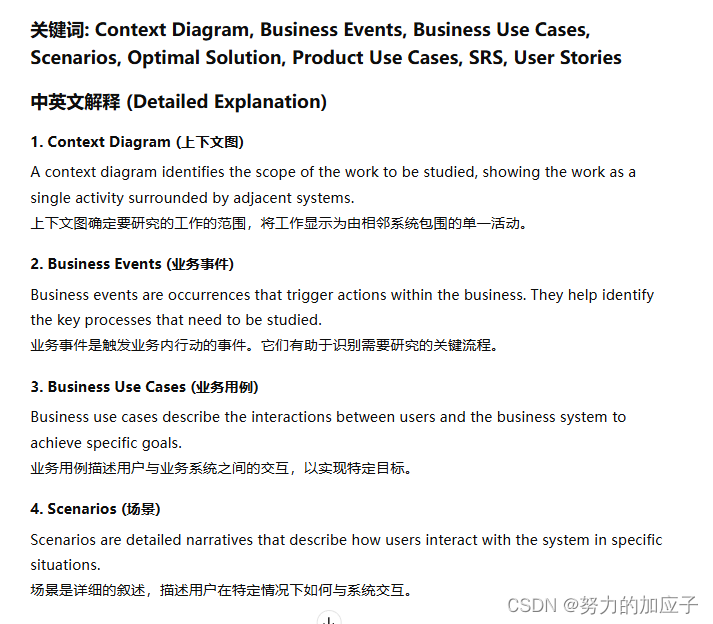
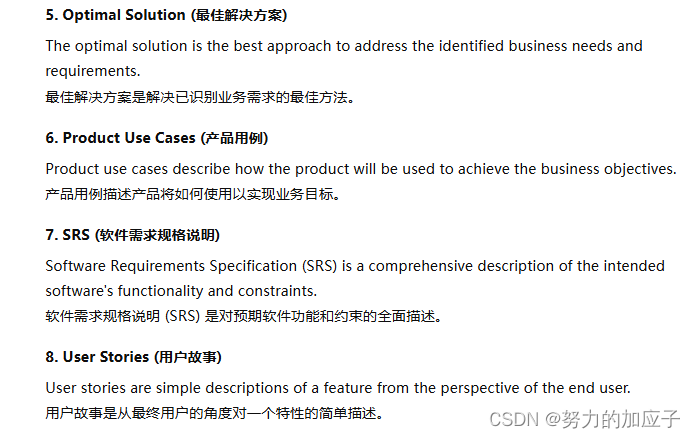
@startmindmap
* Analysis Process / 分析过程
** Context Diagram / 上下文图
*** Identifies the scope of the work to be studied / 确定要研究的工作的范围
** Business Events / 业务事件
*** Occurrences that trigger actions within the business / 触发业务内行动的事件
** Business Use Cases / 业务用例
*** Interactions between users and the business system / 用户与业务系统之间的交互
** Scenarios / 场景
*** Detailed narratives describing user interactions / 描述用户交互的详细叙述
** Optimal Solution / 最佳解决方案
*** Best approach to address business needs / 解决业务需求的最佳方法
** Product Use Cases / 产品用例
*** Describes product usage to achieve objectives / 描述产品使用以实现目标
** SRS / 软件需求规格说明
*** Comprehensive description of software functionality / 软件功能的全面描述
** User Stories / 用户故事
*** Simple descriptions from the end user's perspective / 从最终用户角度的简单描述
@endmindmap
9

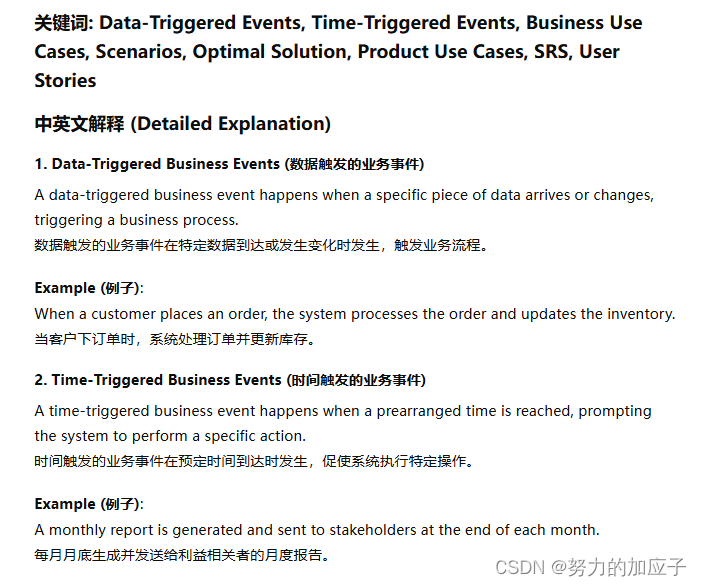

@startmindmap
* Business Events / 业务事件
** Data-Triggered Events / 数据触发的业务事件
*** Happens when specific data arrives or changes / 在特定数据到达或发生变化时发生
*** Example: Customer places an order, system updates inventory / 例子: 客户下订单,系统更新库存
** Time-Triggered Events / 时间触发的业务事件
*** Happens when a prearranged time is reached / 在预定时间到达时发生
*** Example: Monthly report generated at the end of the month / 例子: 月底生成月度报告
@endmindmap
10

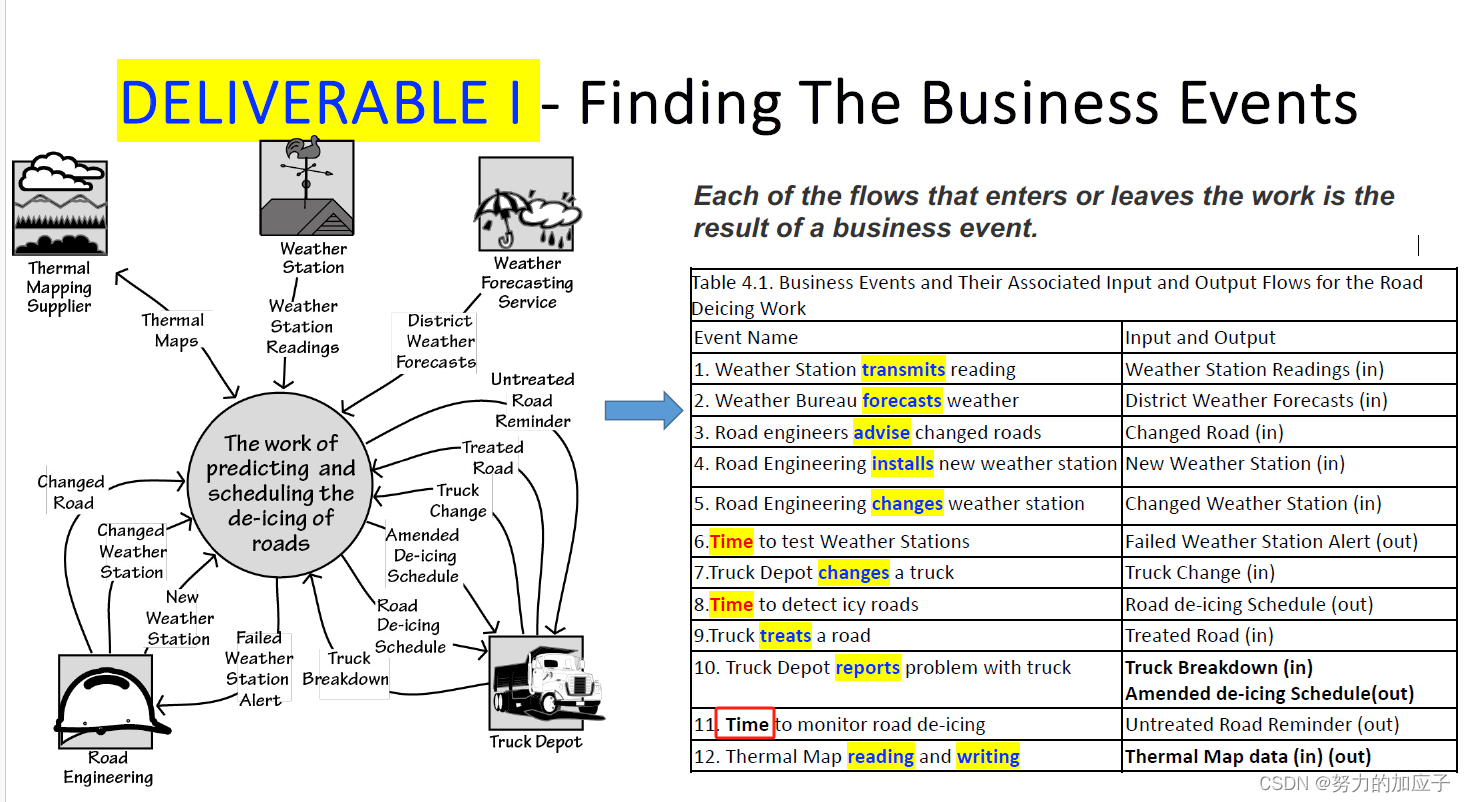
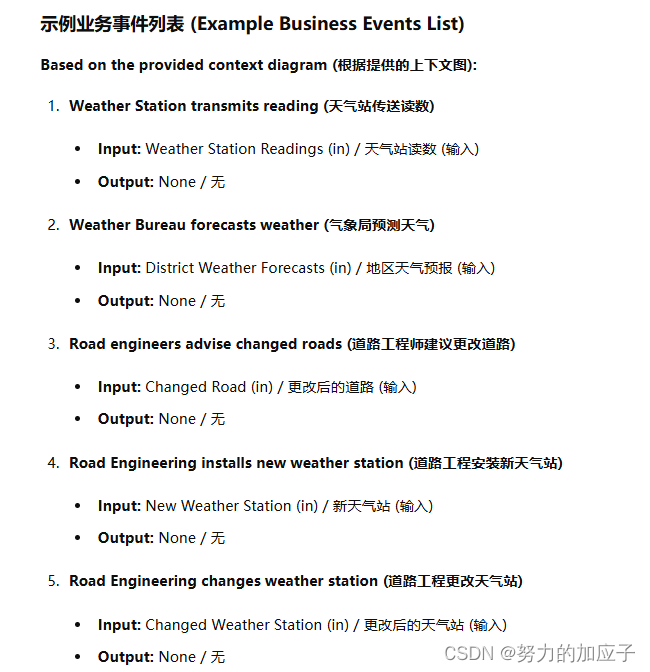
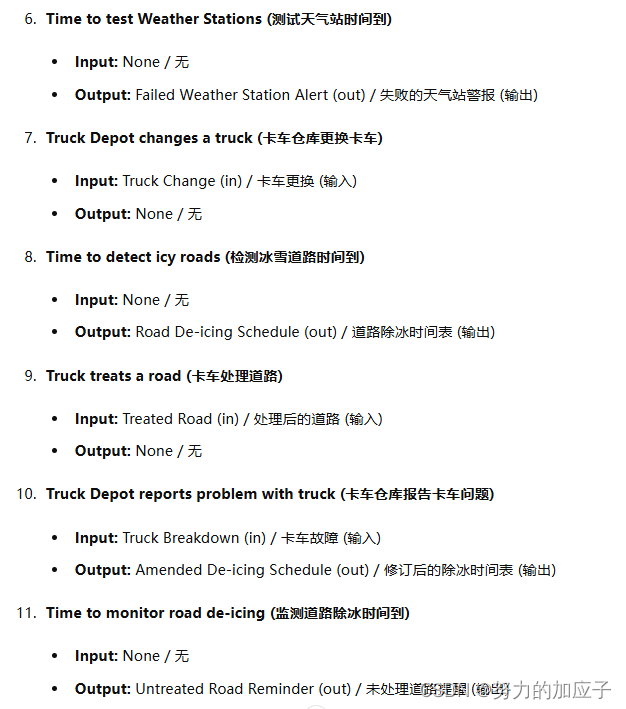
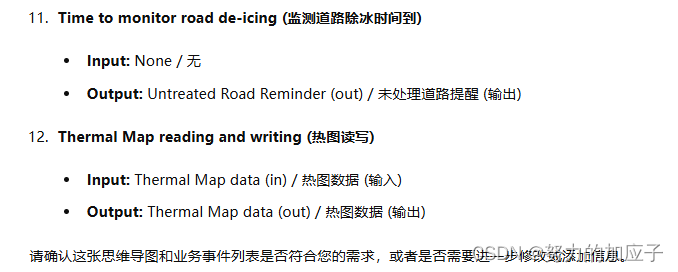


@startmindmap
* Business Events List / 业务事件列表
** Context Diagram / 上下文图
*** Scope of the work to be studied / 要研究的工作的范围
** Input / 输入
*** Data or triggers coming into the system / 进入系统的数据或触发器
** Output / 输出
*** Data or actions generated by the system / 系统生成的数据或操作
** Business Use Cases / 业务用例
*** System interactions to handle events / 系统处理事件的交互
@endmindmap
11

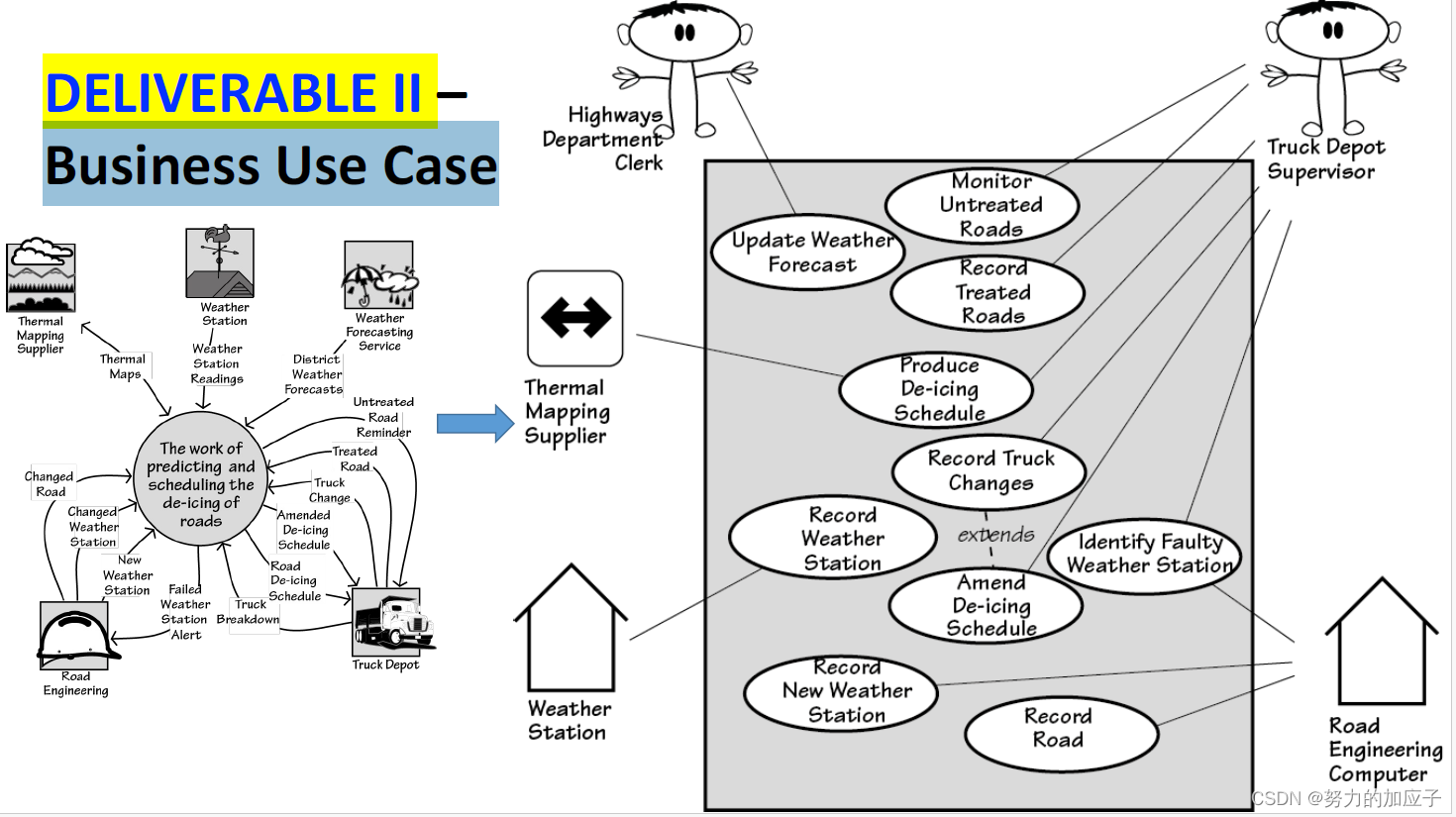

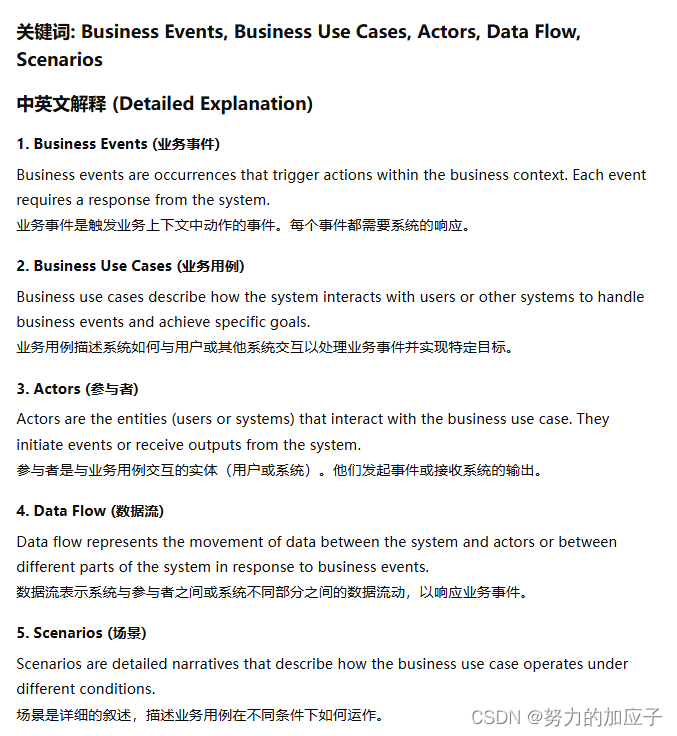
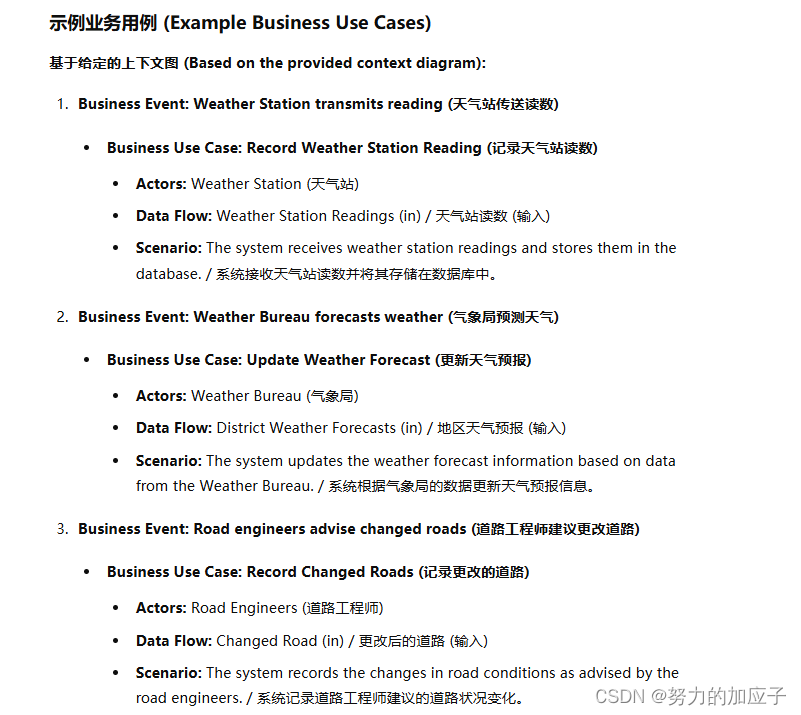
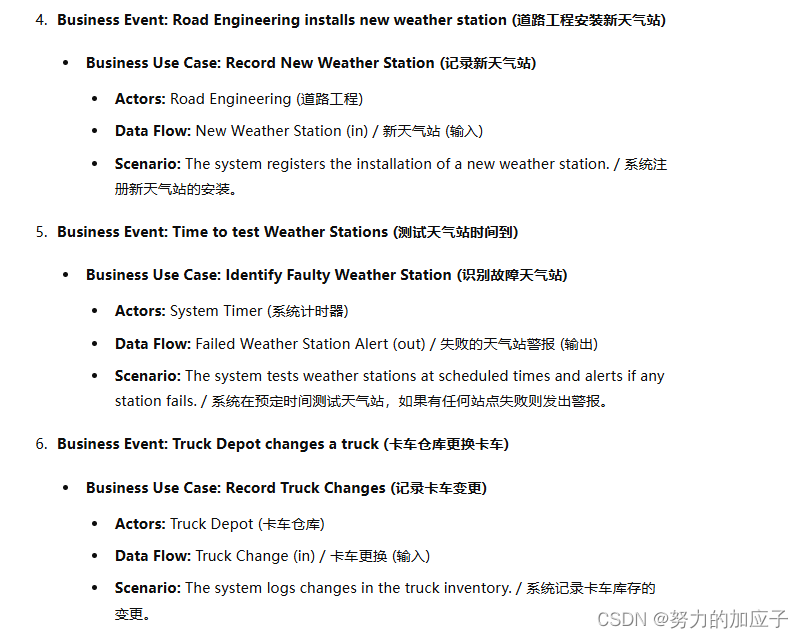
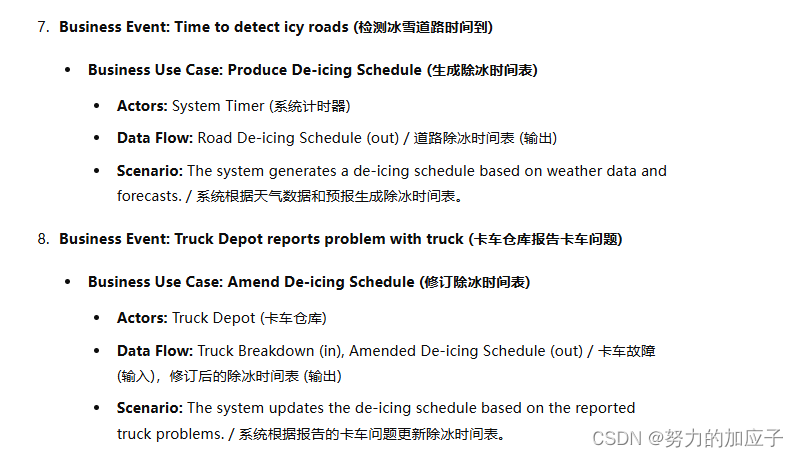
@startmindmap
* Business Use Case from Business Events / 从业务事件生成业务用例
** Business Events / 业务事件
*** Trigger actions within business context / 触发业务上下文中的动作
** Business Use Cases / 业务用例
*** Describe interactions to handle events / 描述处理事件的交互
** Actors / 参与者
*** Entities that interact with the use case / 与用例交互的实体
** Data Flow / 数据流
*** Movement of data in response to events / 响应事件的数据流动
** Scenarios / 场景
*** Detailed narratives of use case operation / 用例操作的详细叙述
@endmindmap
12

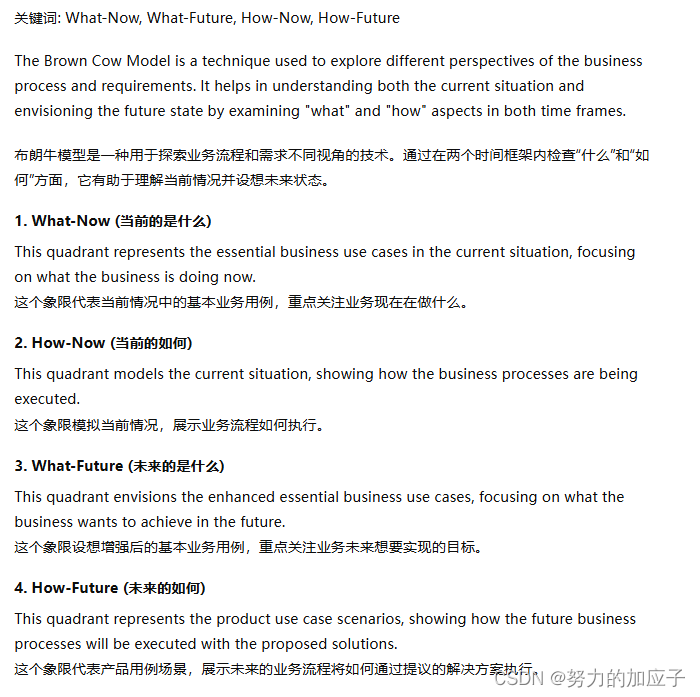
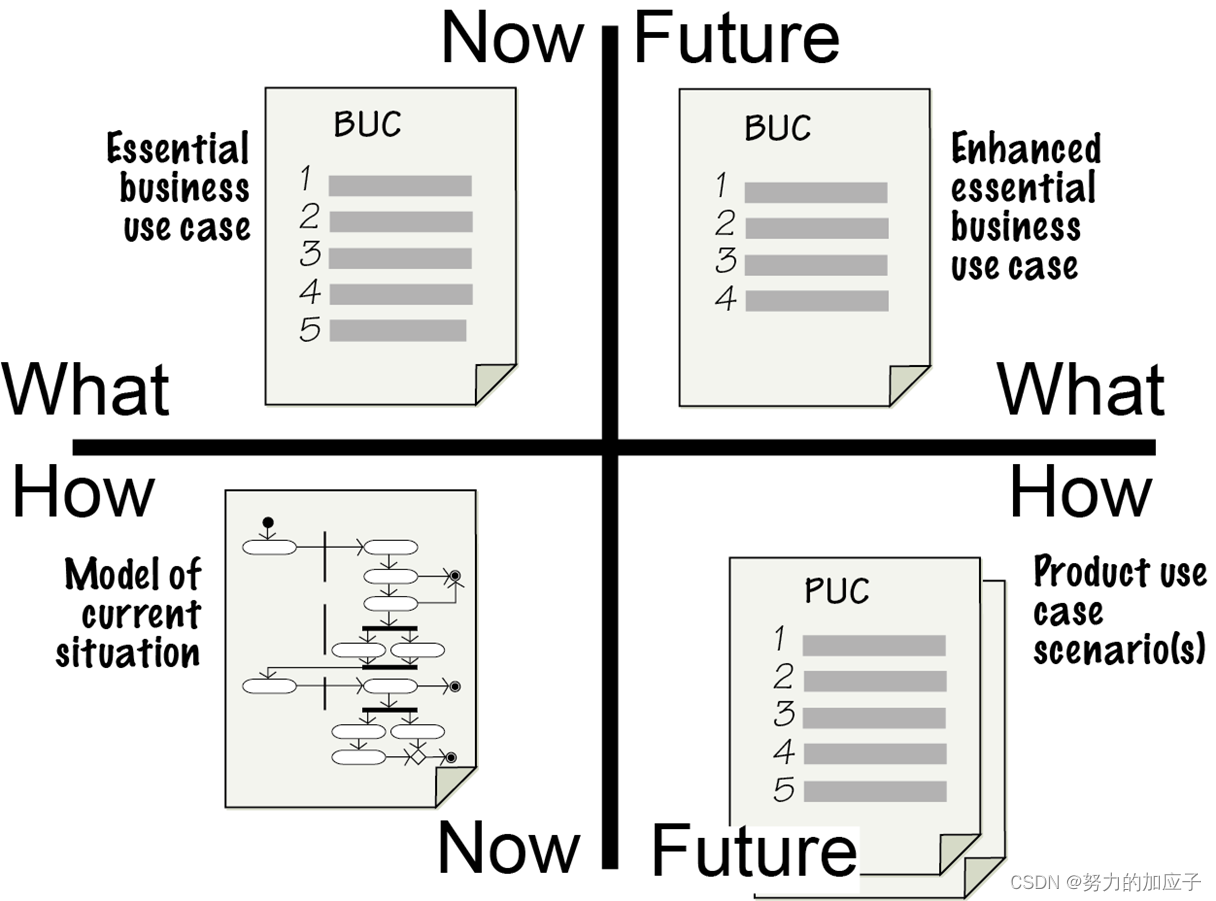

@startmindmap
* The Brown Cow Model / 布朗牛模型
** What-Now / 当前的是什么
*** Essential business use cases in the current situation / 当前情况中的基本业务用例
** How-Now / 当前的如何
*** Model of current situation / 当前情况的模型
** What-Future / 未来的是什么
*** Enhanced essential business use cases / 增强后的基本业务用例
** How-Future / 未来的如何
*** Product use case scenarios / 产品用例场景
@endmindmap
13

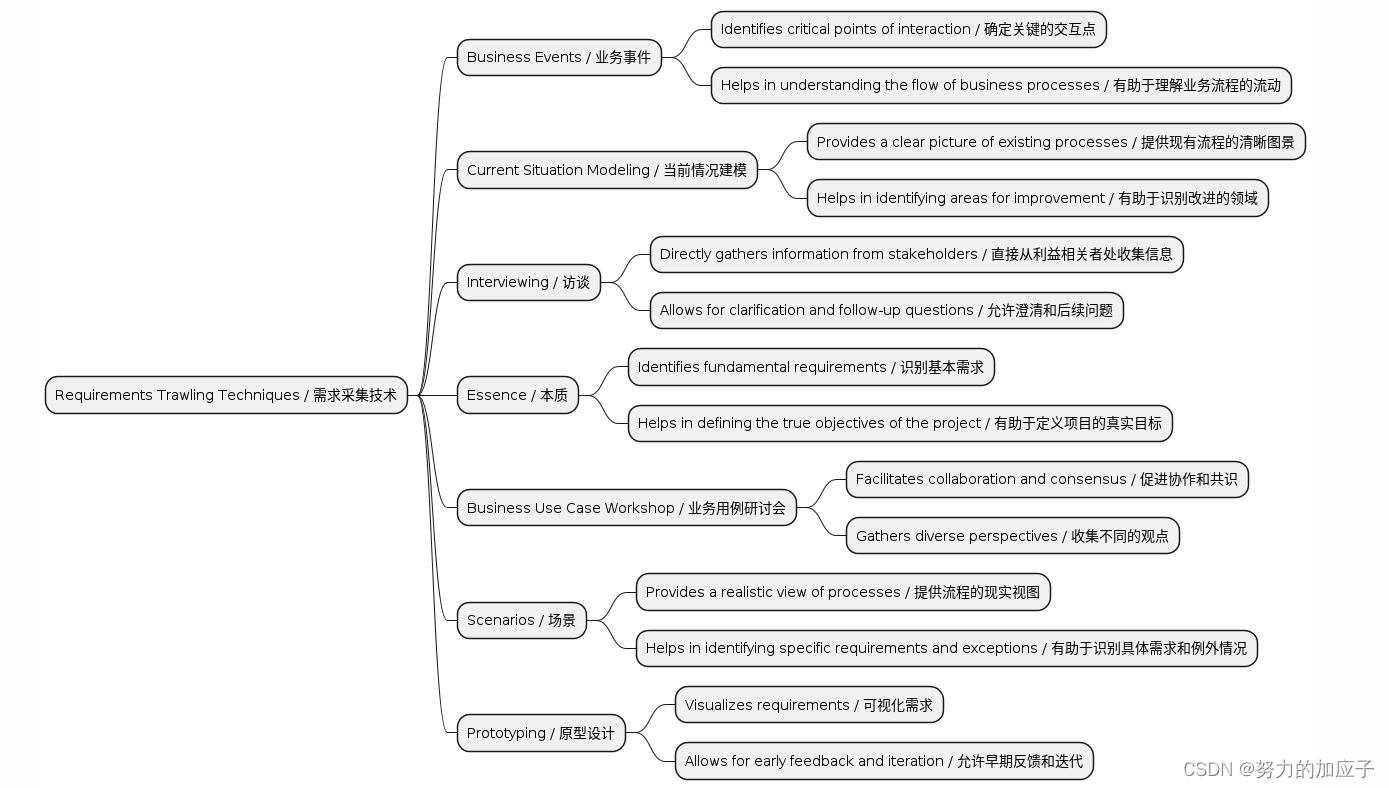
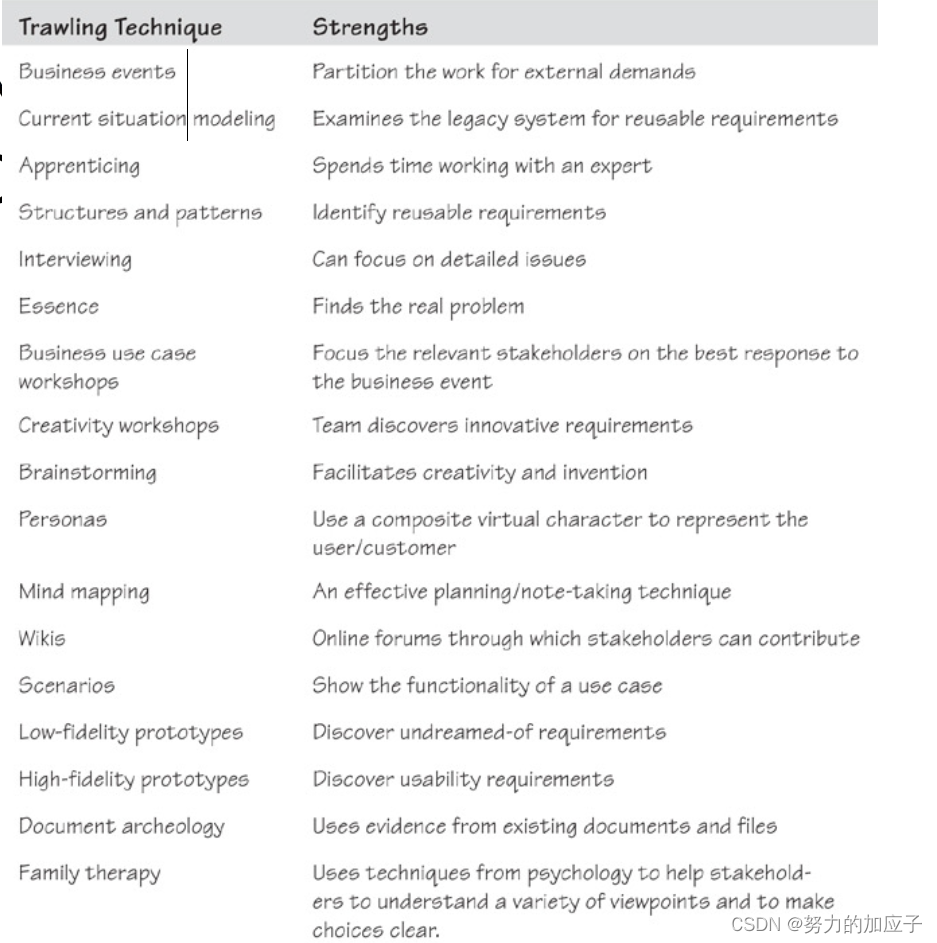
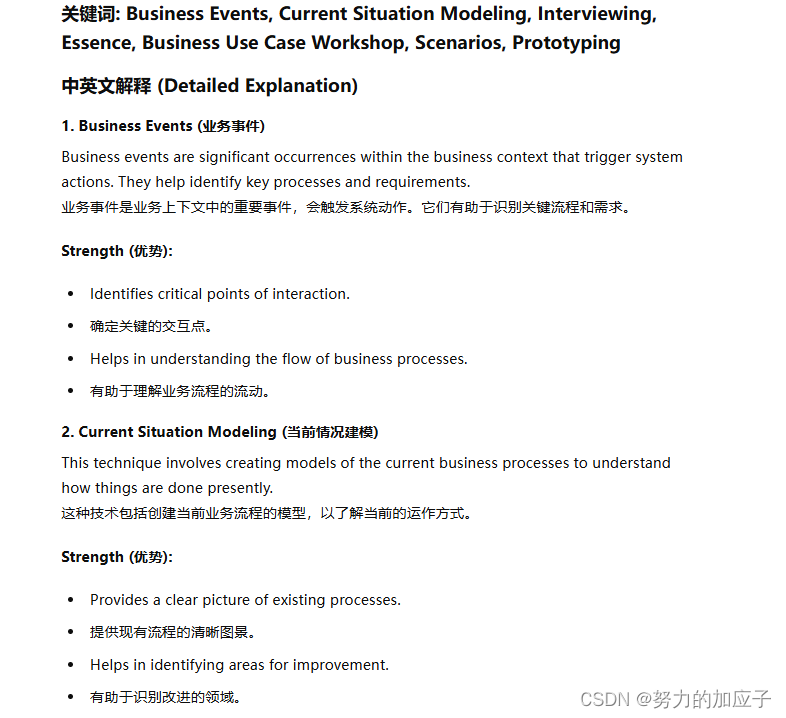
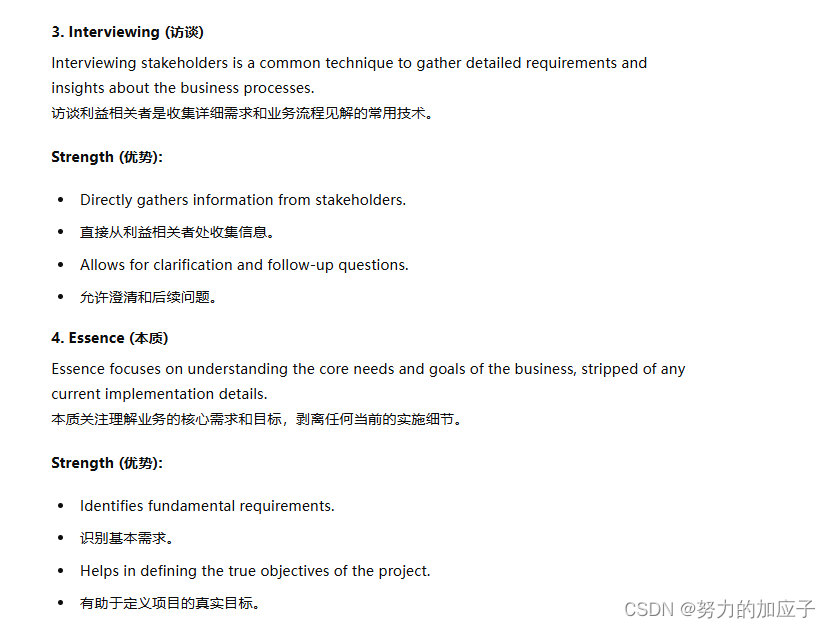
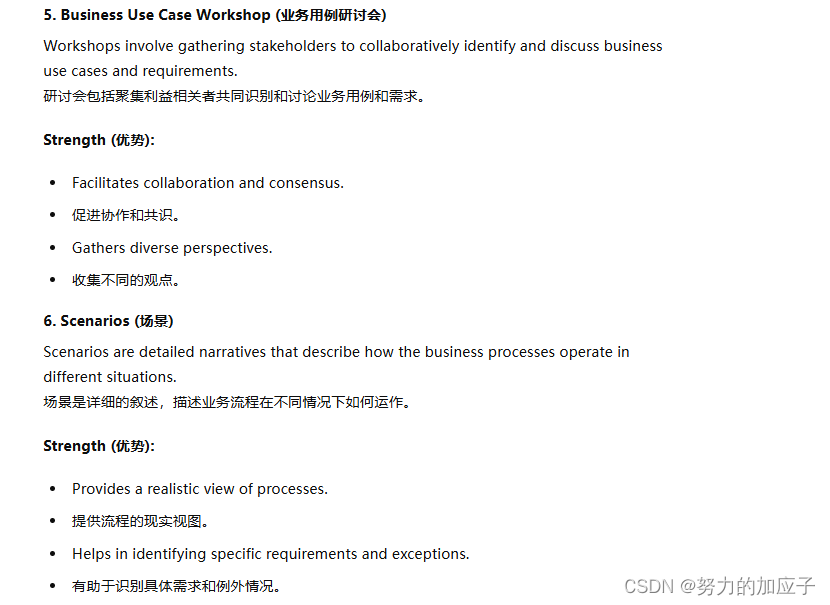
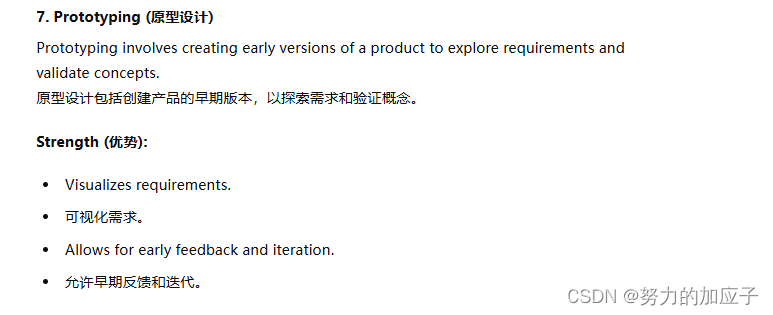
@startmindmap
* Requirements Trawling Techniques / 需求采集技术
** Business Events / 业务事件
*** Identifies critical points of interaction / 确定关键的交互点
*** Helps in understanding the flow of business processes / 有助于理解业务流程的流动
** Current Situation Modeling / 当前情况建模
*** Provides a clear picture of existing processes / 提供现有流程的清晰图景
*** Helps in identifying areas for improvement / 有助于识别改进的领域
** Interviewing / 访谈
*** Directly gathers information from stakeholders / 直接从利益相关者处收集信息
*** Allows for clarification and follow-up questions / 允许澄清和后续问题
** Essence / 本质
*** Identifies fundamental requirements / 识别基本需求
*** Helps in defining the true objectives of the project / 有助于定义项目的真实目标
** Business Use Case Workshop / 业务用例研讨会
*** Facilitates collaboration and consensus / 促进协作和共识
*** Gathers diverse perspectives / 收集不同的观点
** Scenarios / 场景
*** Provides a realistic view of processes / 提供流程的现实视图
*** Helps in identifying specific requirements and exceptions / 有助于识别具体需求和例外情况
** Prototyping / 原型设计
*** Visualizes requirements / 可视化需求
*** Allows for early feedback and iteration / 允许早期反馈和迭代
@endmindmap
14
![]()
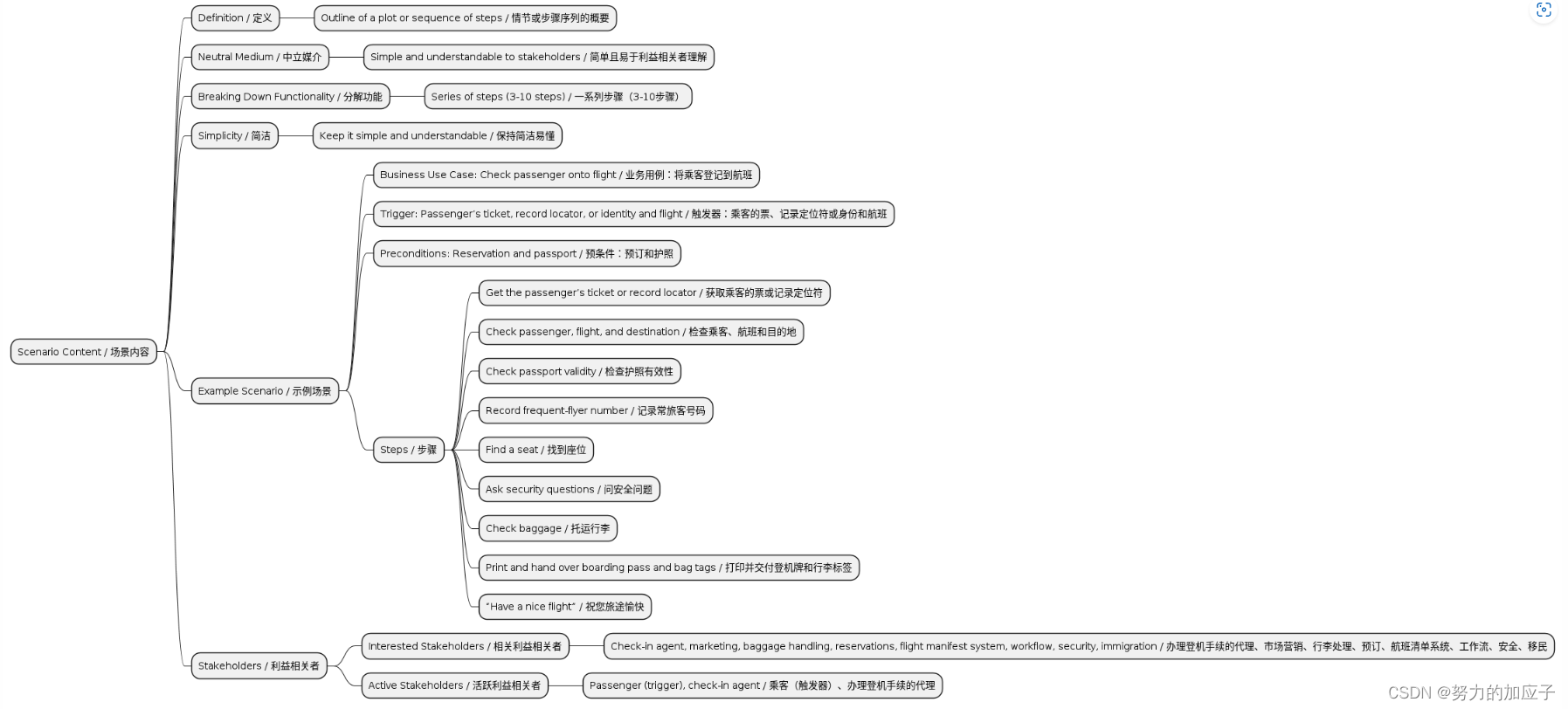

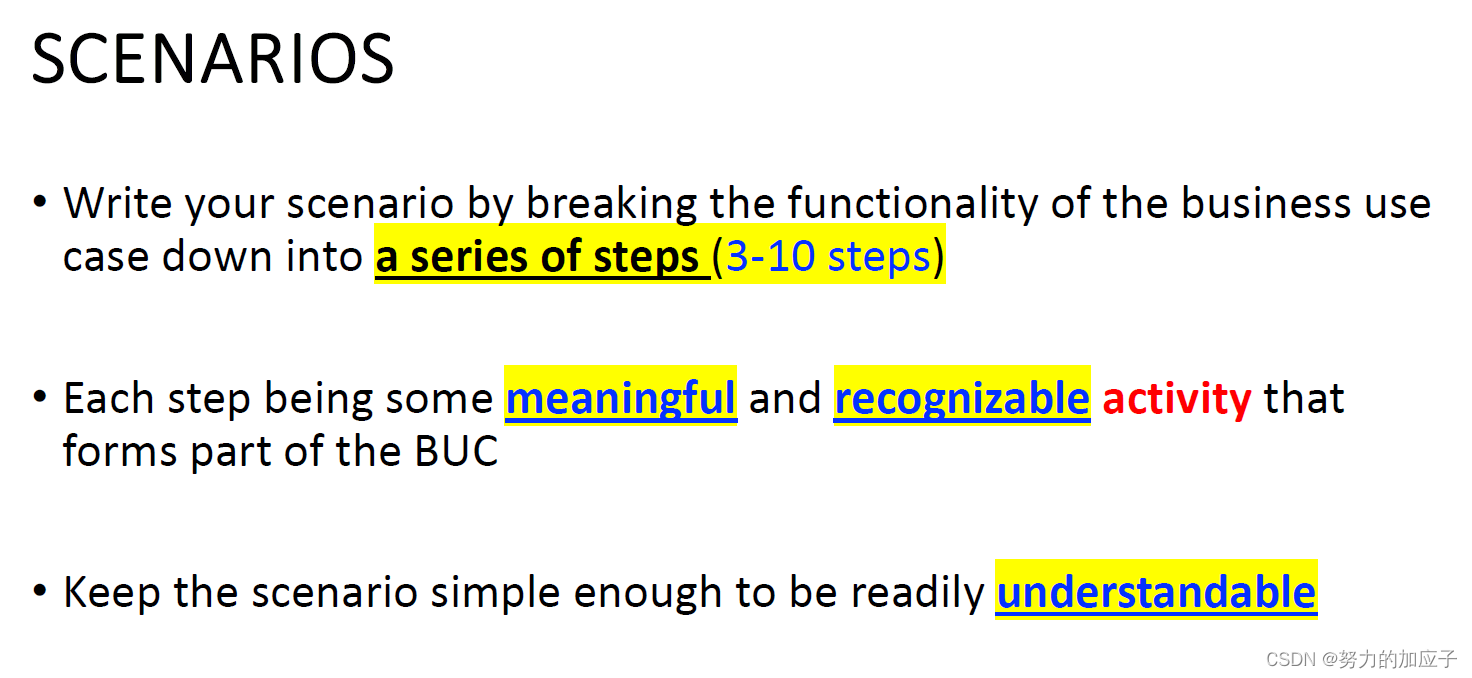
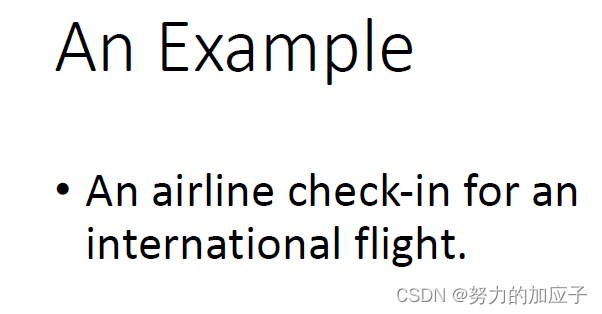
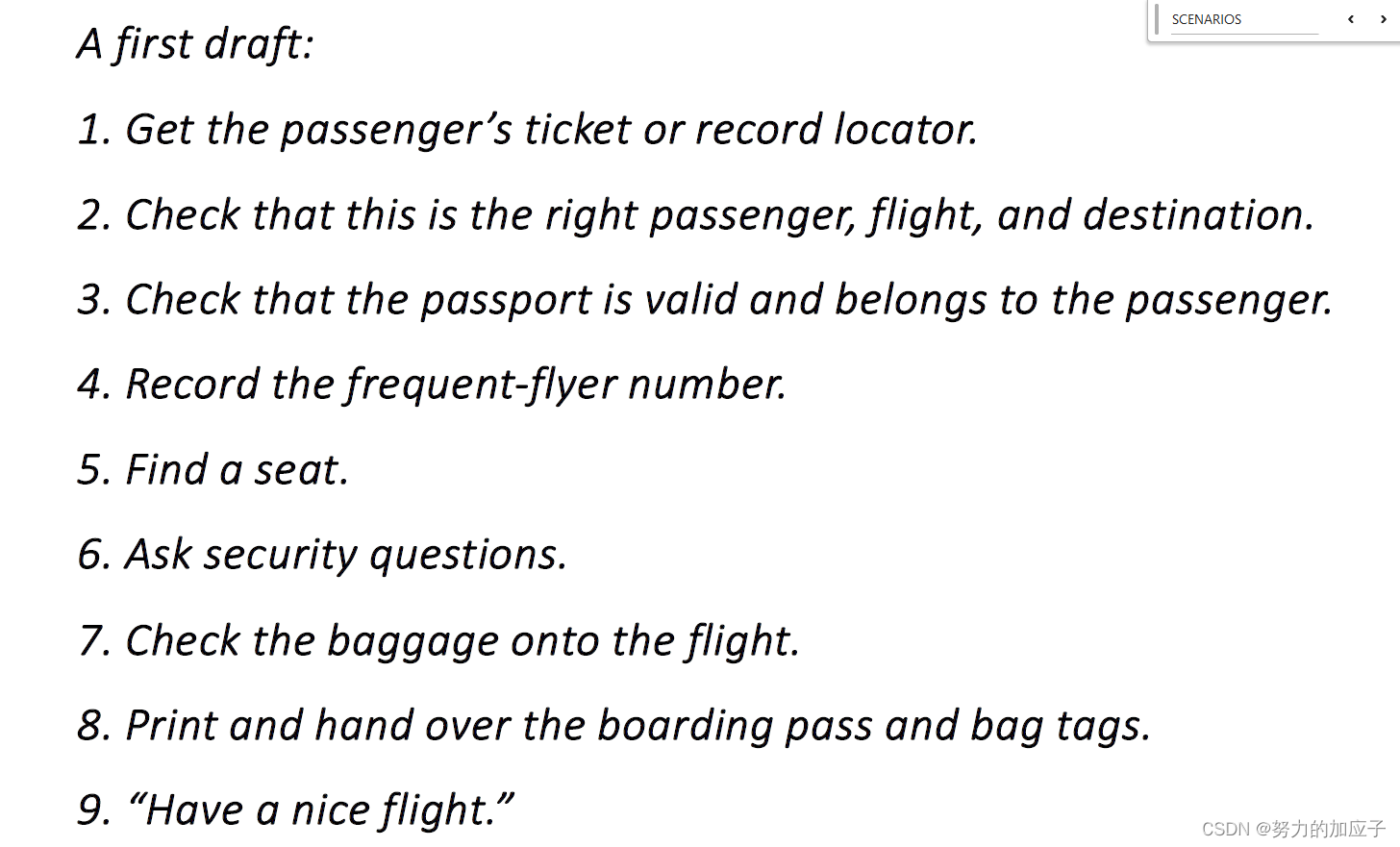

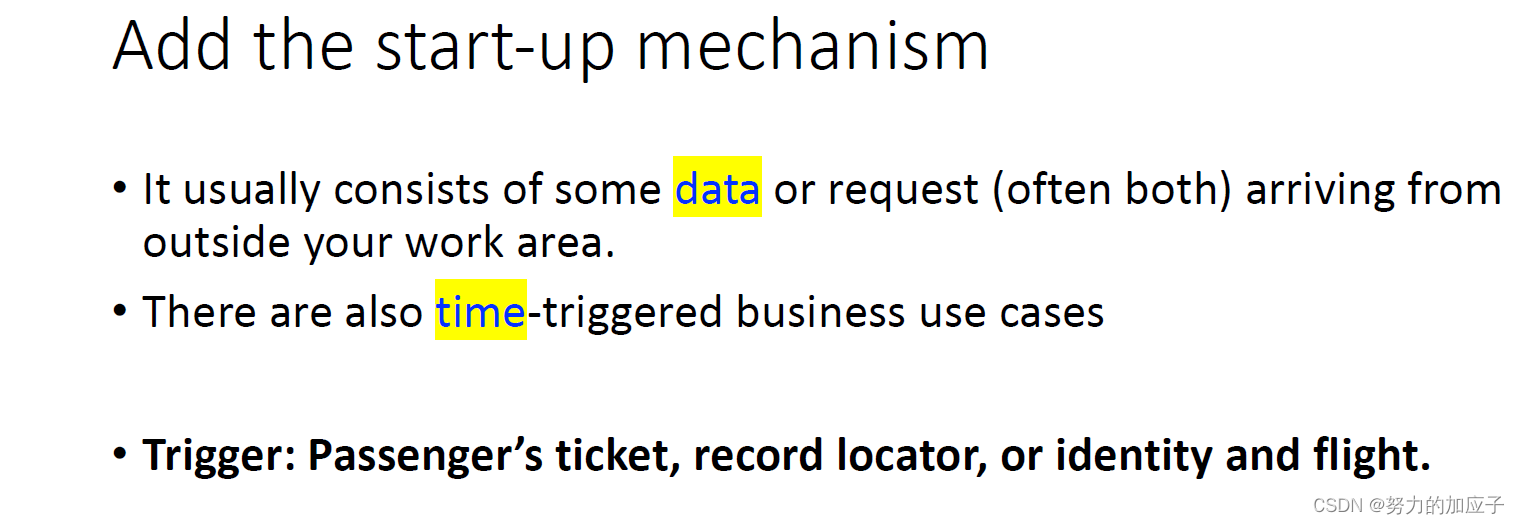
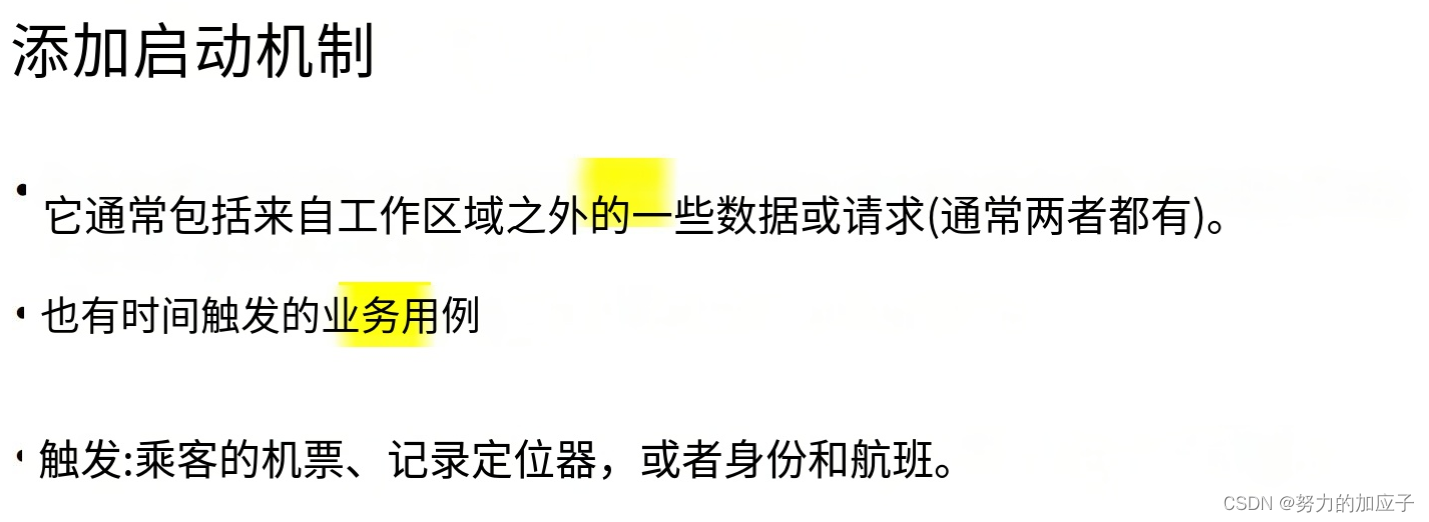


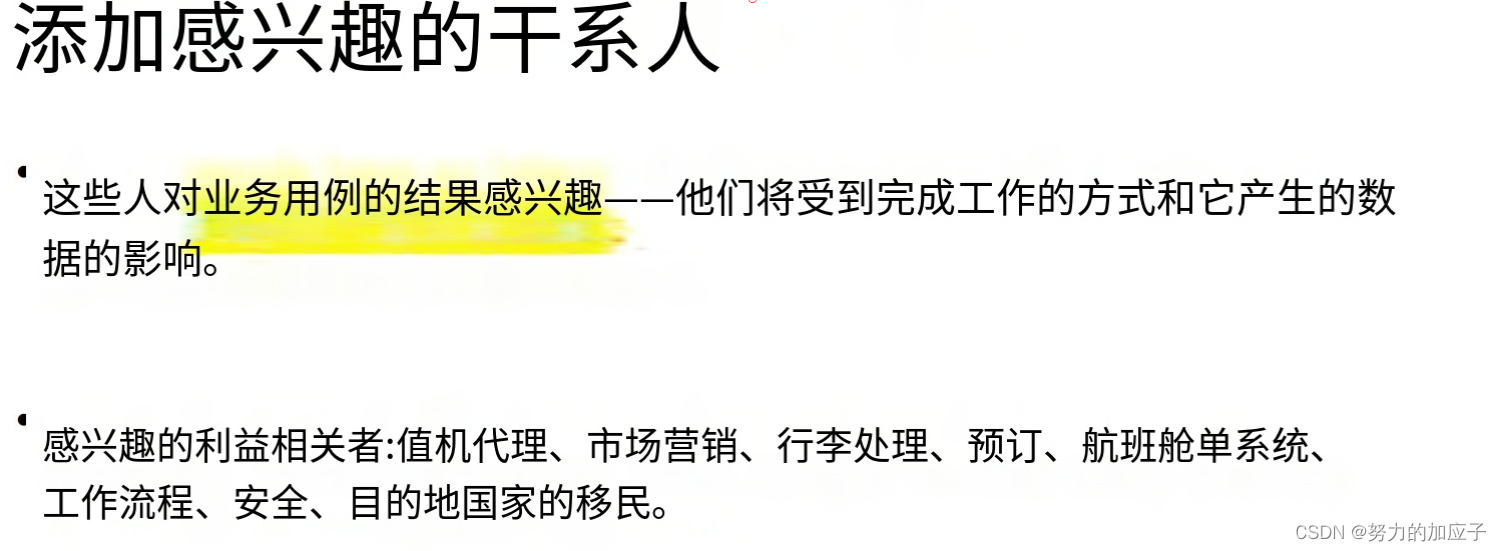

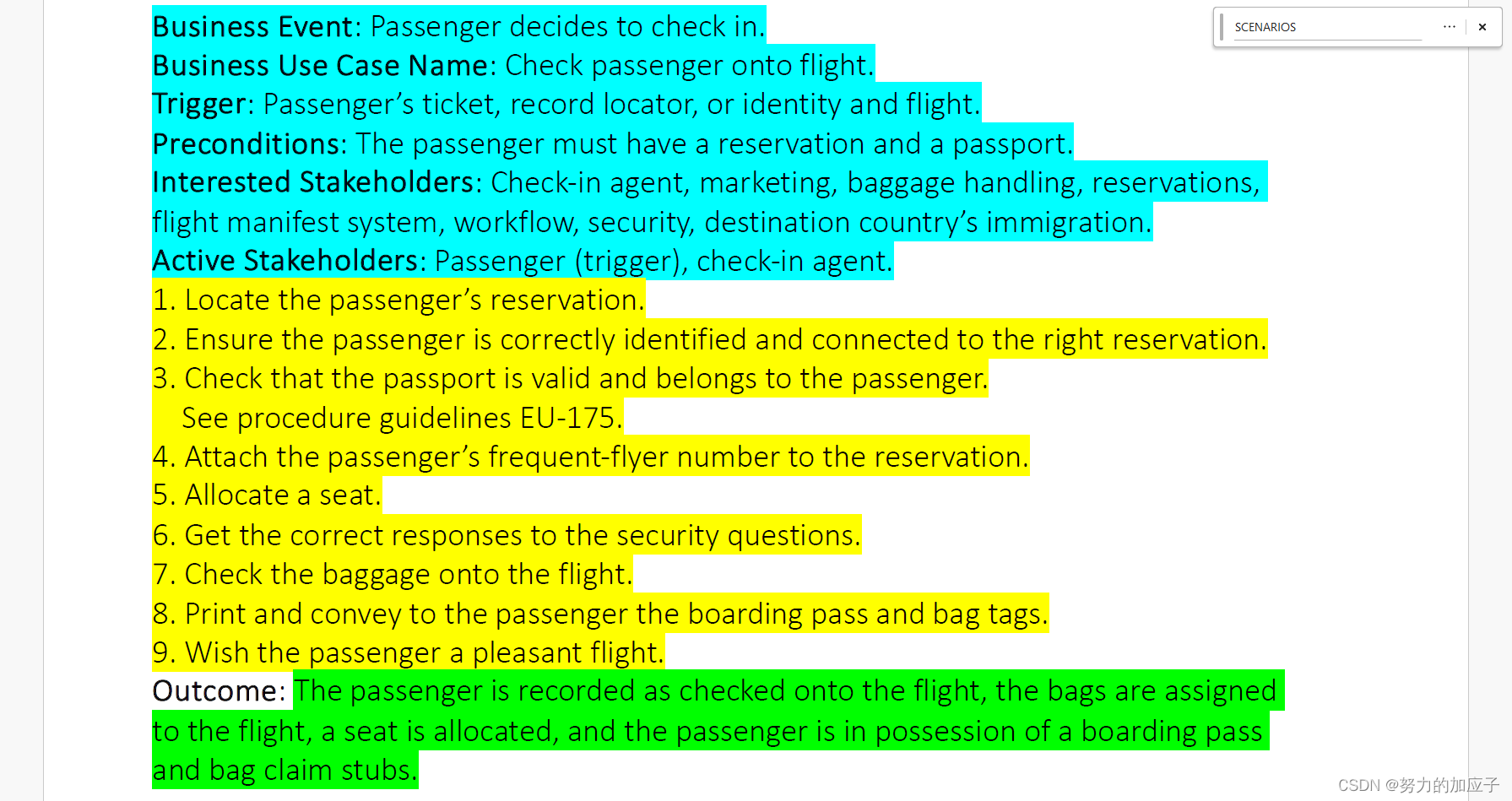
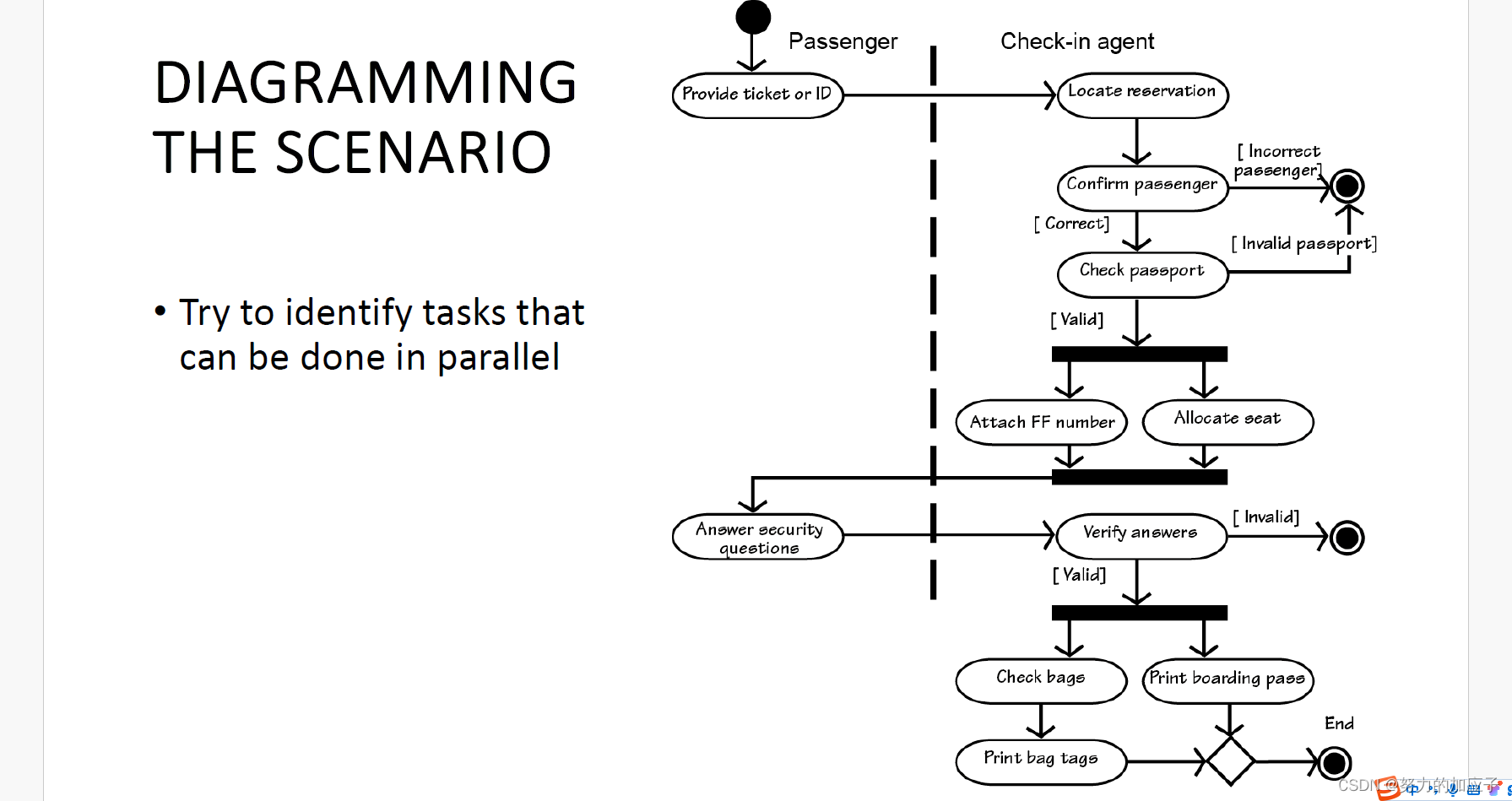
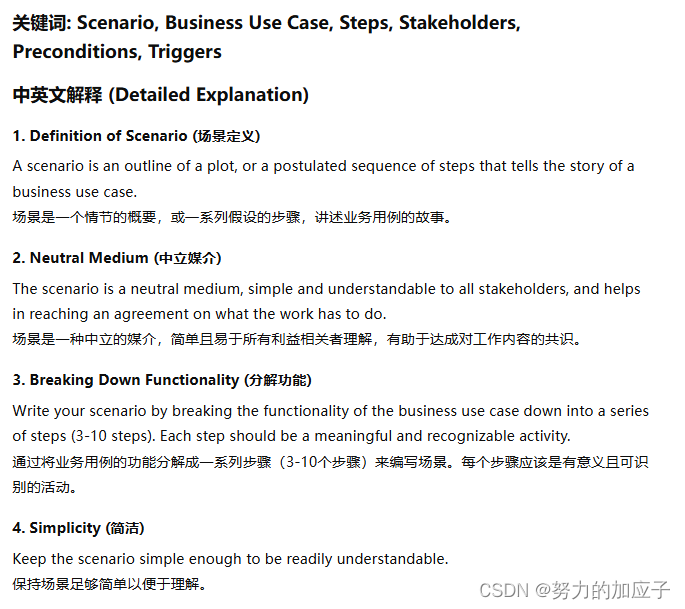
@startmindmap
* Scenario Content / 场景内容
** Definition / 定义
*** Outline of a plot or sequence of steps / 情节或步骤序列的概要
** Neutral Medium / 中立媒介
*** Simple and understandable to stakeholders / 简单且易于利益相关者理解
** Breaking Down Functionality / 分解功能
*** Series of steps (3-10 steps) / 一系列步骤(3-10步骤)
** Simplicity / 简洁
*** Keep it simple and understandable / 保持简洁易懂
** Example Scenario / 示例场景
*** Business Use Case: Check passenger onto flight / 业务用例:将乘客登记到航班
*** Trigger: Passenger’s ticket, record locator, or identity and flight / 触发器:乘客的票、记录定位符或身份和航班
*** Preconditions: Reservation and passport / 预条件:预订和护照
*** Steps / 步骤
**** Get the passenger’s ticket or record locator / 获取乘客的票或记录定位符
**** Check passenger, flight, and destination / 检查乘客、航班和目的地
**** Check passport validity / 检查护照有效性
**** Record frequent-flyer number / 记录常旅客号码
**** Find a seat / 找到座位
**** Ask security questions / 问安全问题
**** Check baggage / 托运行李
**** Print and hand over boarding pass and bag tags / 打印并交付登机牌和行李标签
**** “Have a nice flight” / 祝您旅途愉快
** Stakeholders / 利益相关者
*** Interested Stakeholders / 相关利益相关者
**** Check-in agent, marketing, baggage handling, reservations, flight manifest system, workflow, security, immigration / 办理登机手续的代理、市场营销、行李处理、预订、航班清单系统、工作流、安全、移民
*** Active Stakeholders / 活跃利益相关者
**** Passenger (trigger), check-in agent / 乘客(触发器)、办理登机手续的代理
@endmindmap
15

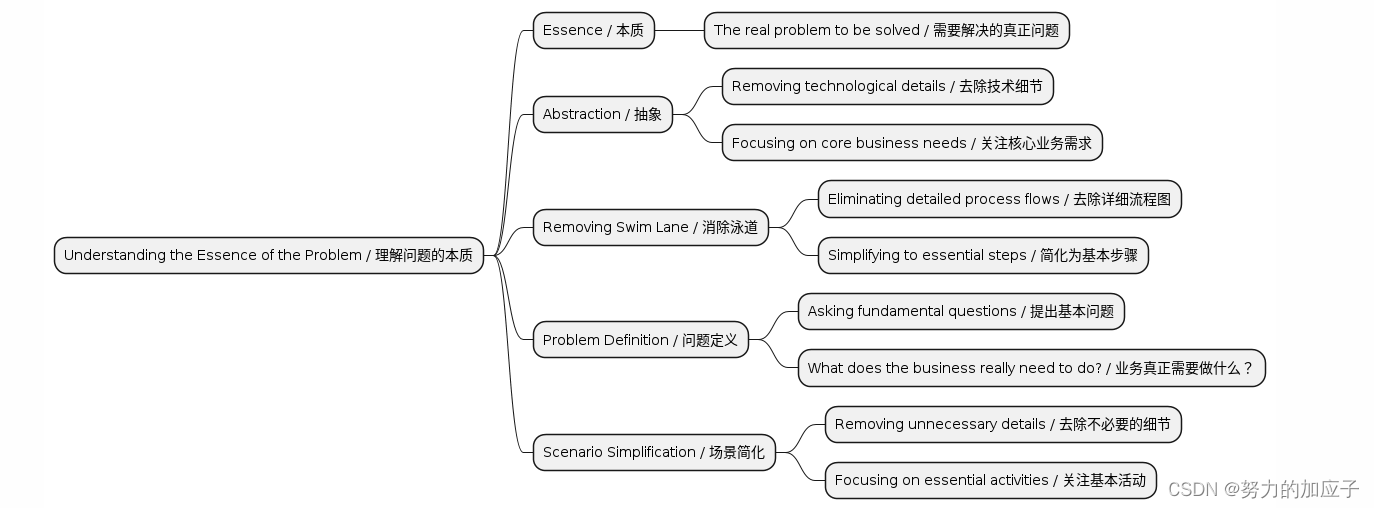
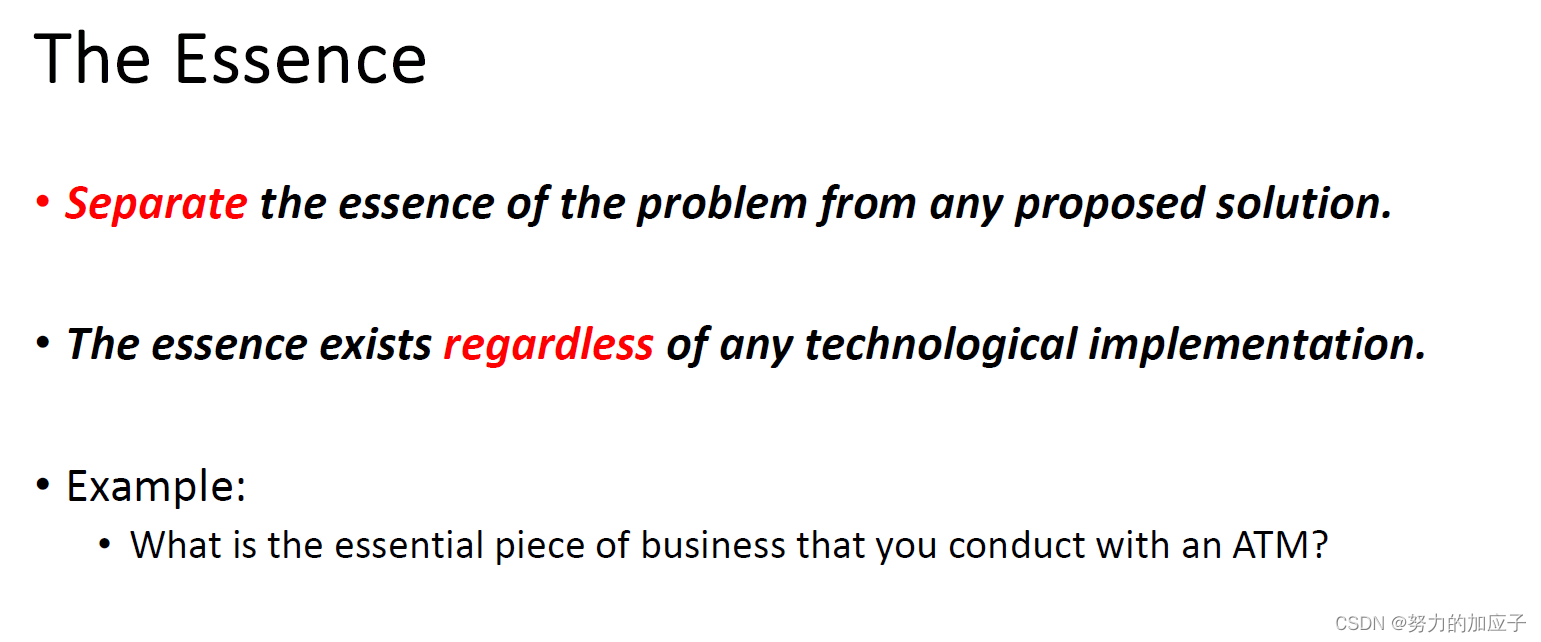
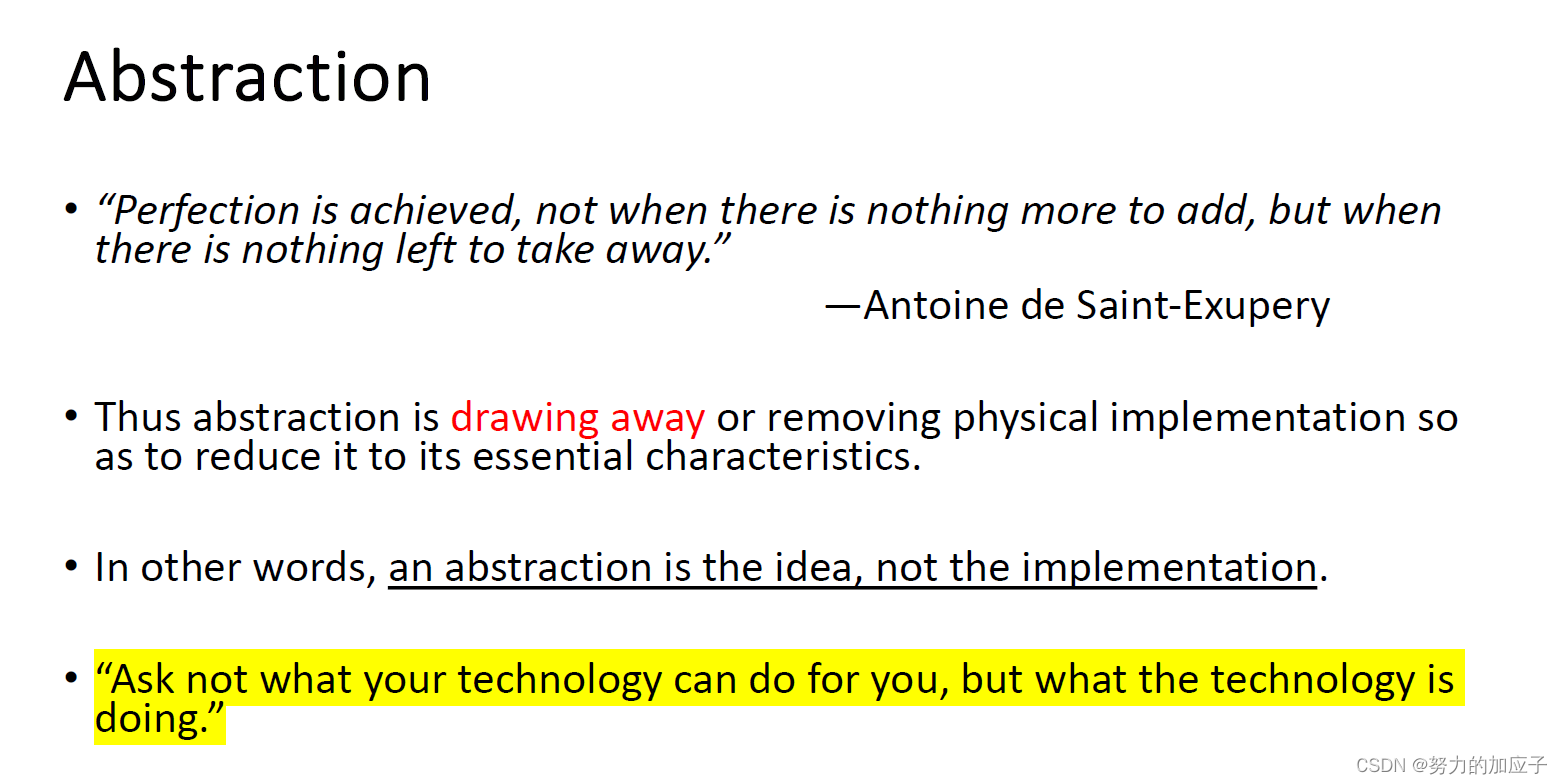
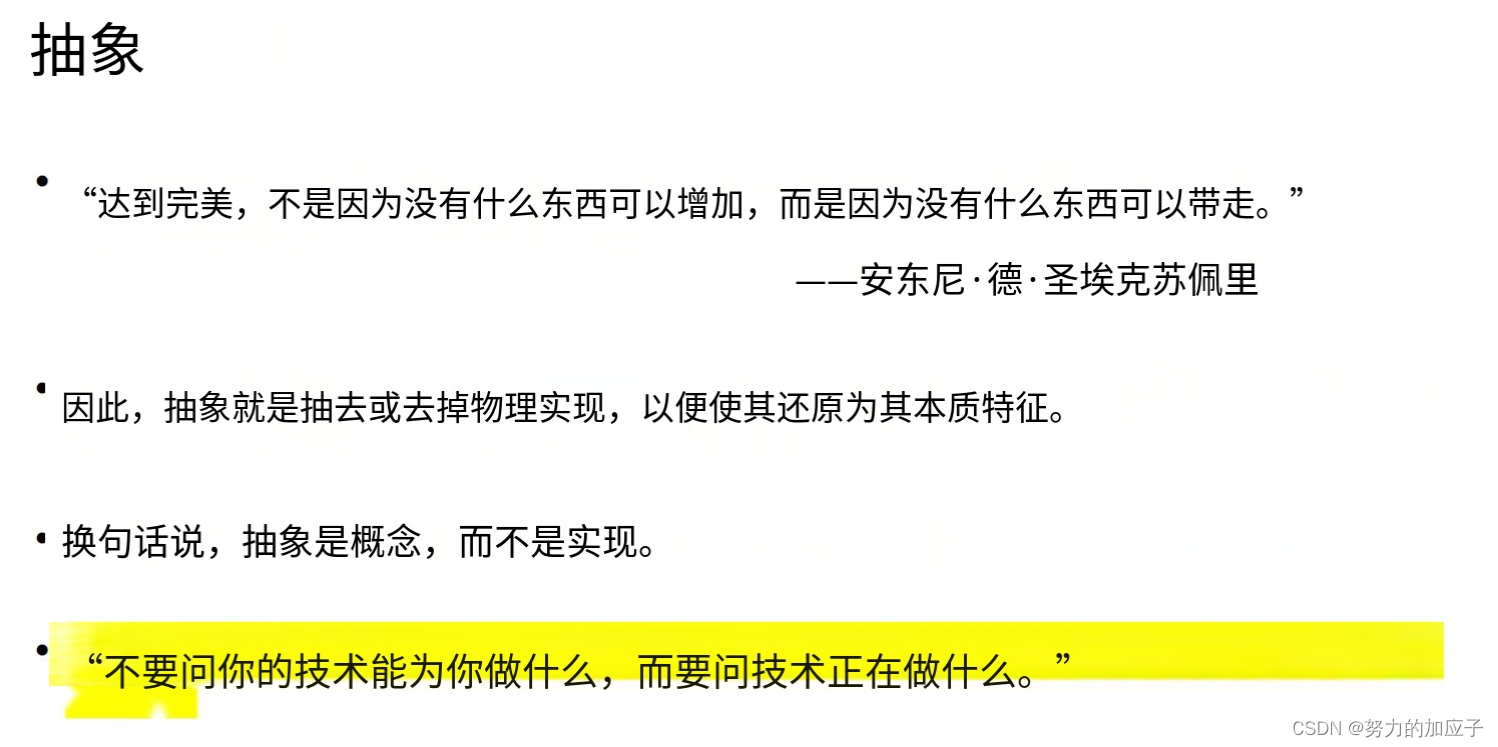


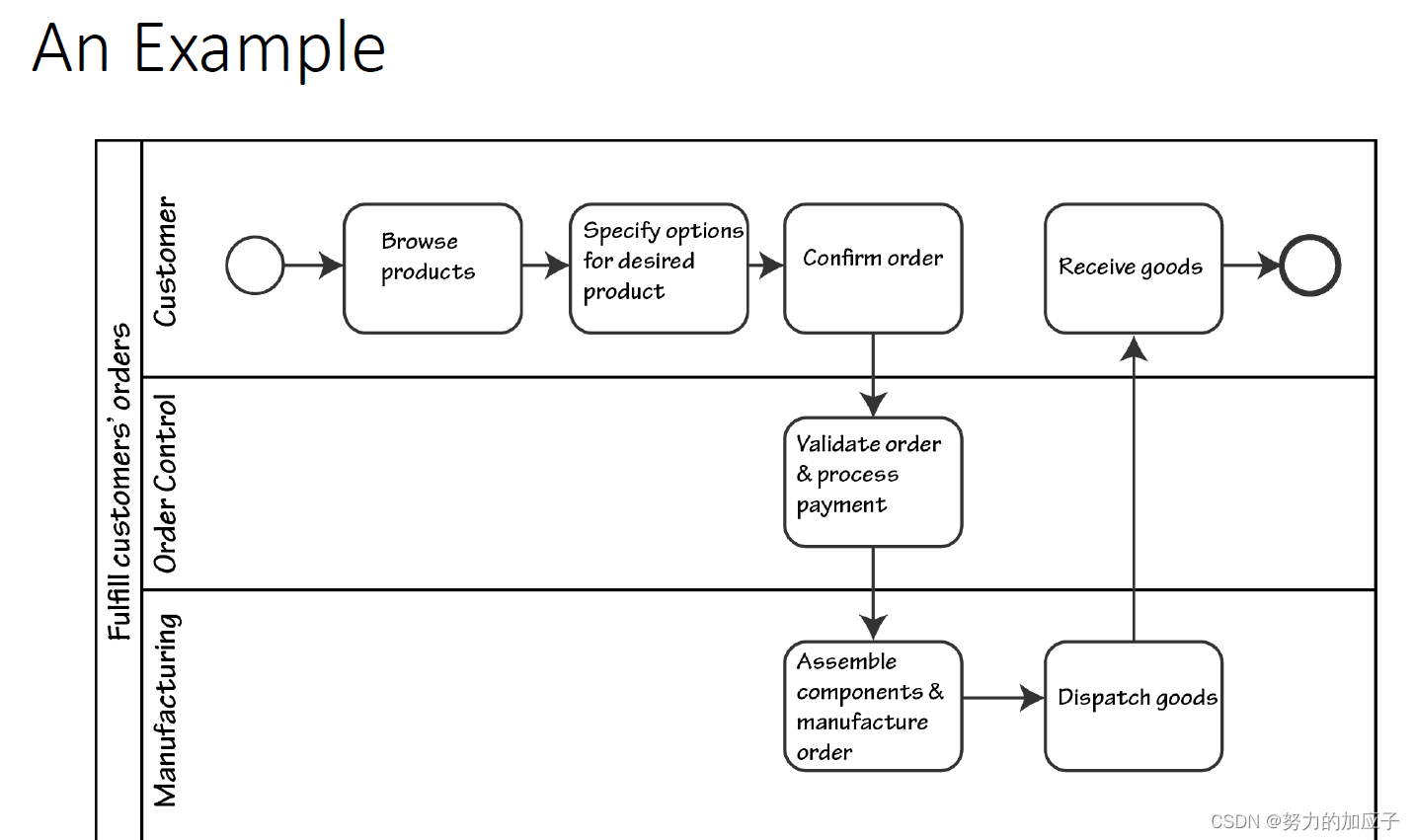
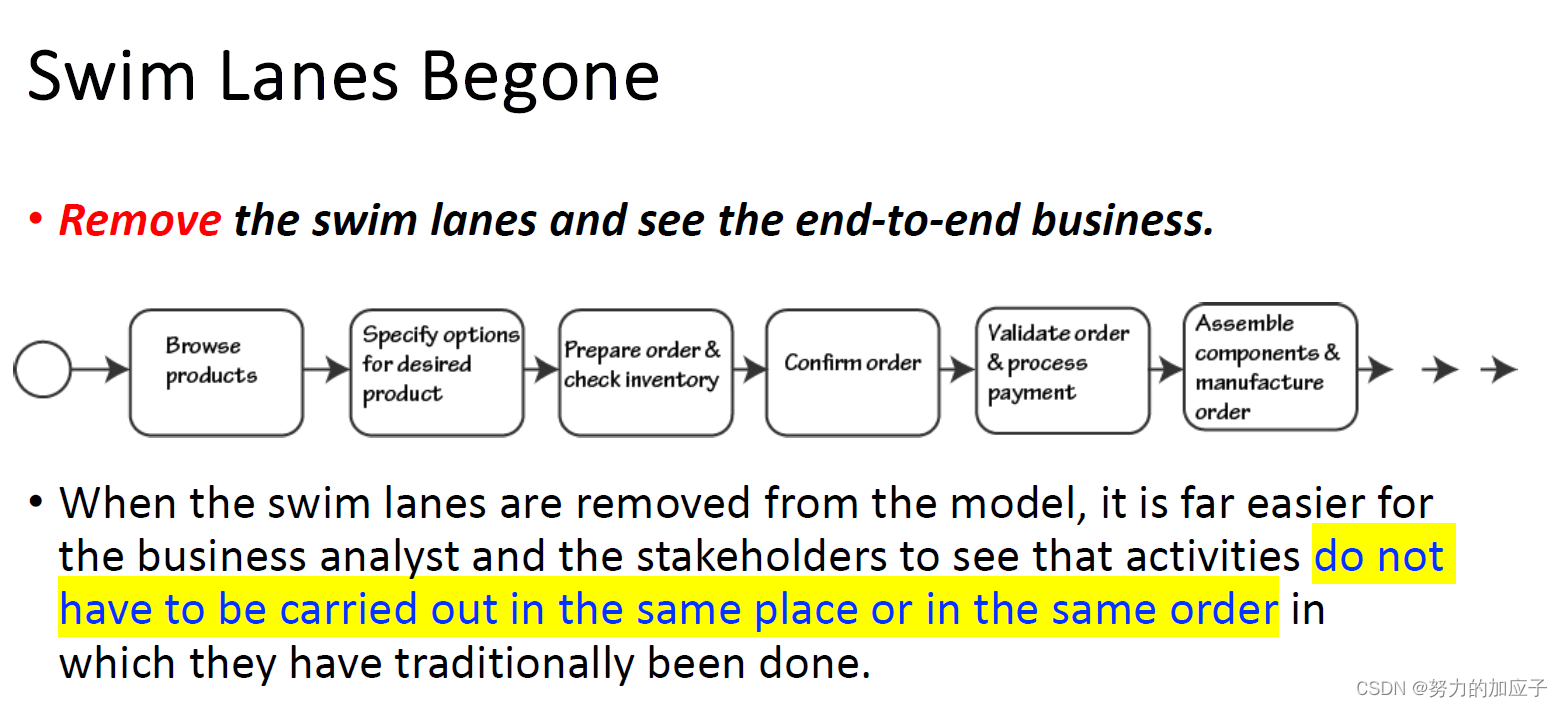
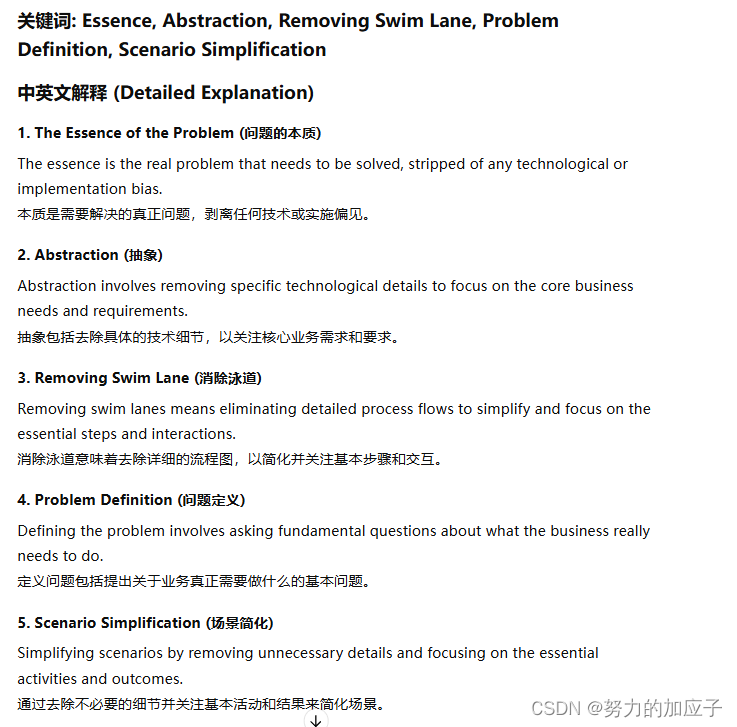

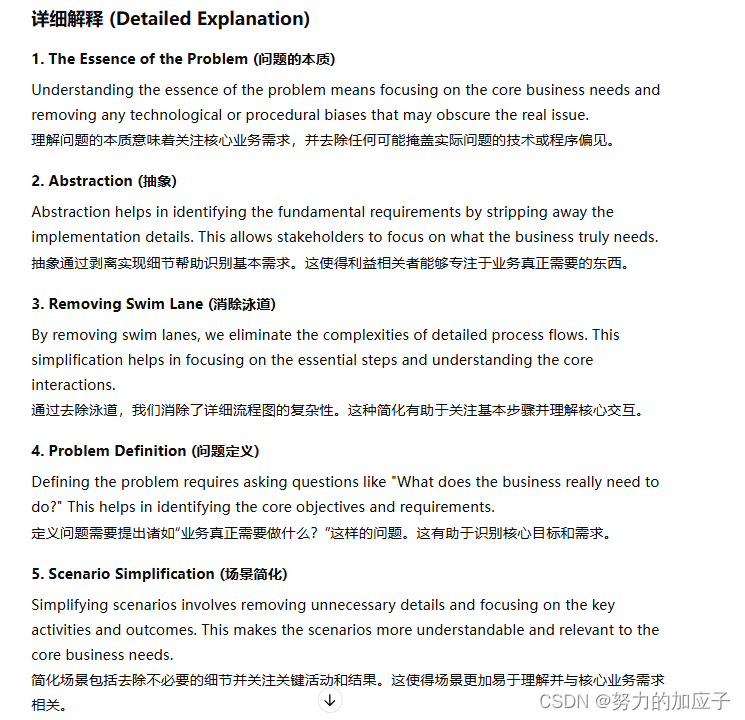

@startmindmap
* Understanding the Essence of the Problem / 理解问题的本质
** Essence / 本质
*** The real problem to be solved / 需要解决的真正问题
** Abstraction / 抽象
*** Removing technological details / 去除技术细节
*** Focusing on core business needs / 关注核心业务需求
** Removing Swim Lane / 消除泳道
*** Eliminating detailed process flows / 去除详细流程图
*** Simplifying to essential steps / 简化为基本步骤
** Problem Definition / 问题定义
*** Asking fundamental questions / 提出基本问题
*** What does the business really need to do? / 业务真正需要做什么?
** Scenario Simplification / 场景简化
*** Removing unnecessary details / 去除不必要的细节
*** Focusing on essential activities / 关注基本活动
@endmindmap
16


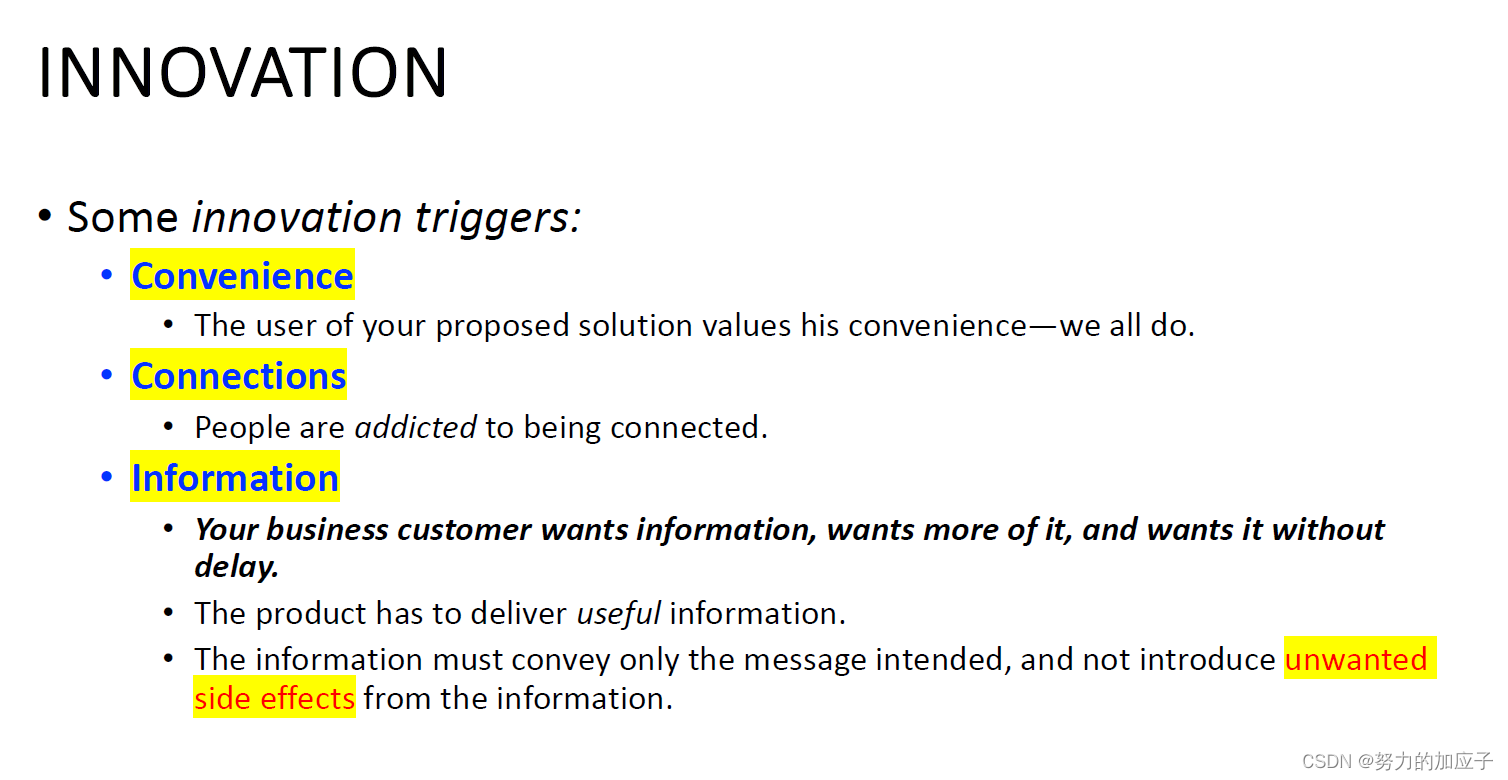
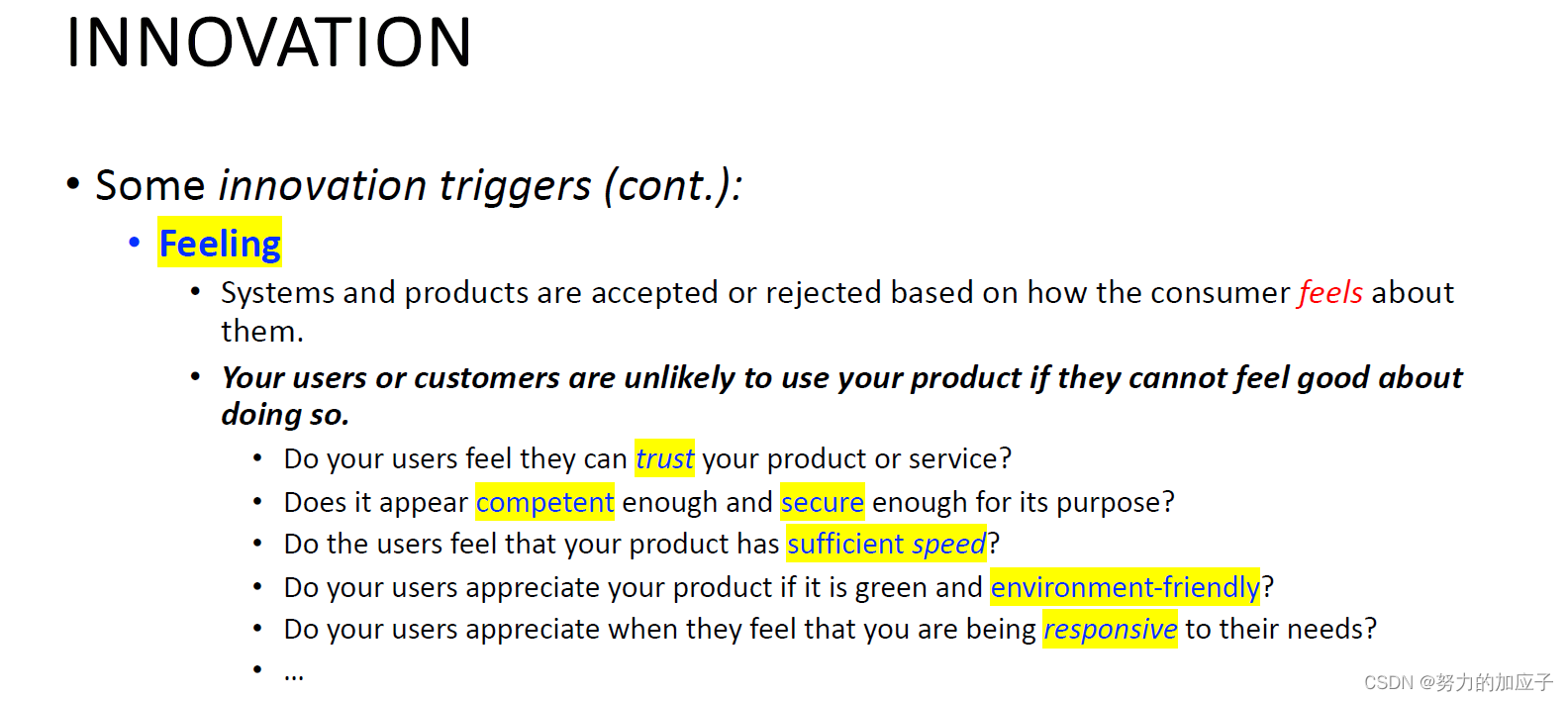
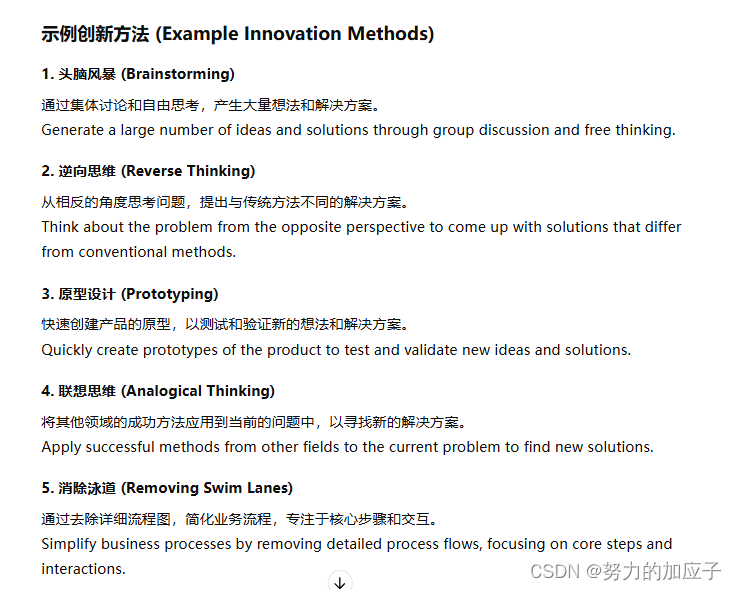
@startmindmap
* Understanding Innovation / 理解创新
** Innovation / 创新
*** Introducing new ideas, methods, or products / 引入新想法、方法或产品
** Essence / 本质
*** Understanding core needs and goals / 理解核心需求和目标
** Abstraction / 抽象
*** Extracting core concepts from implementations / 从实现中提取核心概念
** Problem Solving / 解决问题
*** Finding new solutions to existing problems / 寻找现有问题的新解决方案
** Creativity / 创造力
*** Encouraging free thinking and diverse perspectives / 鼓励自由思考和不同观点
** Innovation Methods / 创新方法
*** Brainstorming / 头脑风暴
*** Reverse Thinking / 逆向思维
*** Prototyping / 原型设计
*** Analogical Thinking / 联想思维
*** Removing Swim Lanes / 消除泳道
@endmindmap
17


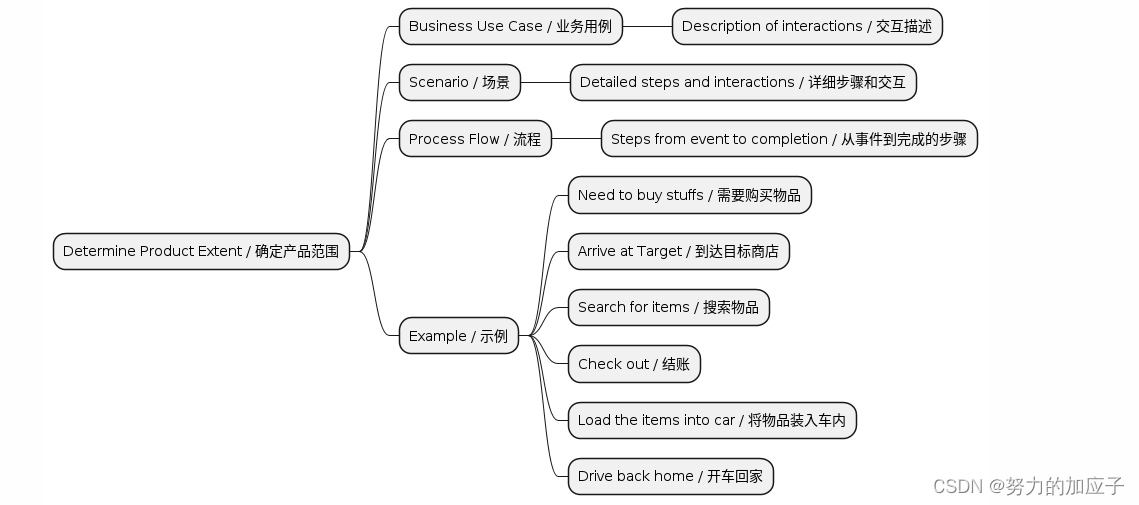
18

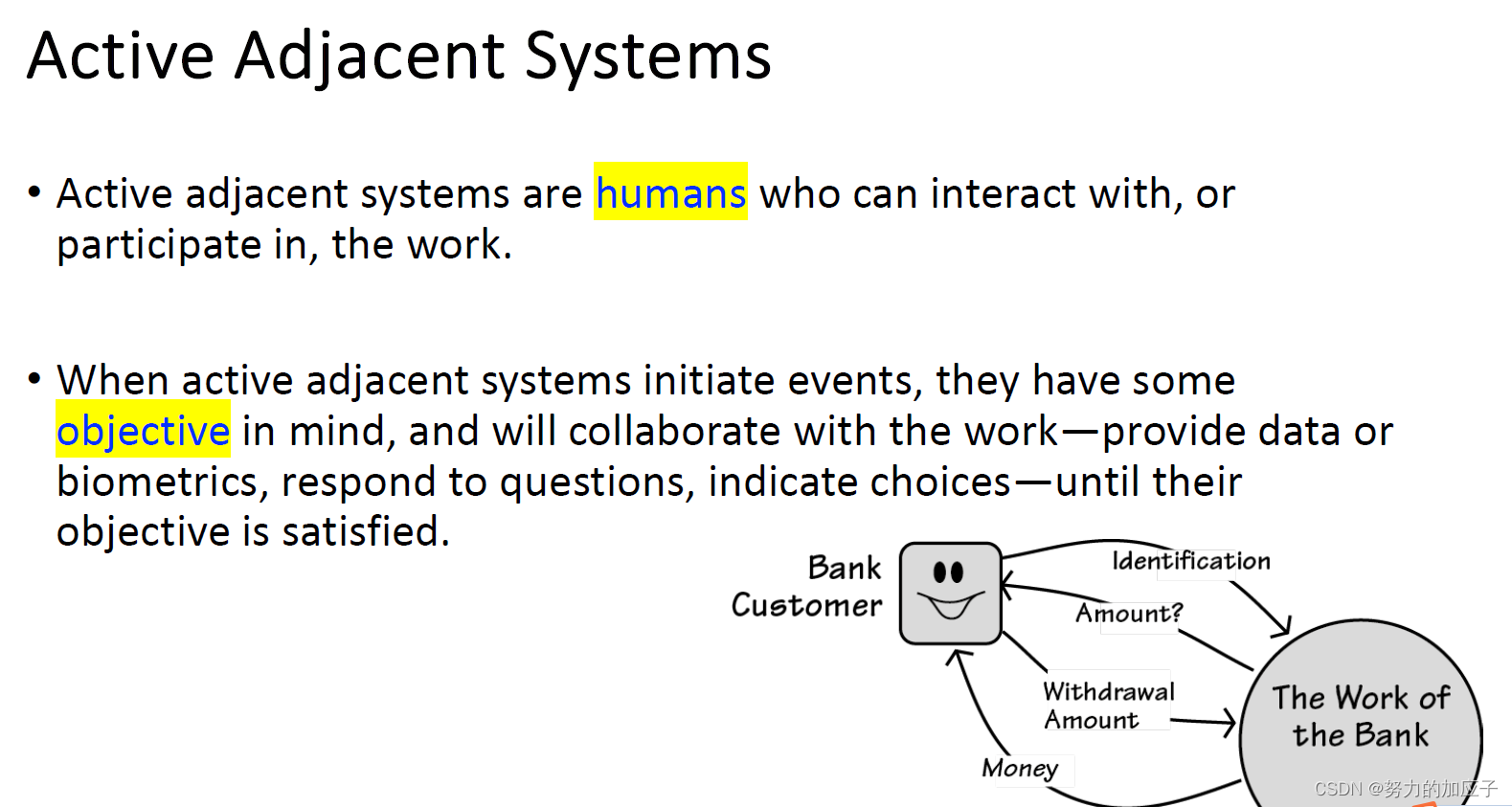
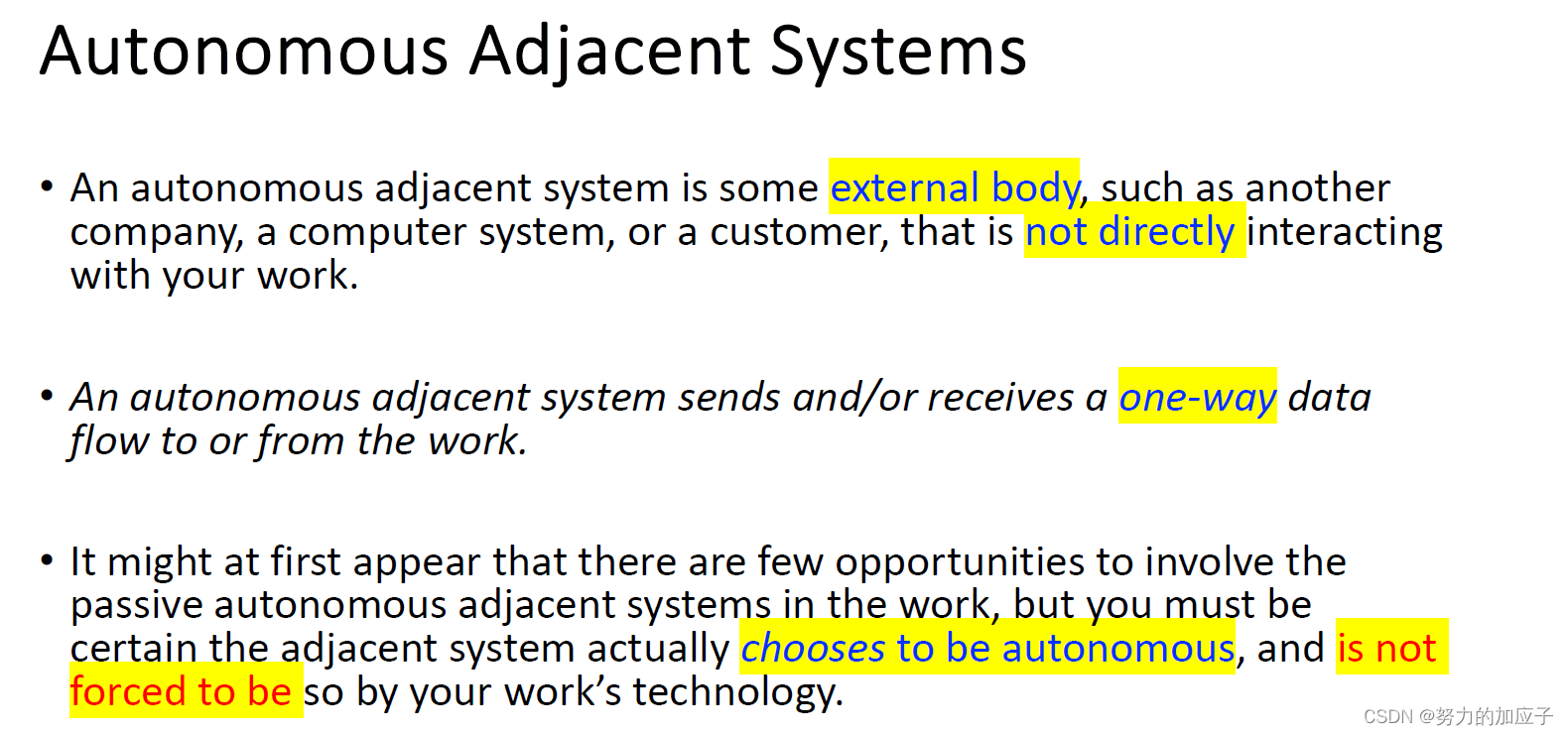

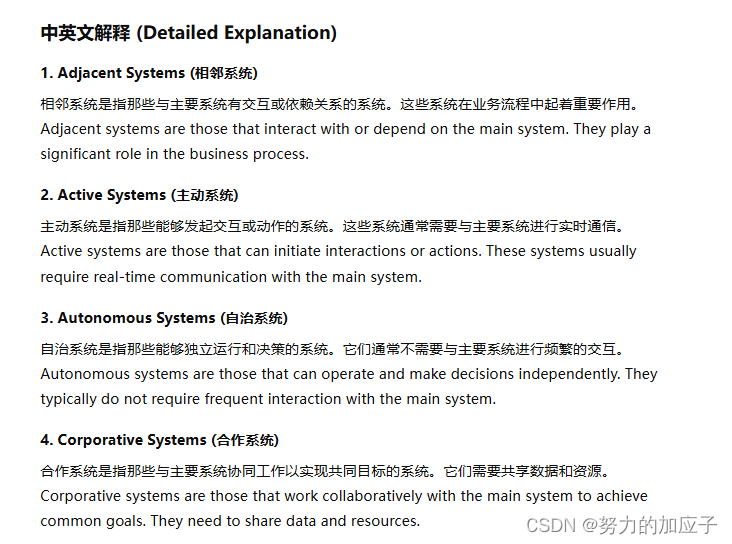


@startmindmap
* Types of Adjacent Systems / 相邻系统类型
** Adjacent Systems / 相邻系统
*** Interact with or depend on the main system / 与主要系统交互或依赖主要系统
** Active Systems / 主动系统
*** Can initiate interactions or actions / 能发起交互或动作
*** Example / 示例: Customer management system / 客户管理系统
** Autonomous Systems / 自治系统
*** Operate and make decisions independently / 独立运行和决策
*** Example / 示例: Automated inventory management system / 自动化库存管理系统
** Corporative Systems / 合作系统
*** Work collaboratively with the main system / 与主要系统协同工作
*** Share data and resources / 共享数据和资源
*** Example / 示例: Financial system integrated with ERP / 与ERP集成的财务系统
@endmindmap
19

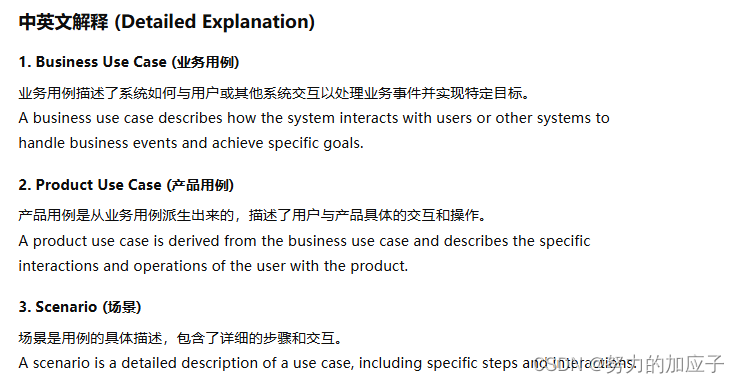
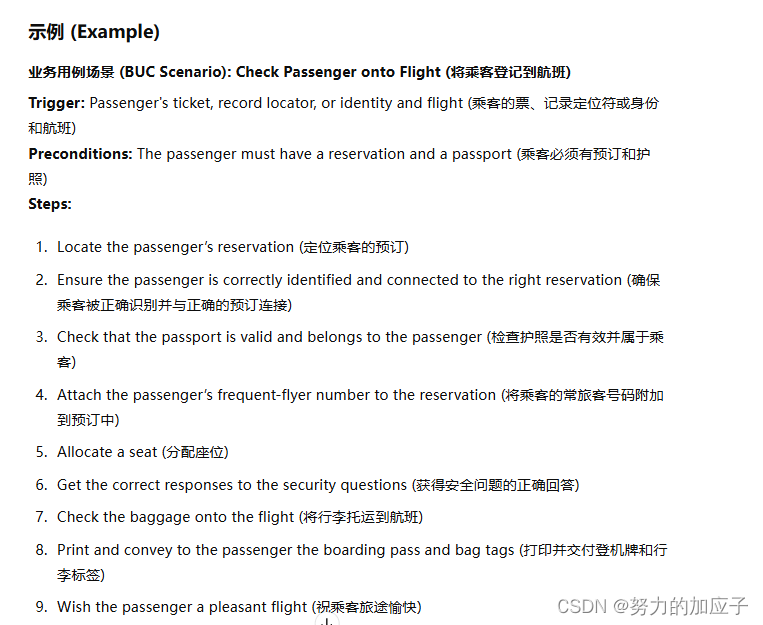
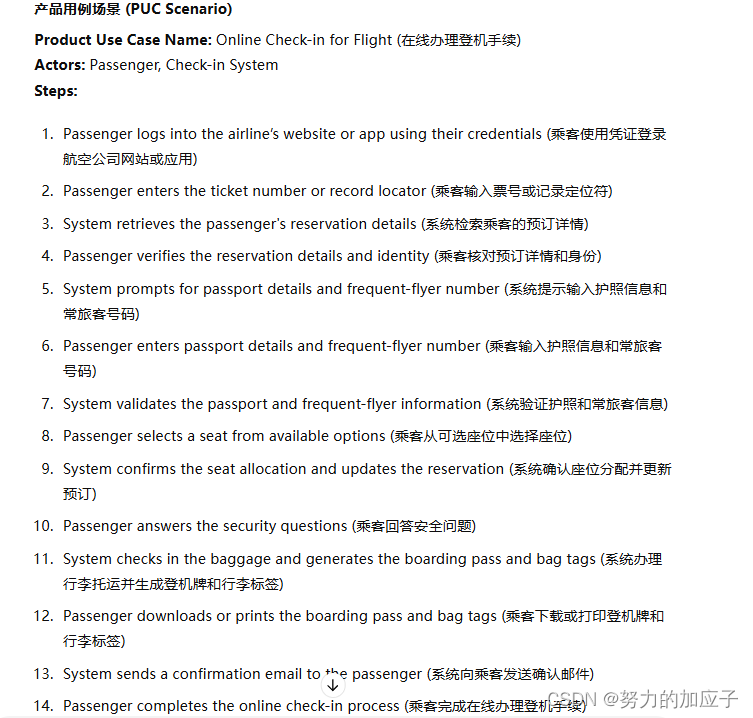

@startmindmap
* Writing PUC Scenario from BUC Scenario / 从业务用例场景编写产品用例场景
** Business Use Case (BUC) / 业务用例
*** Describes system interactions to achieve goals / 描述系统交互以实现目标
*** Example / 示例: Check Passenger onto Flight / 将乘客登记到航班
** Product Use Case (PUC) / 产品用例
*** Derived from BUC, focuses on user-product interactions / 从业务用例派生,关注用户与产品的交互
*** Example / 示例: Online Check-in for Flight / 在线办理登机手续
** Scenario / 场景
*** Detailed steps and interactions / 详细步骤和交互
** Steps / 步骤
*** Translate BUC steps into PUC steps / 将业务用例步骤转化为产品用例步骤
*** Example Steps / 示例步骤
**** BUC Step: Locate the passenger’s reservation / 定位乘客的预订
**** PUC Step: System retrieves reservation details / 系统检索预订详情
**** BUC Step: Ensure the passenger is identified / 确保乘客被识别
**** PUC Step: Passenger verifies details online / 乘客在线核对详情
@endmindmap
20
![]()
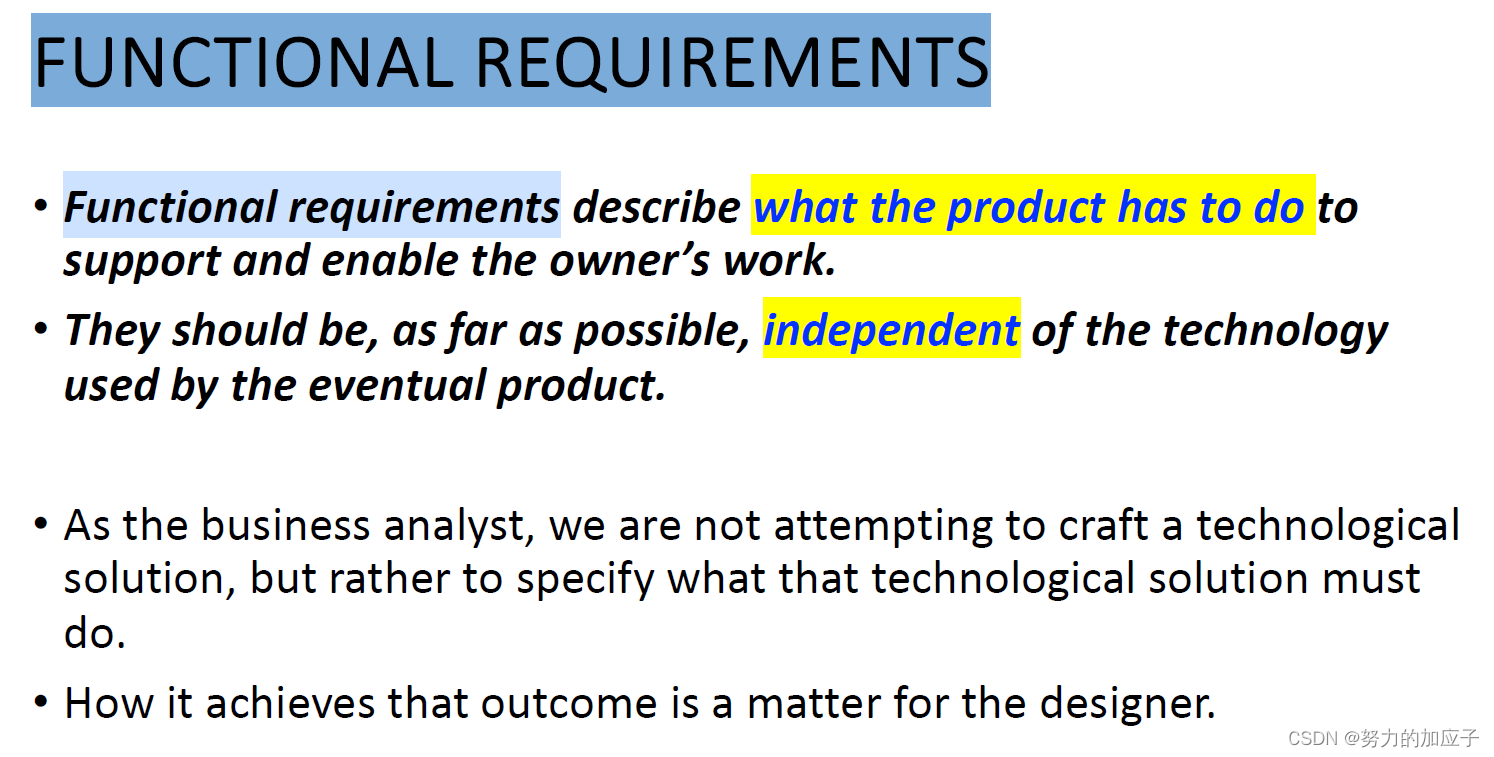
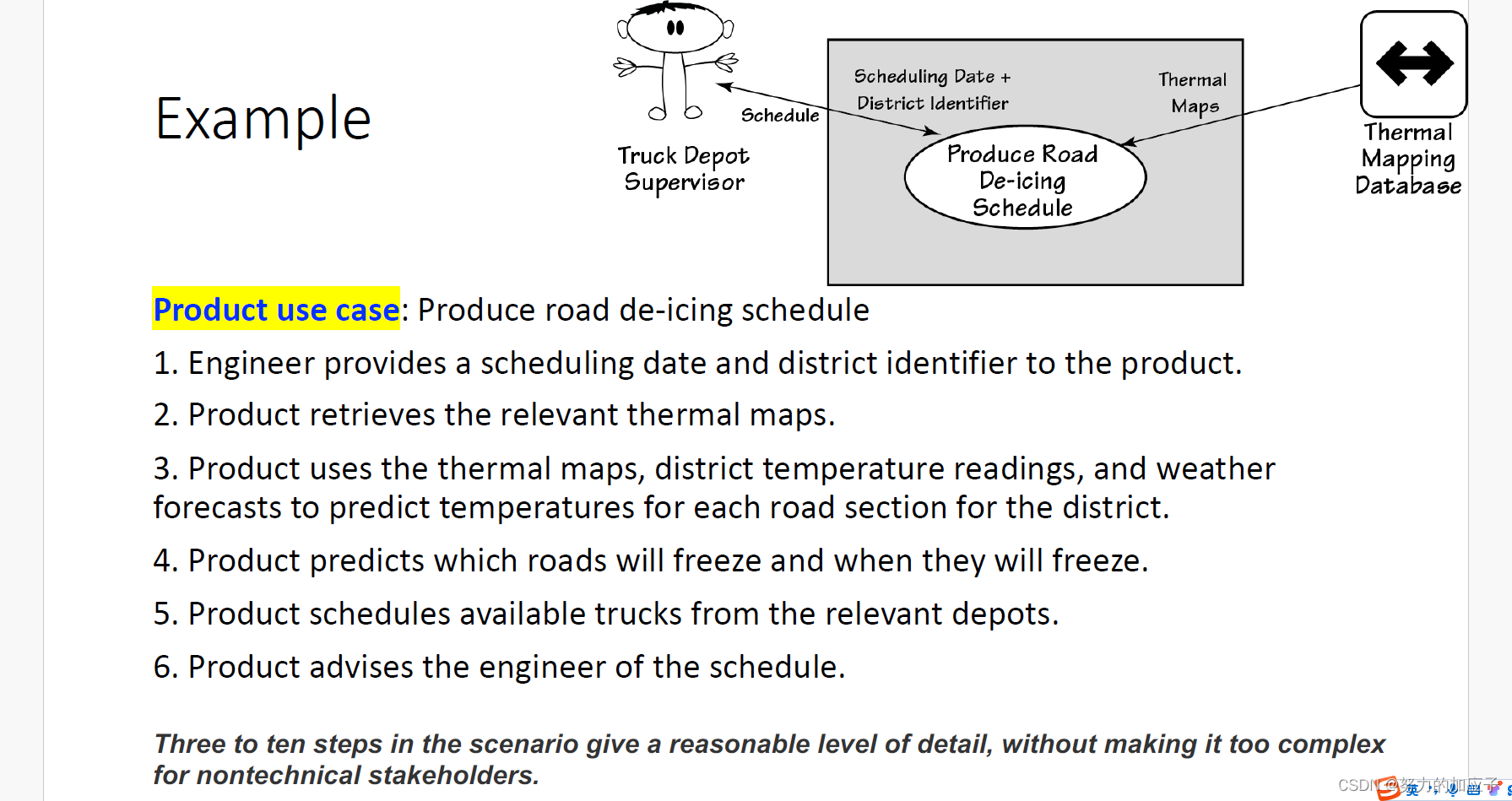
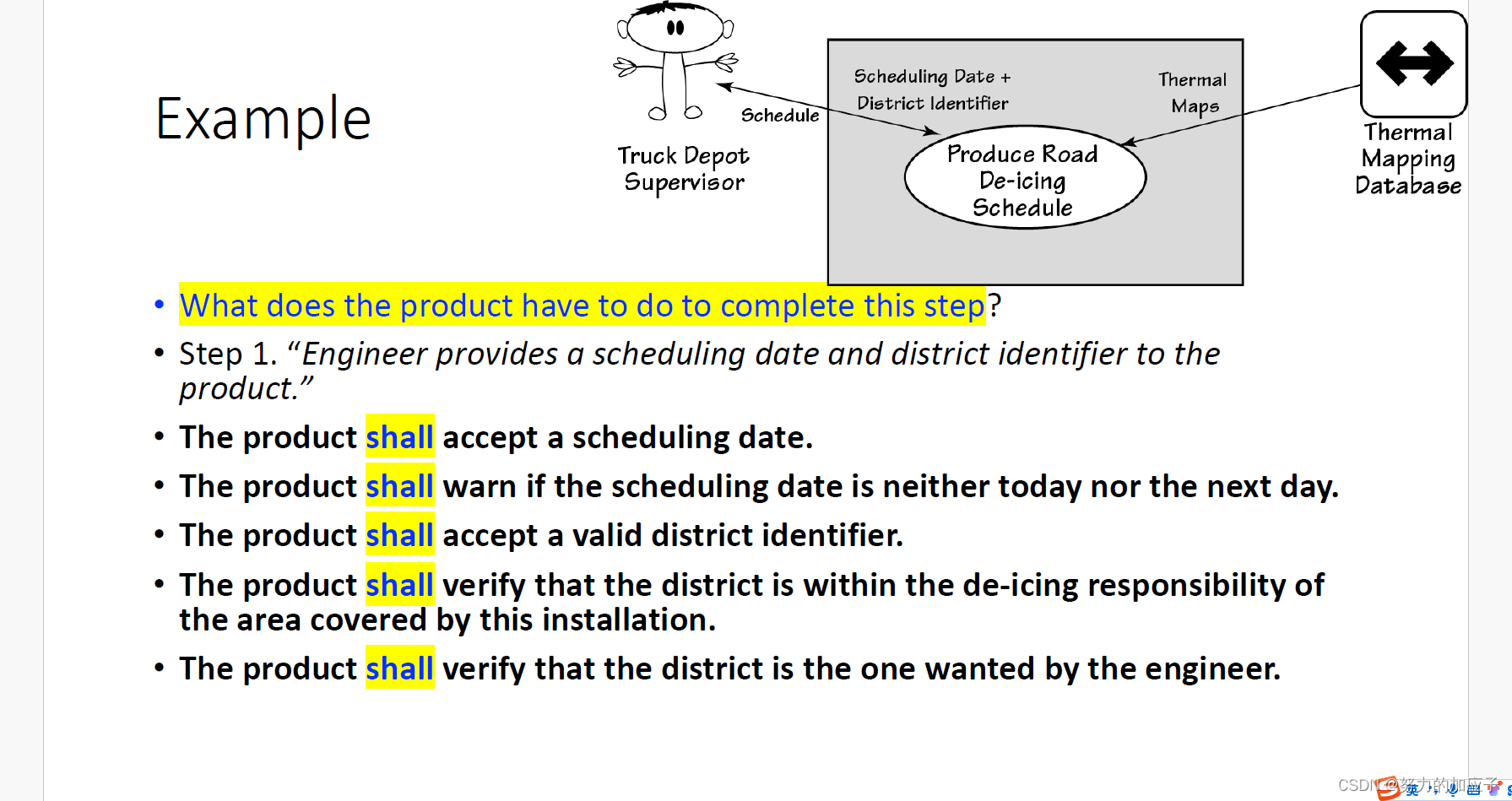
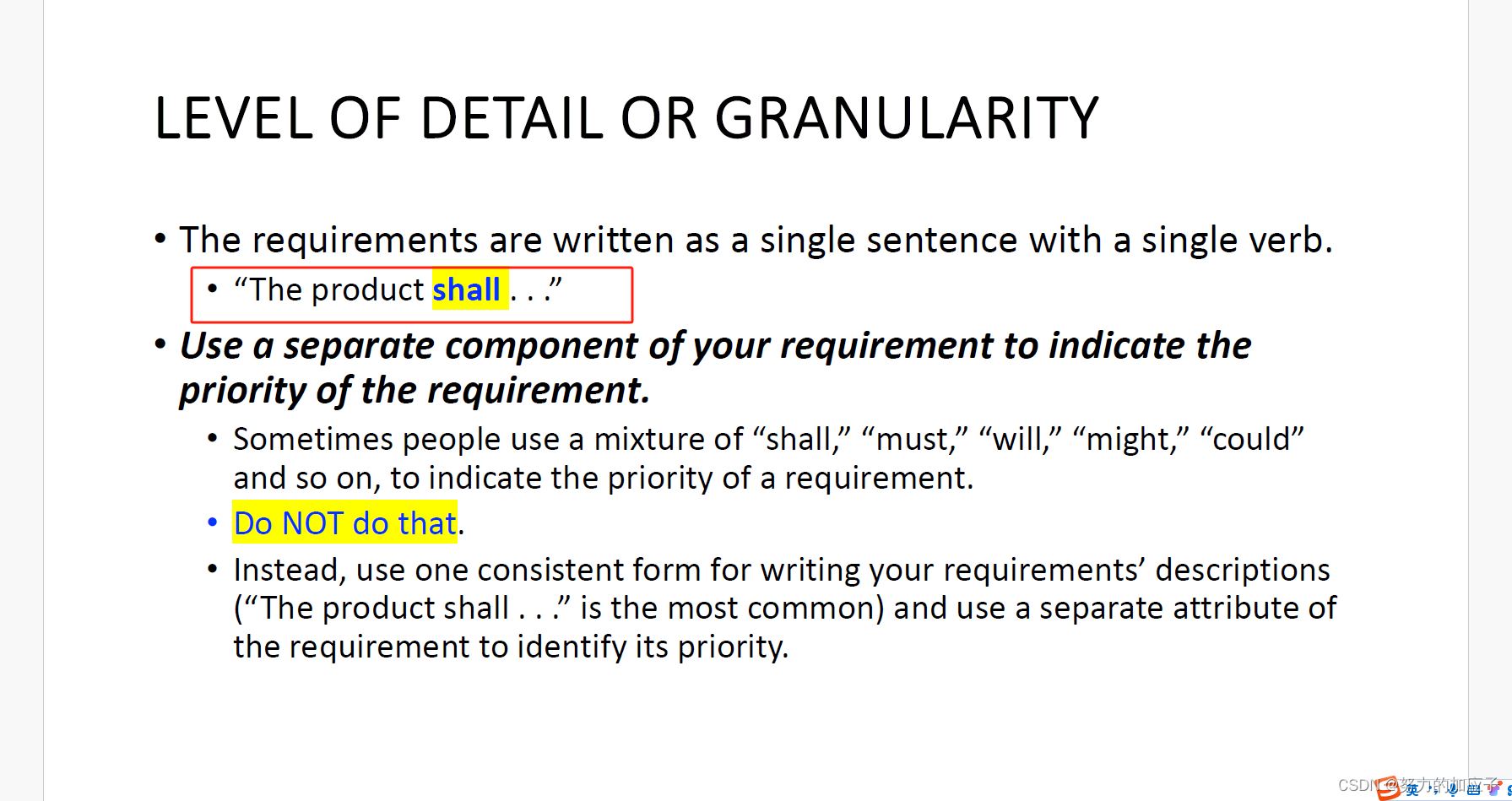
21

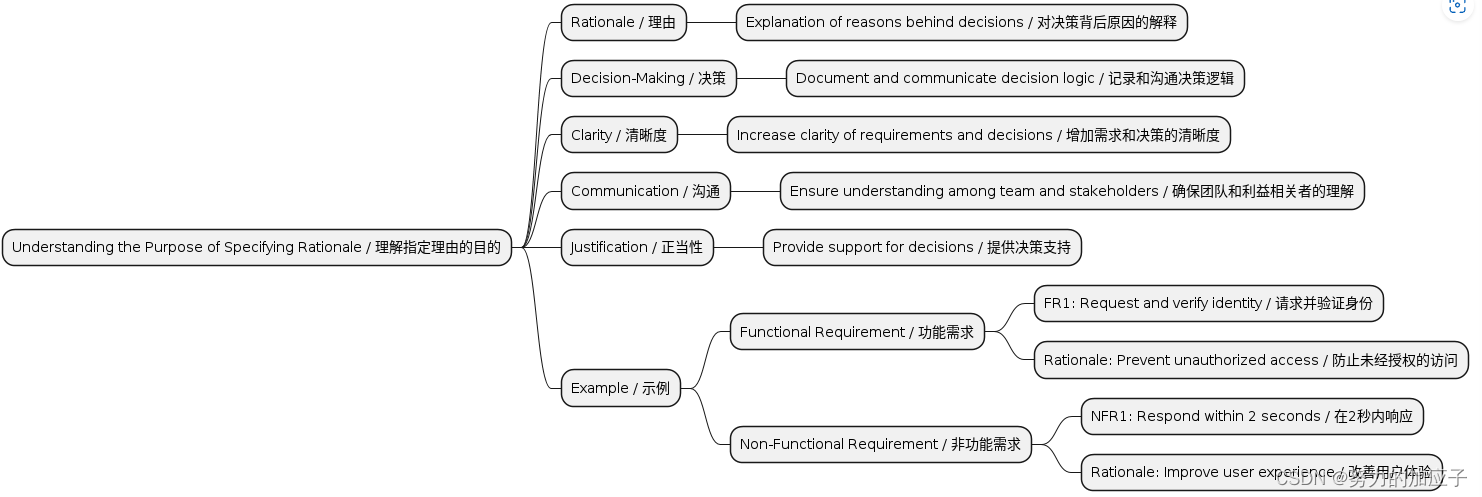
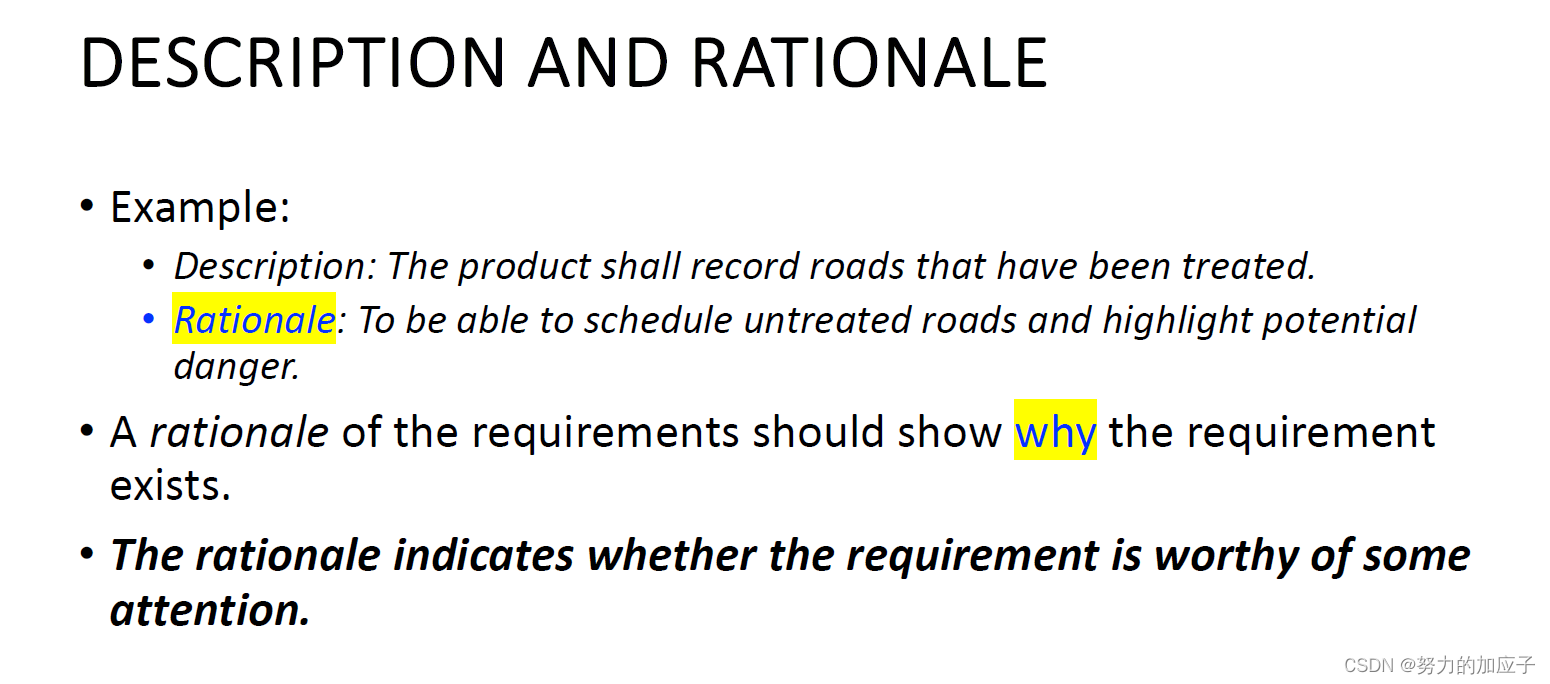
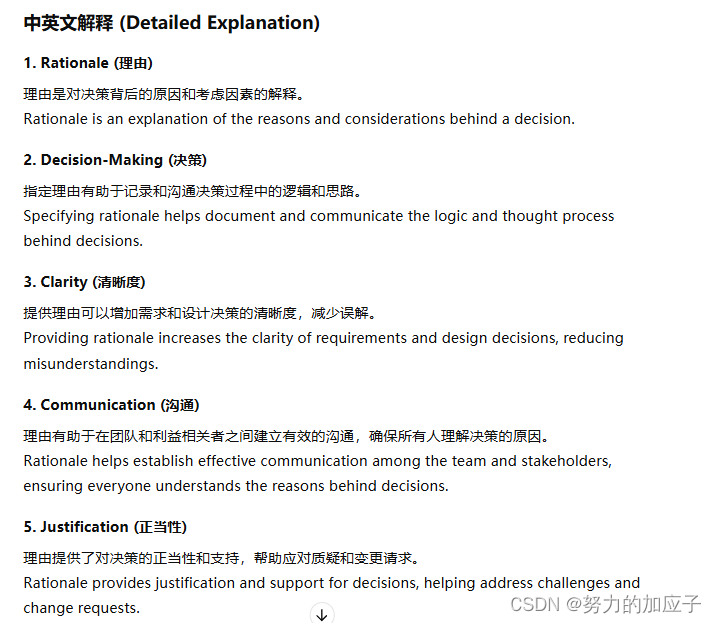

22
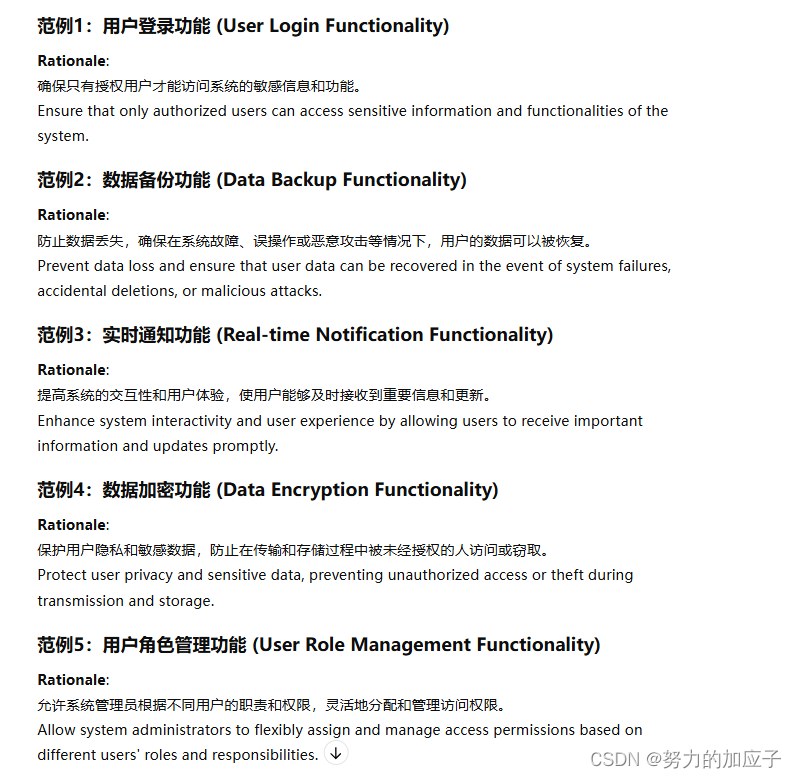
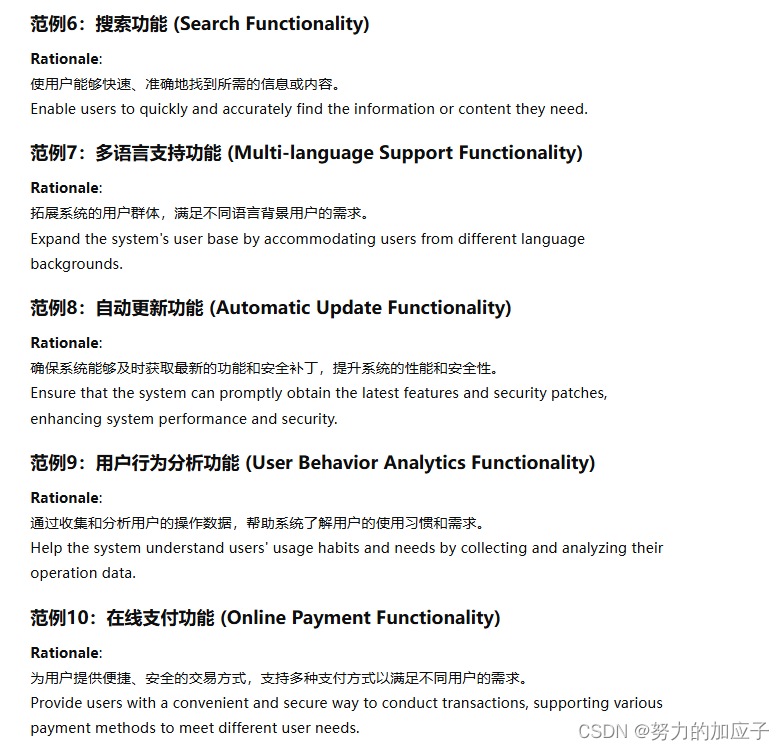
23
![]()
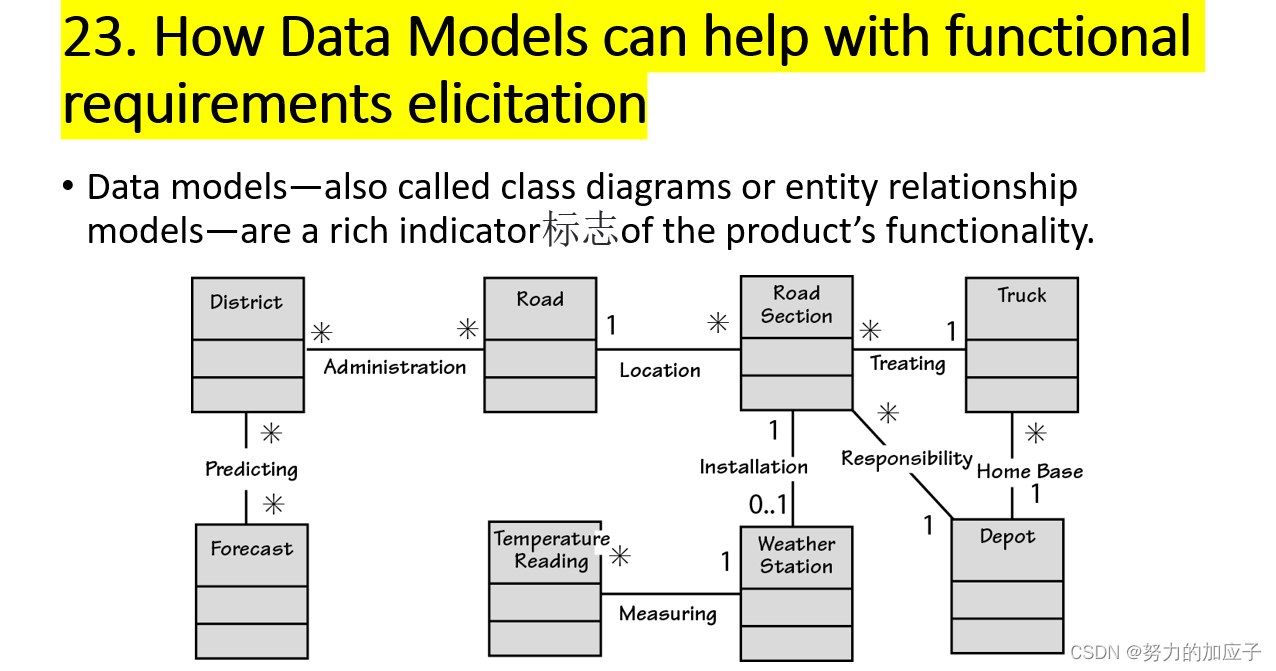

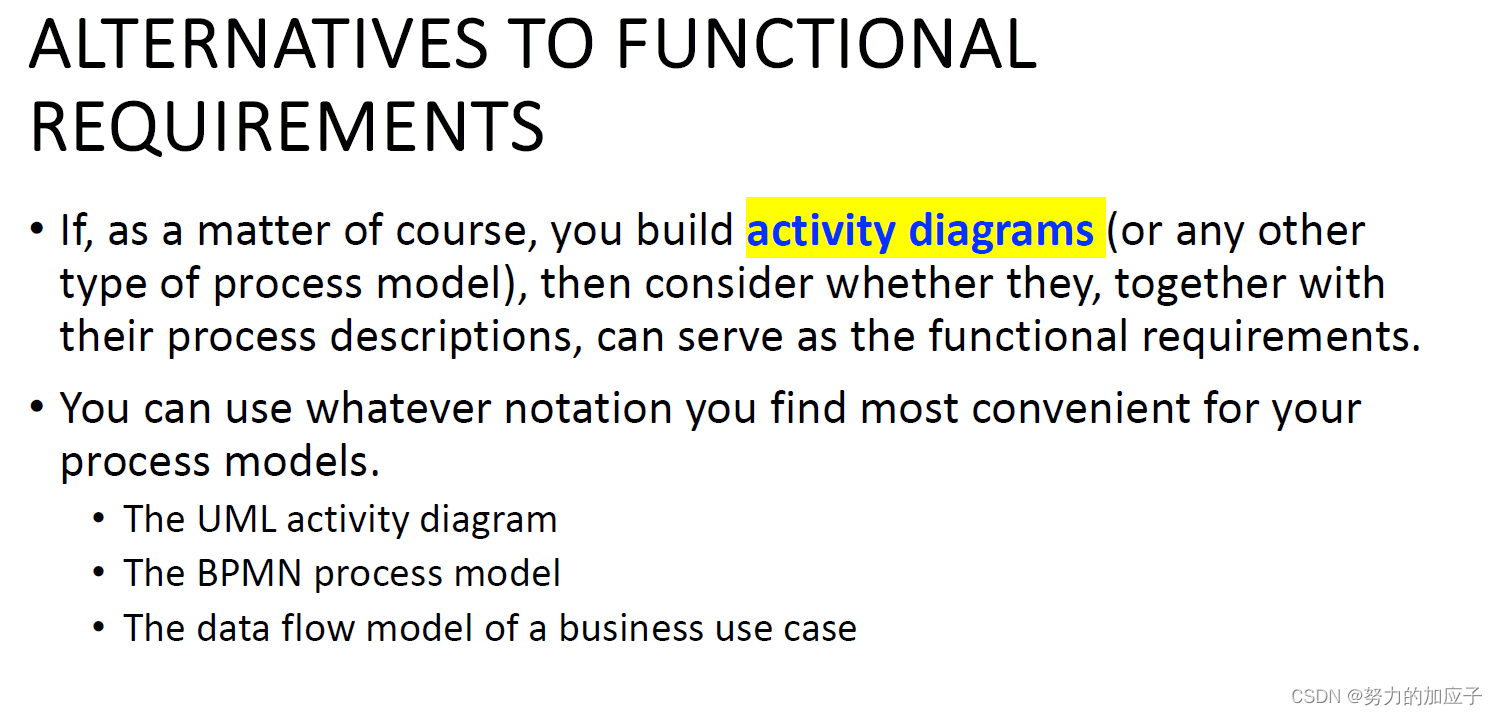
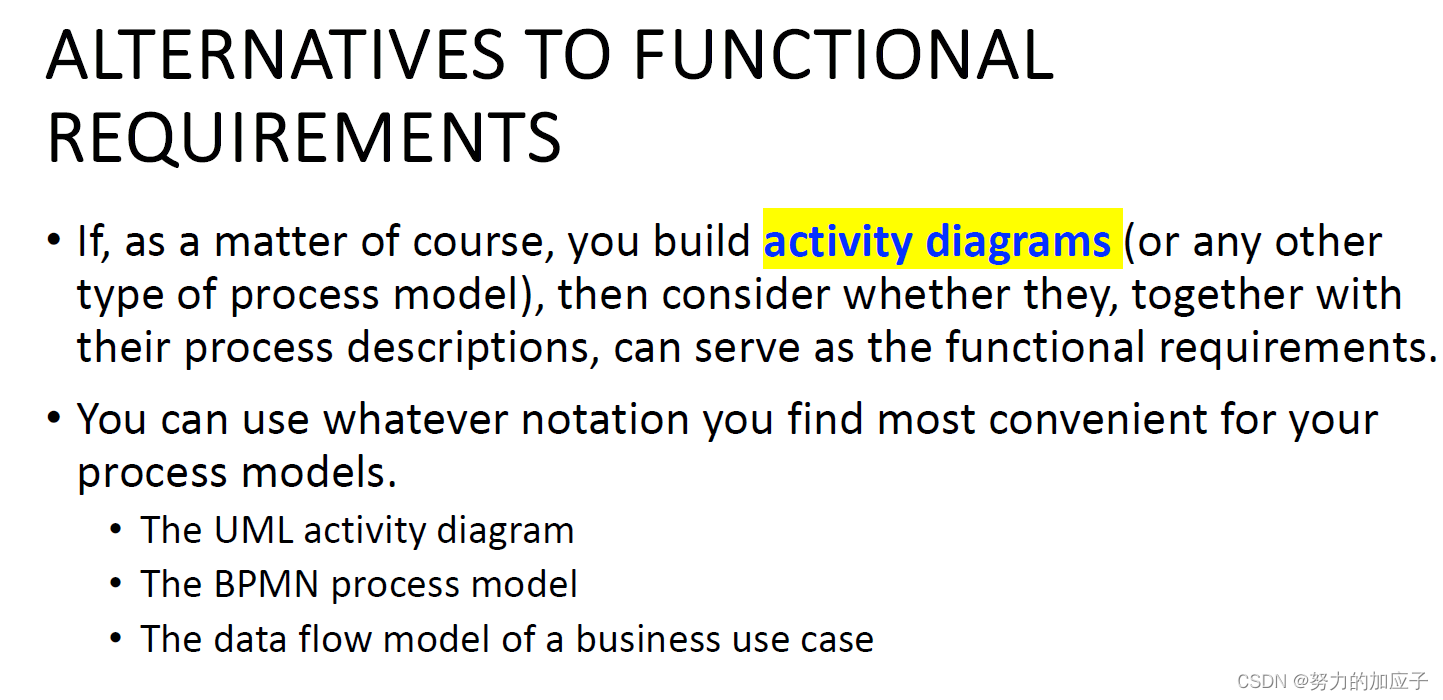
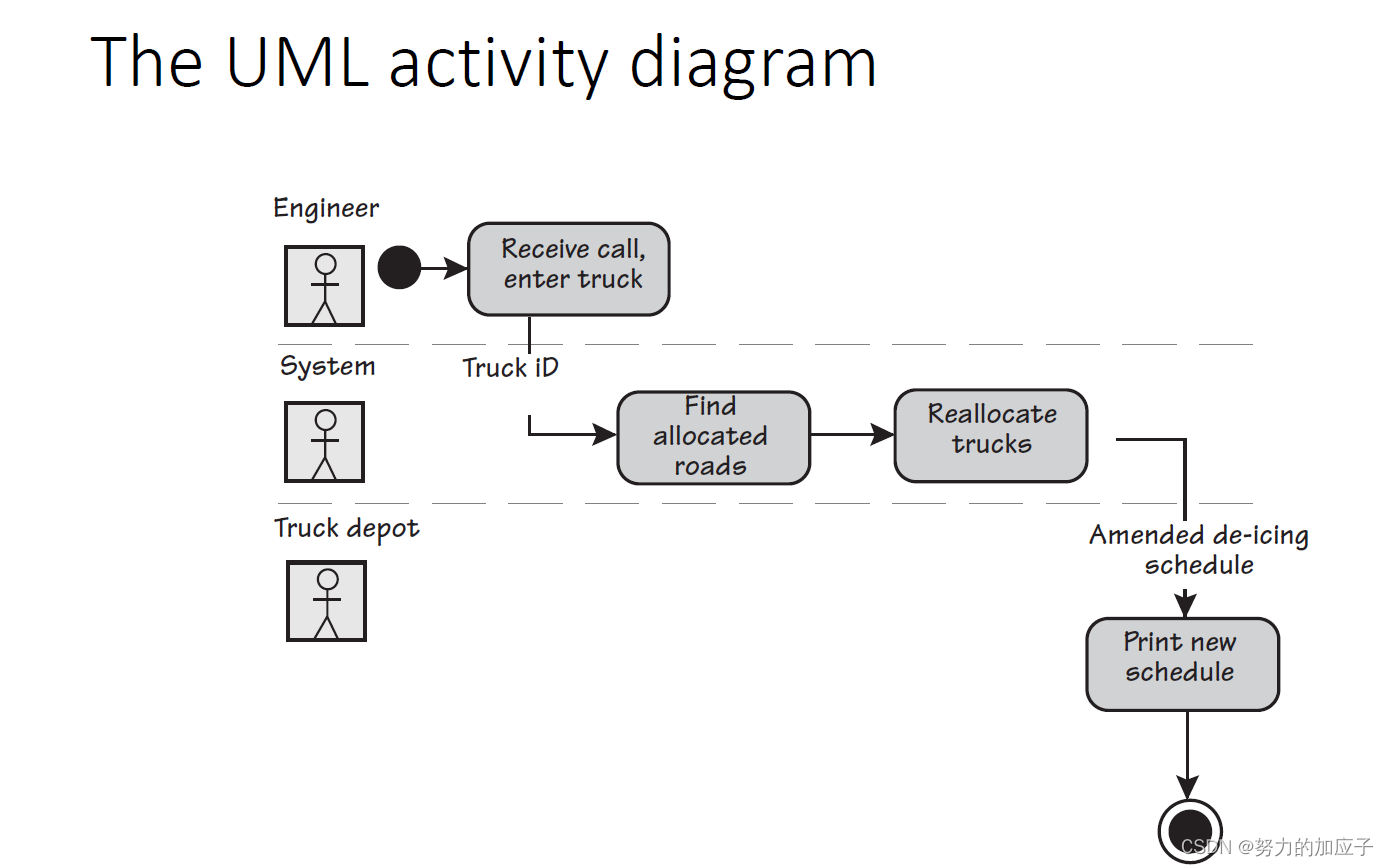

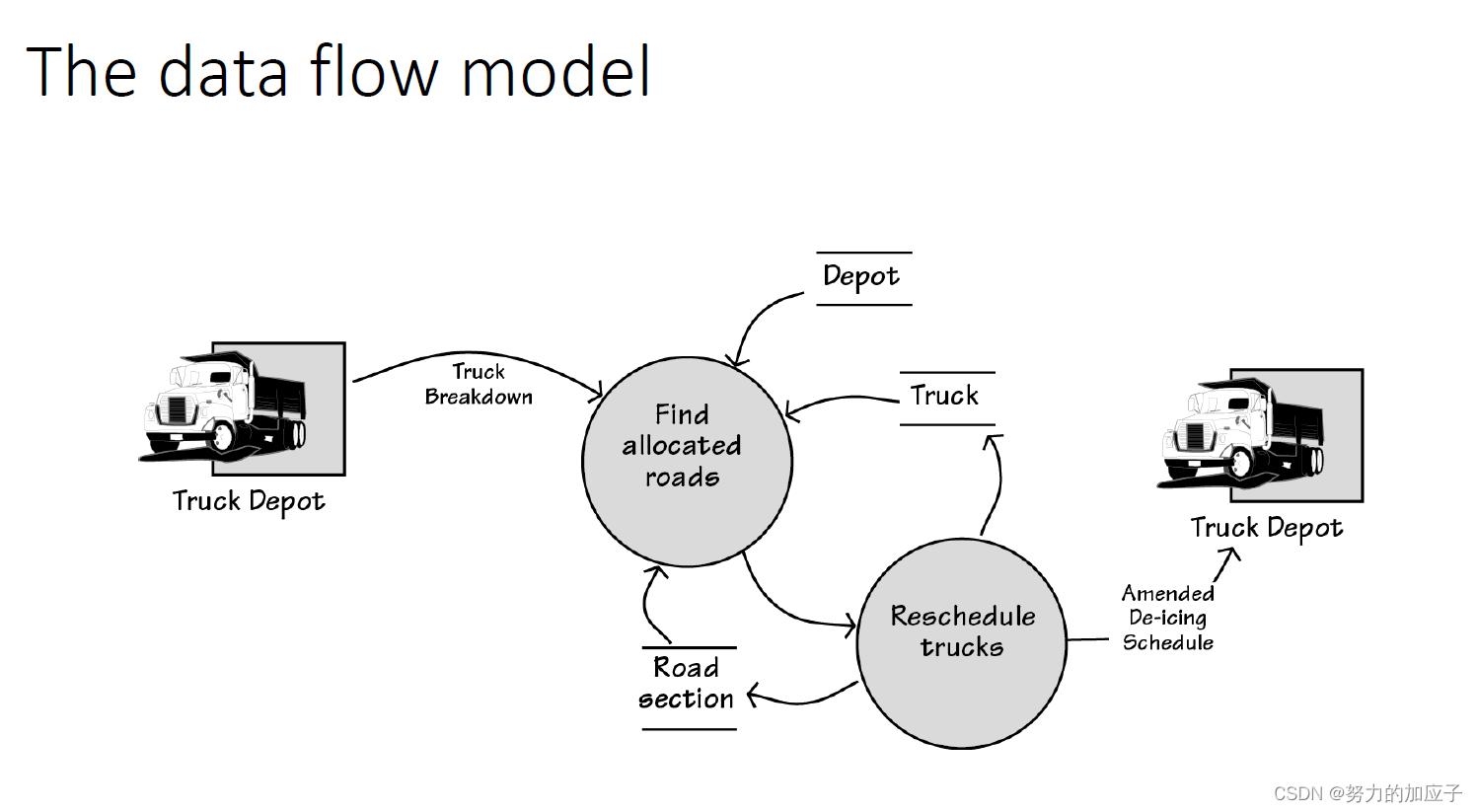
24
![]()


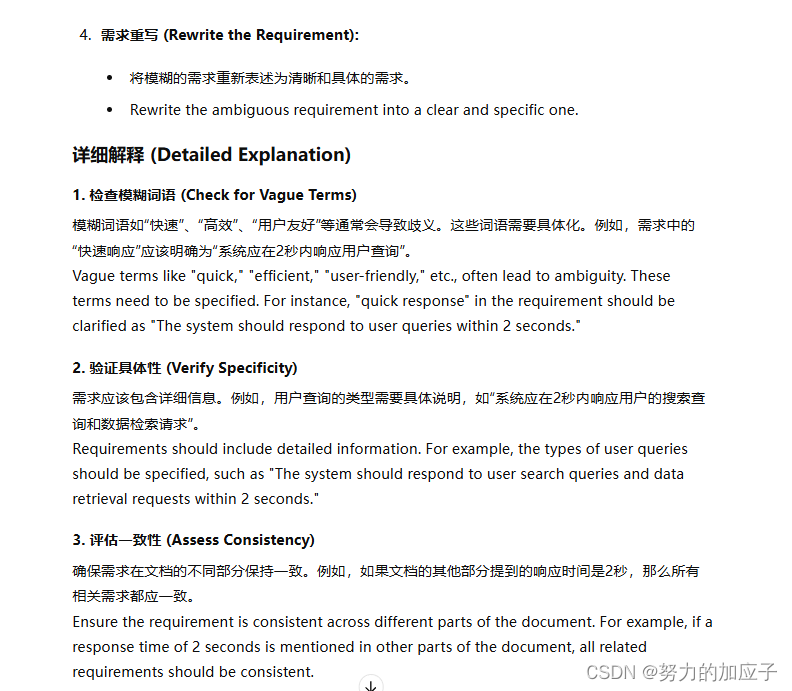
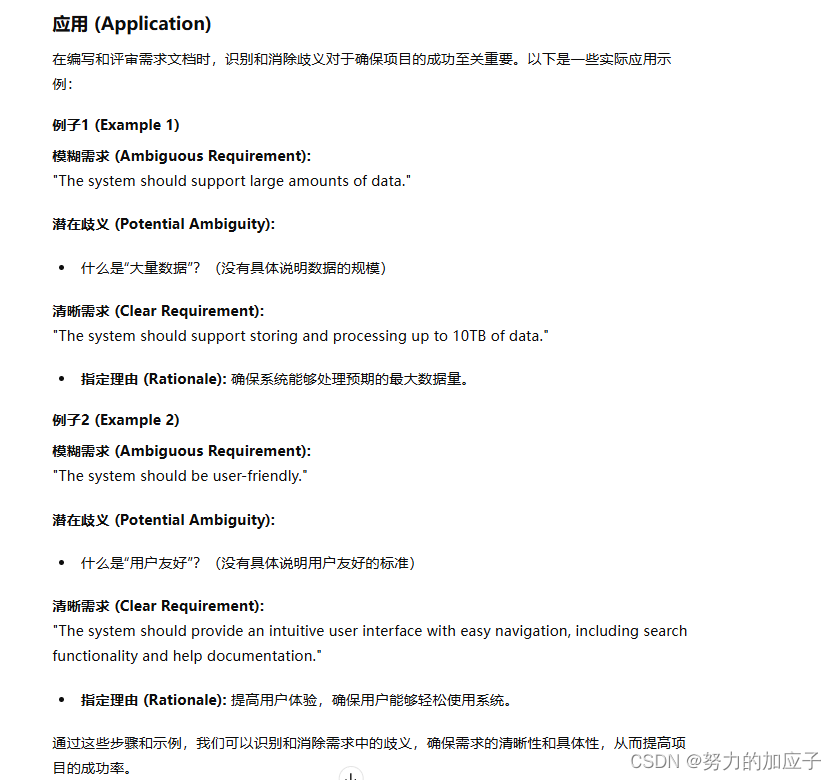
25




26
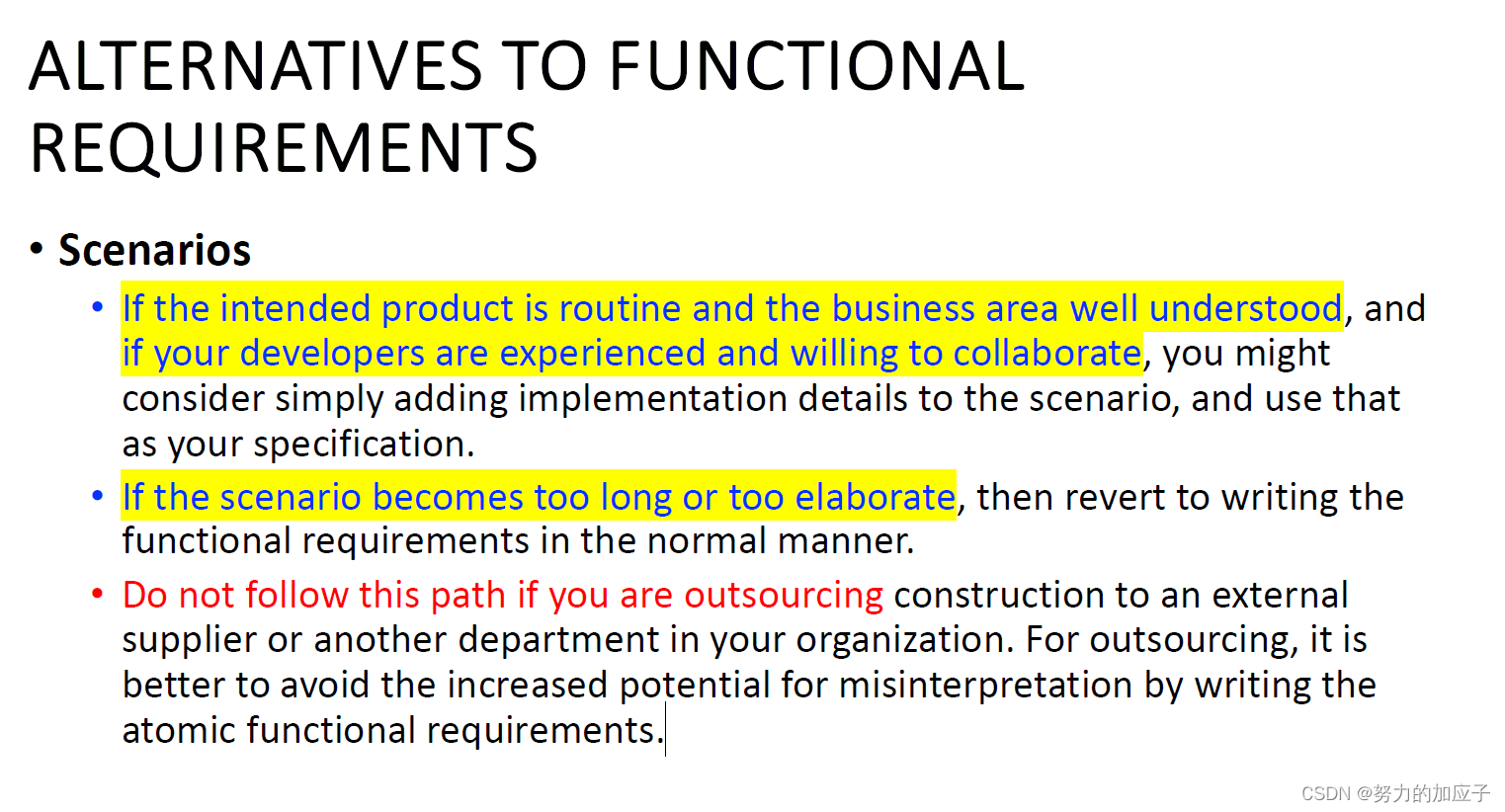
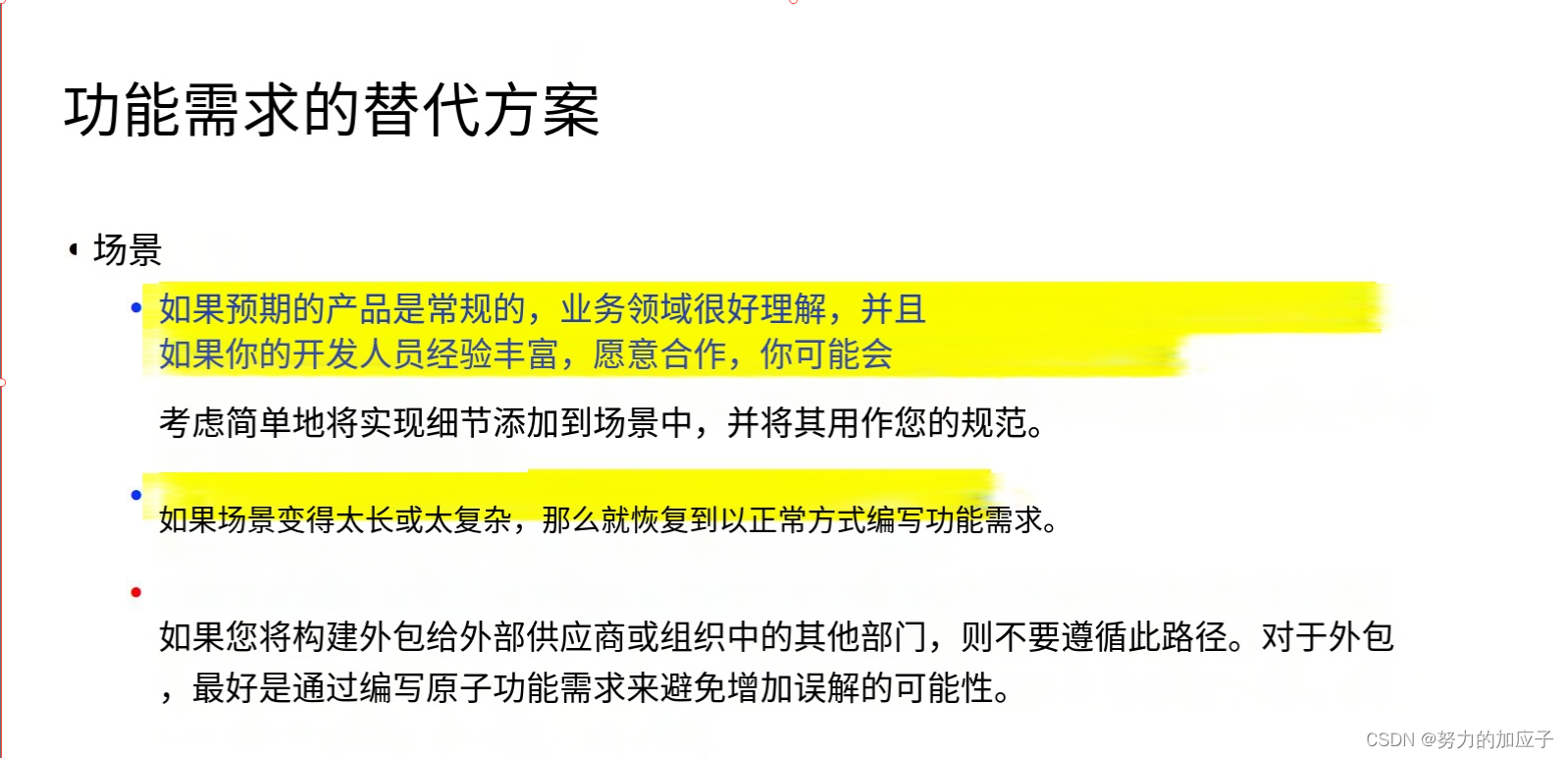
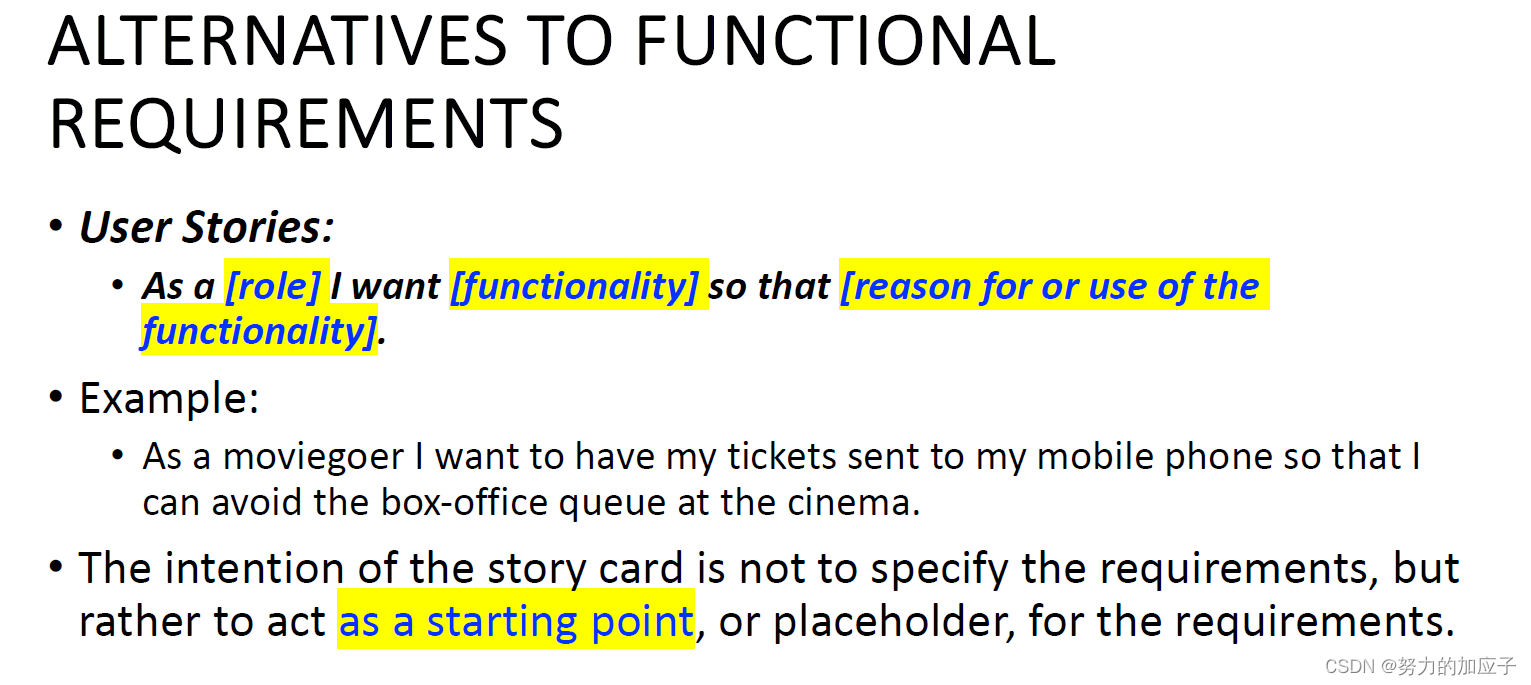
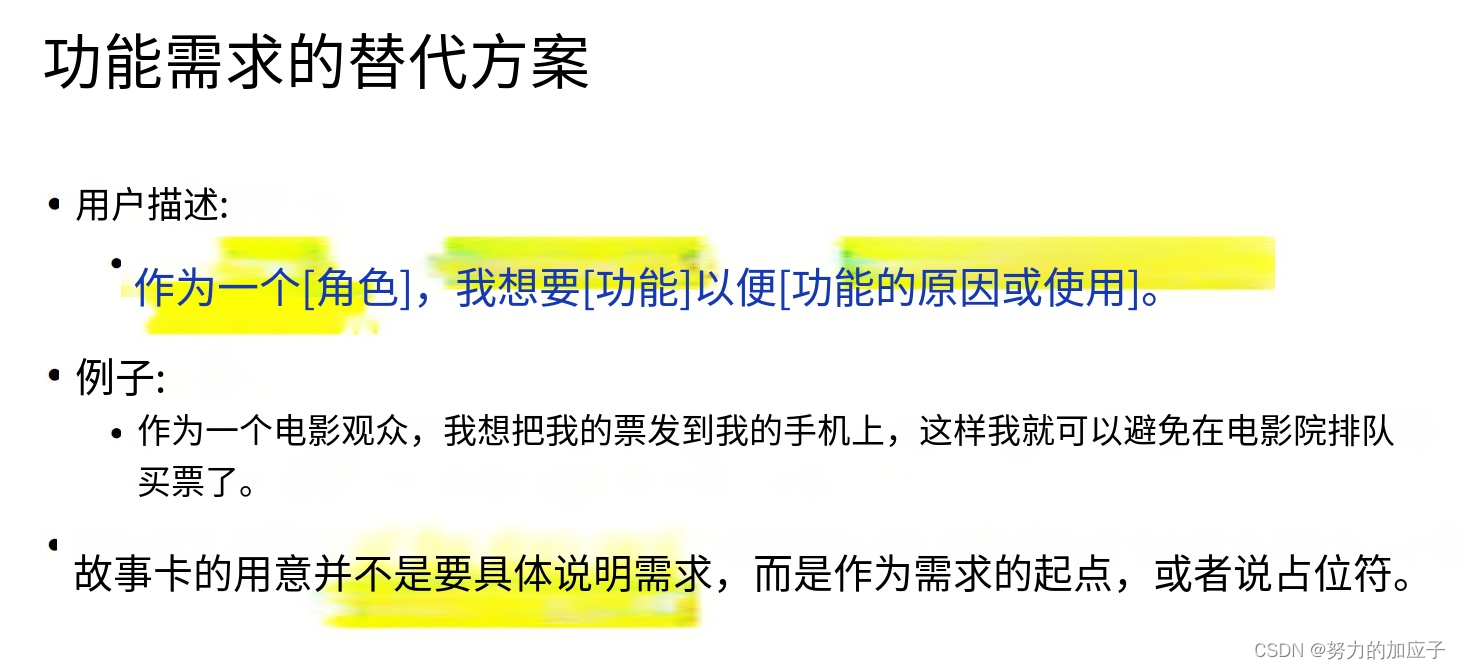
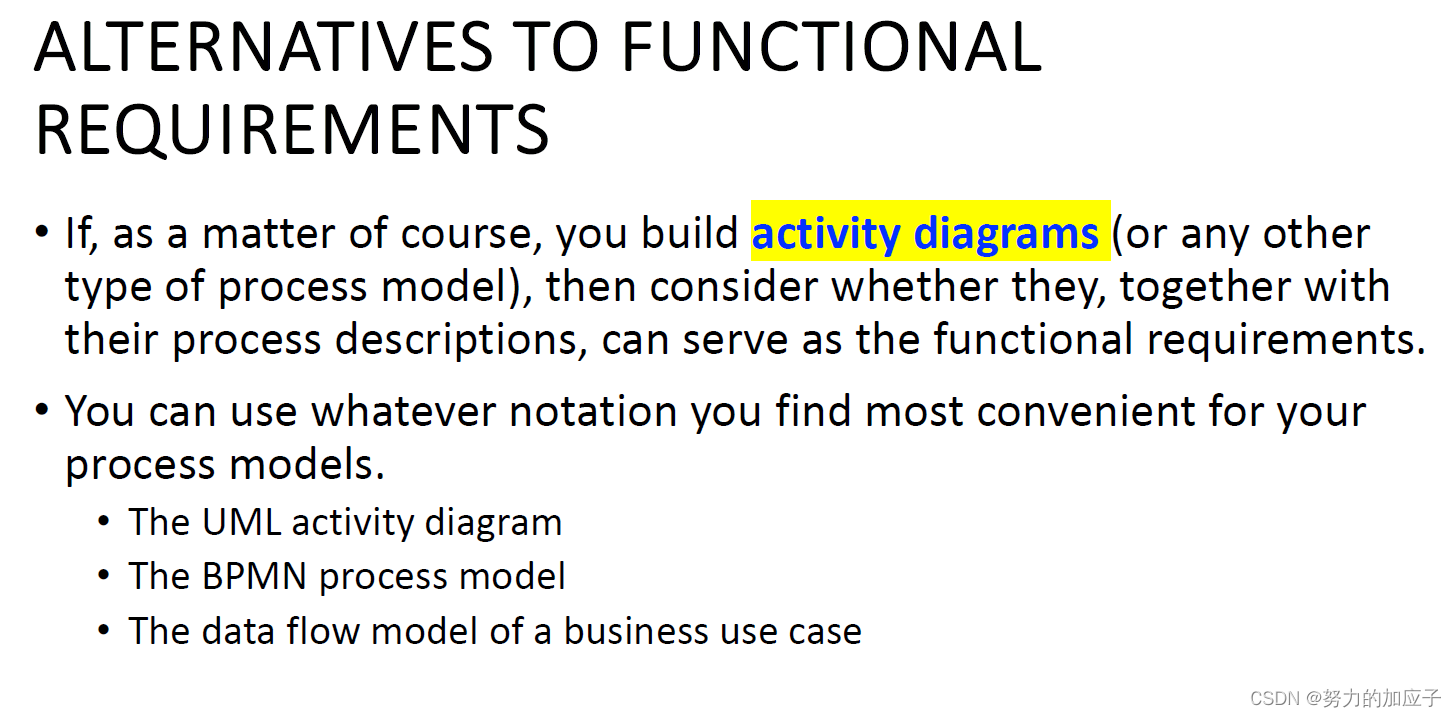
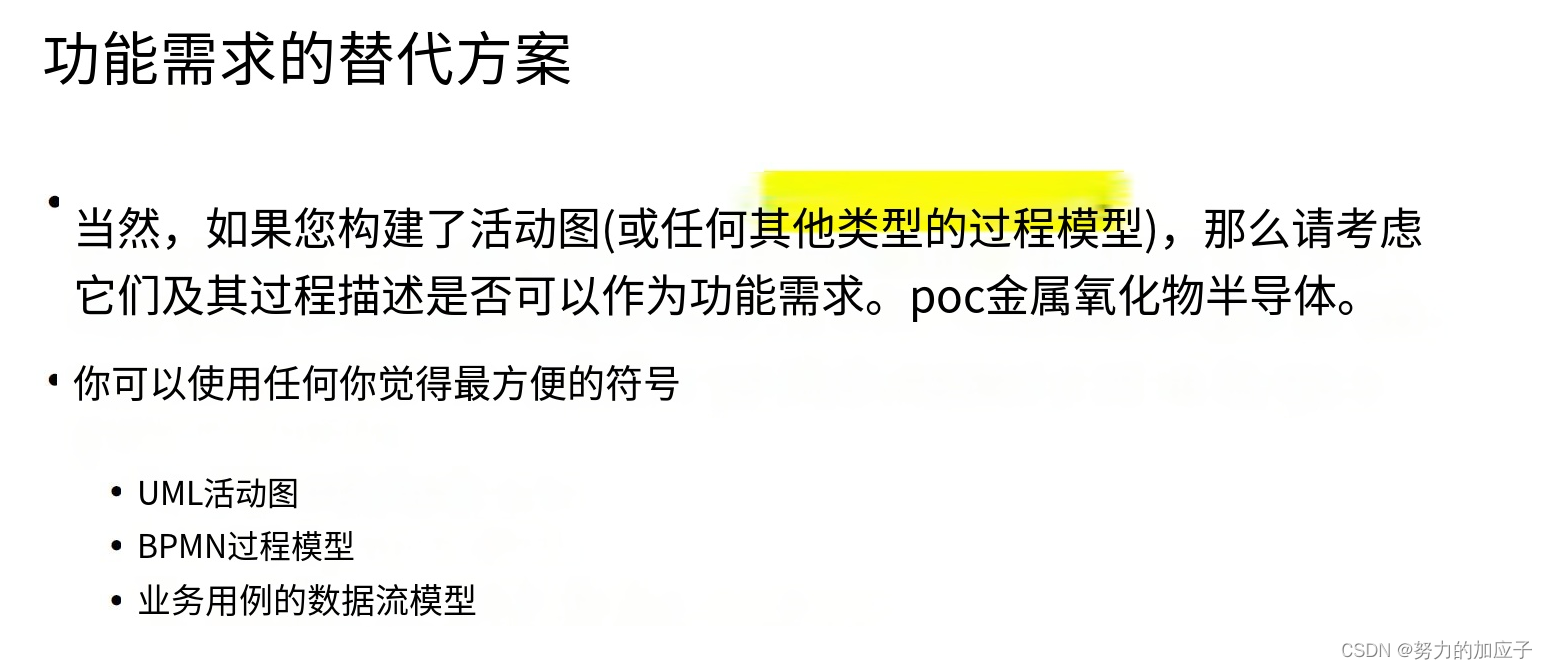
27



28


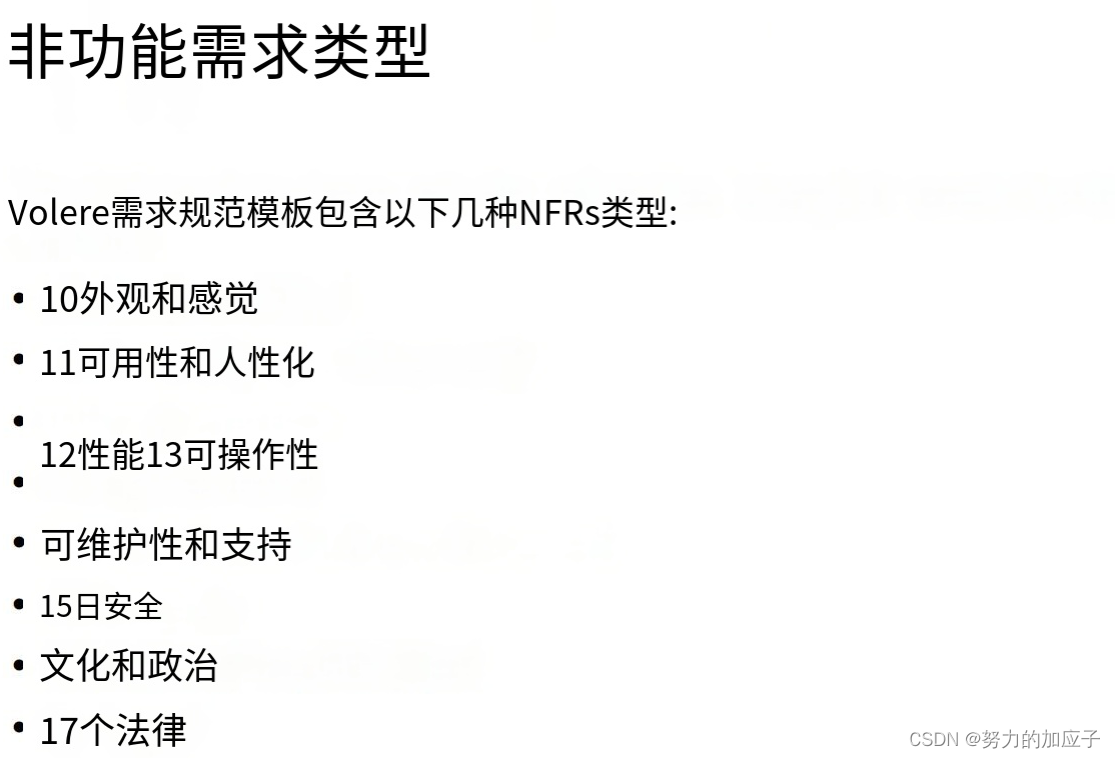
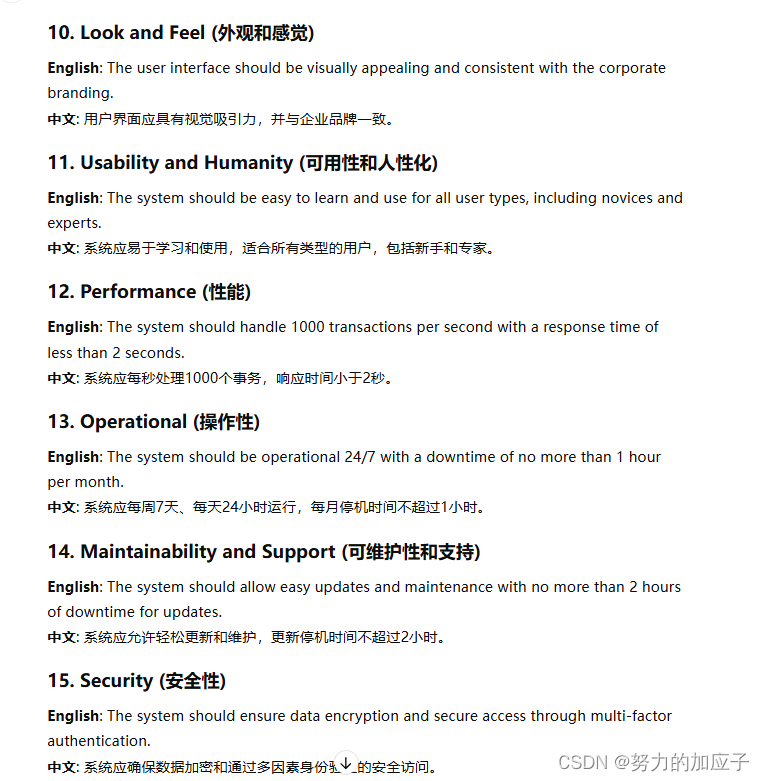

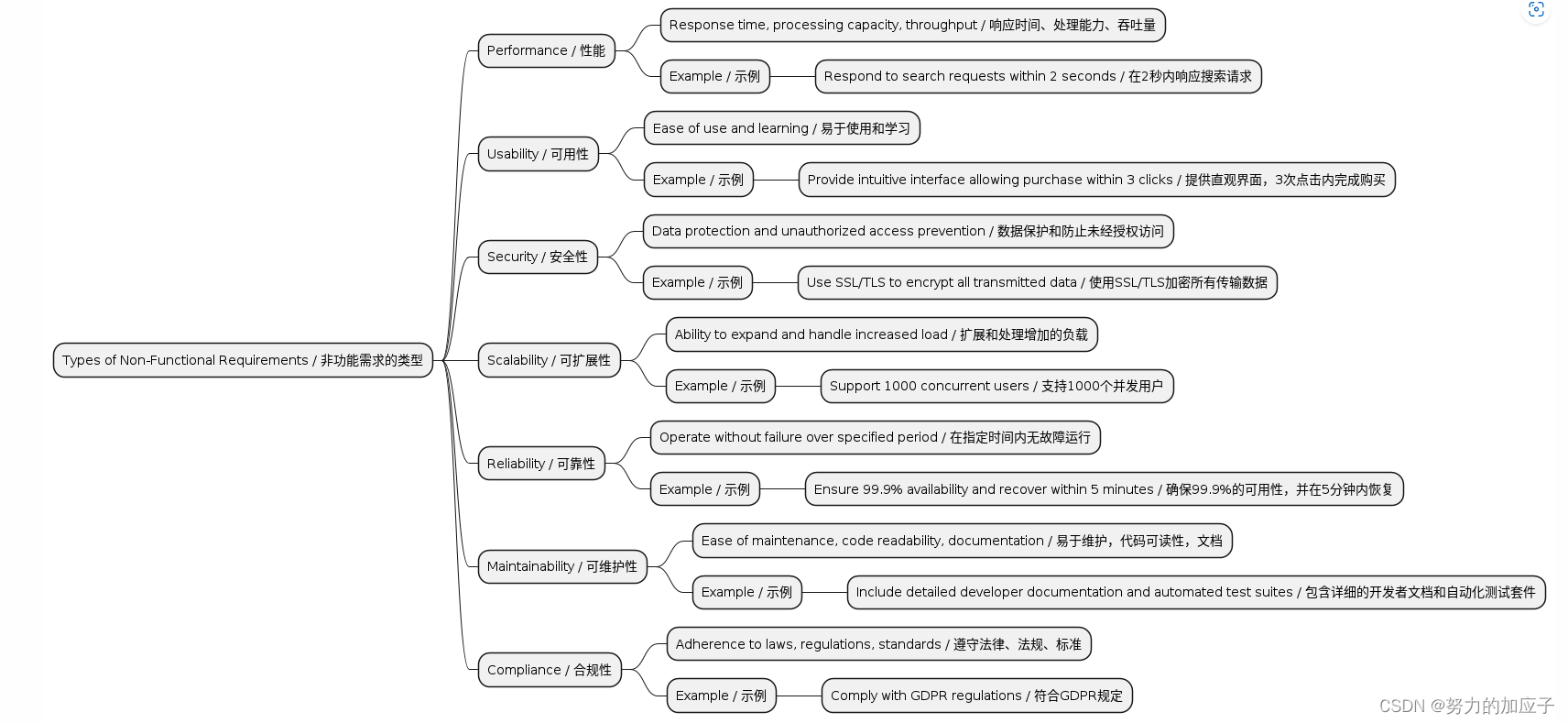
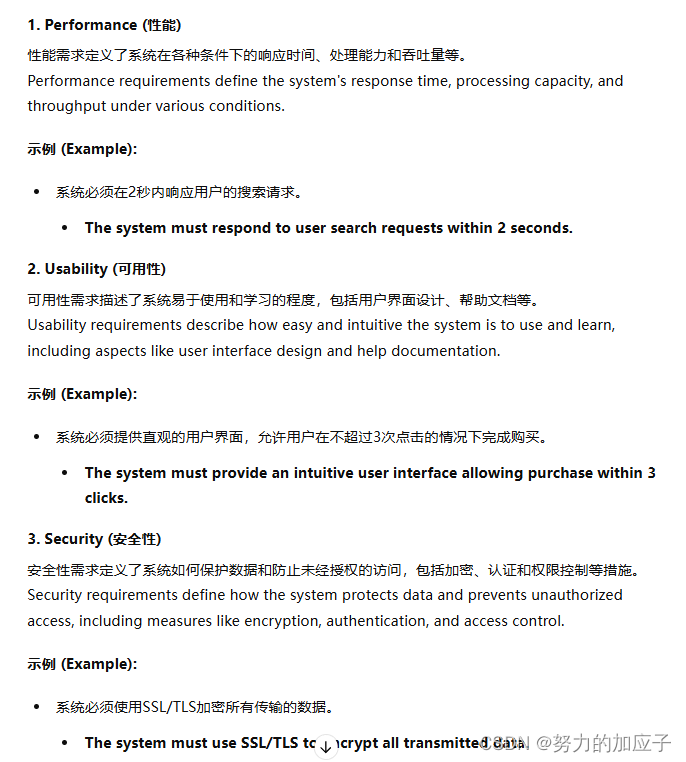
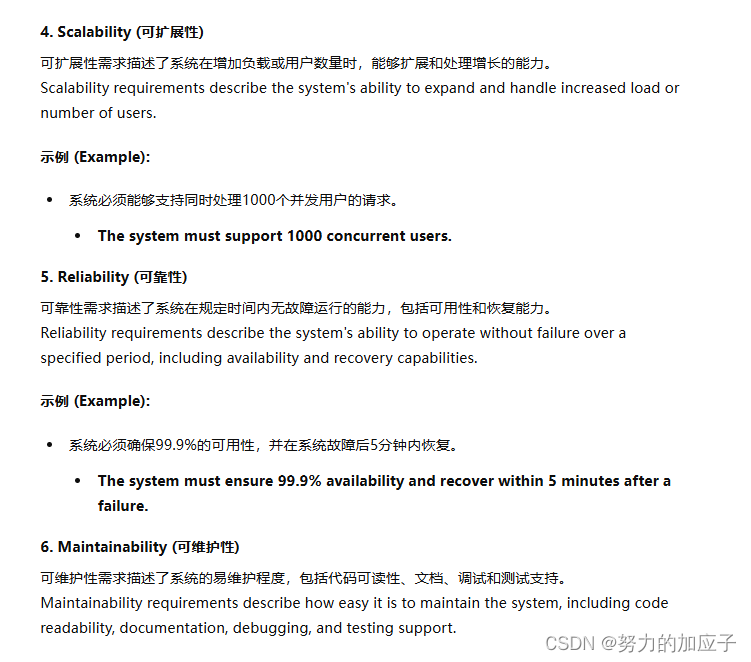
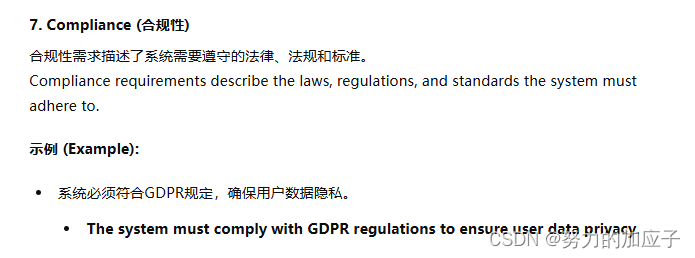
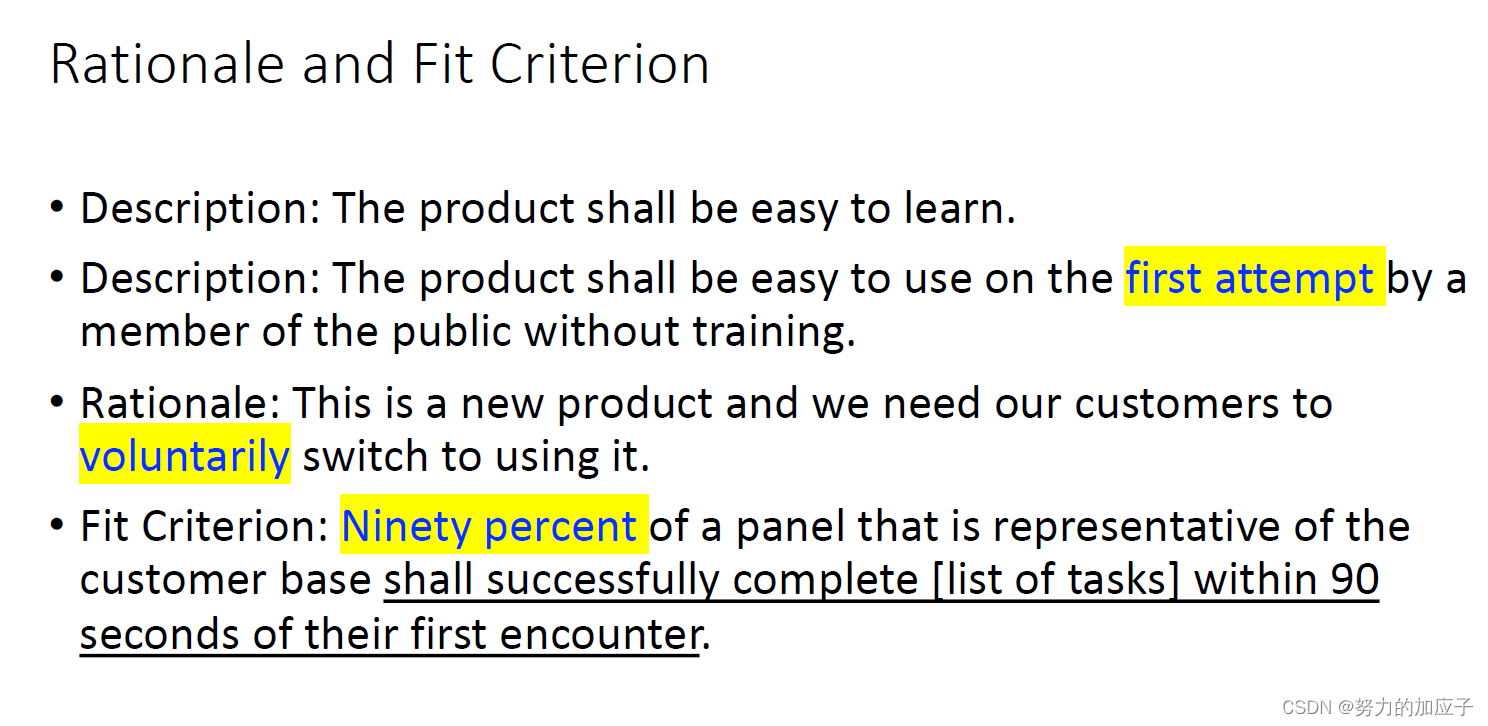
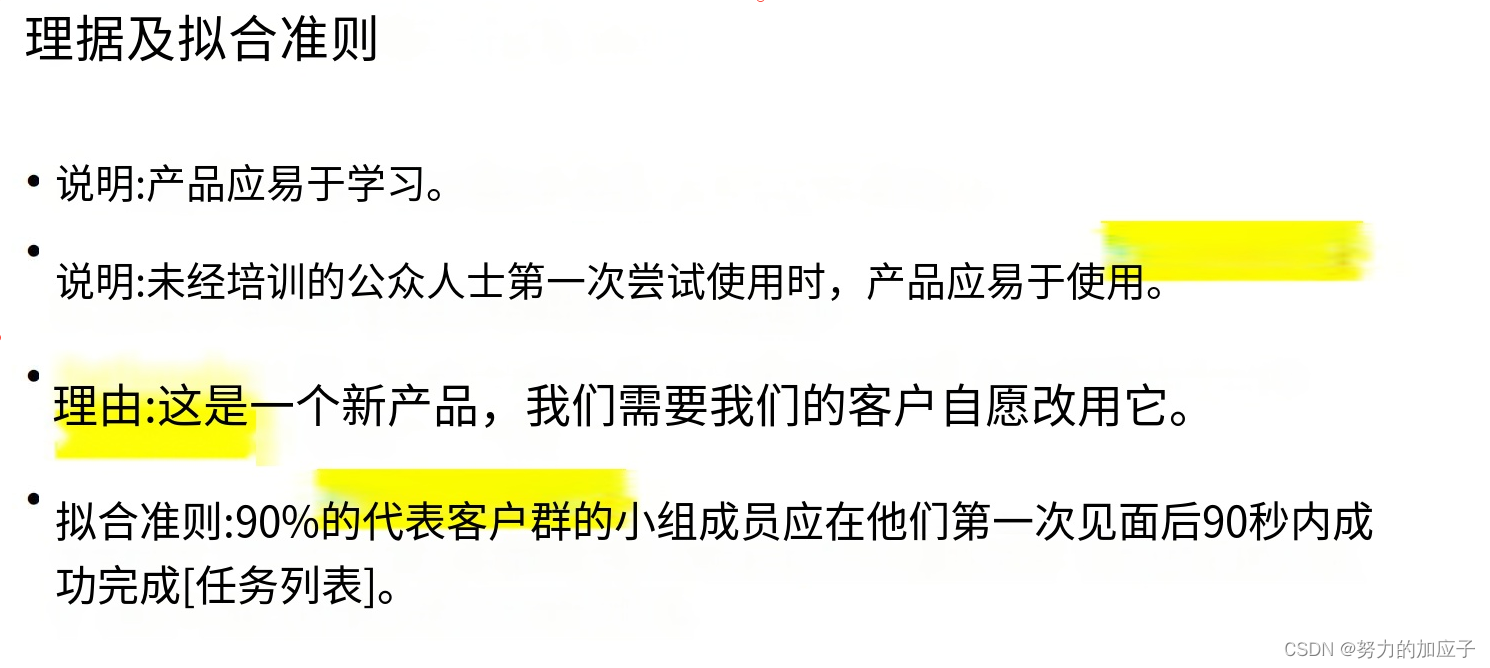
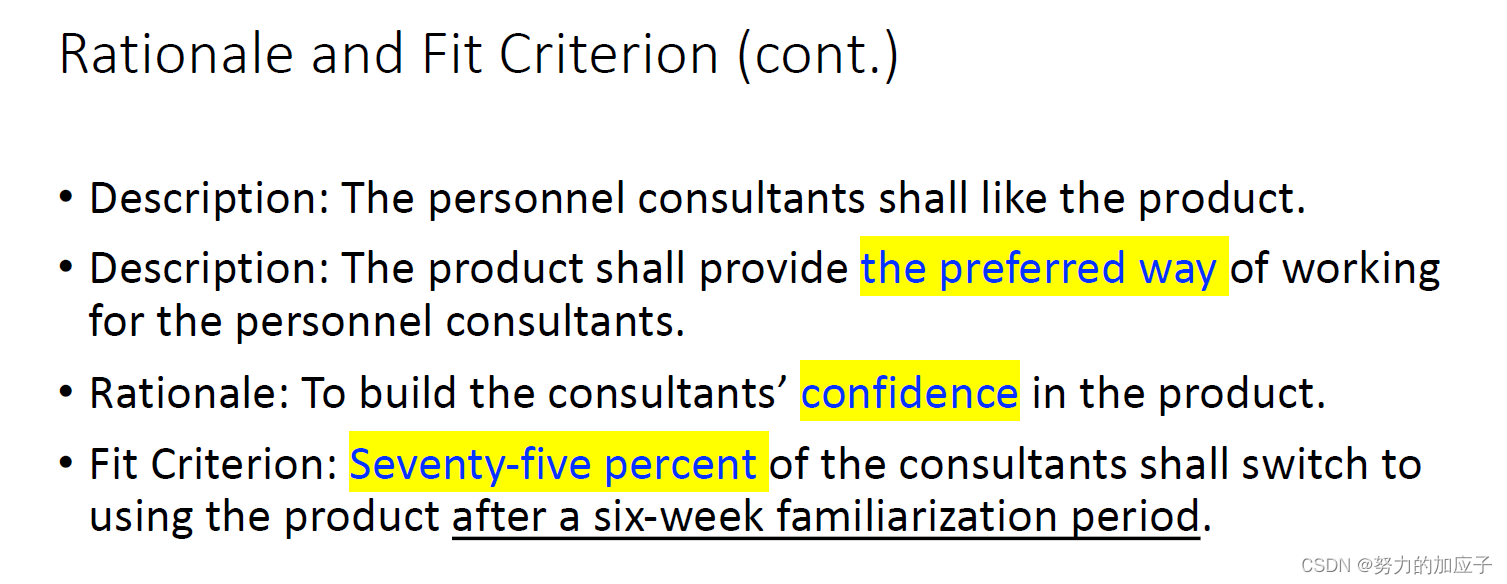

29
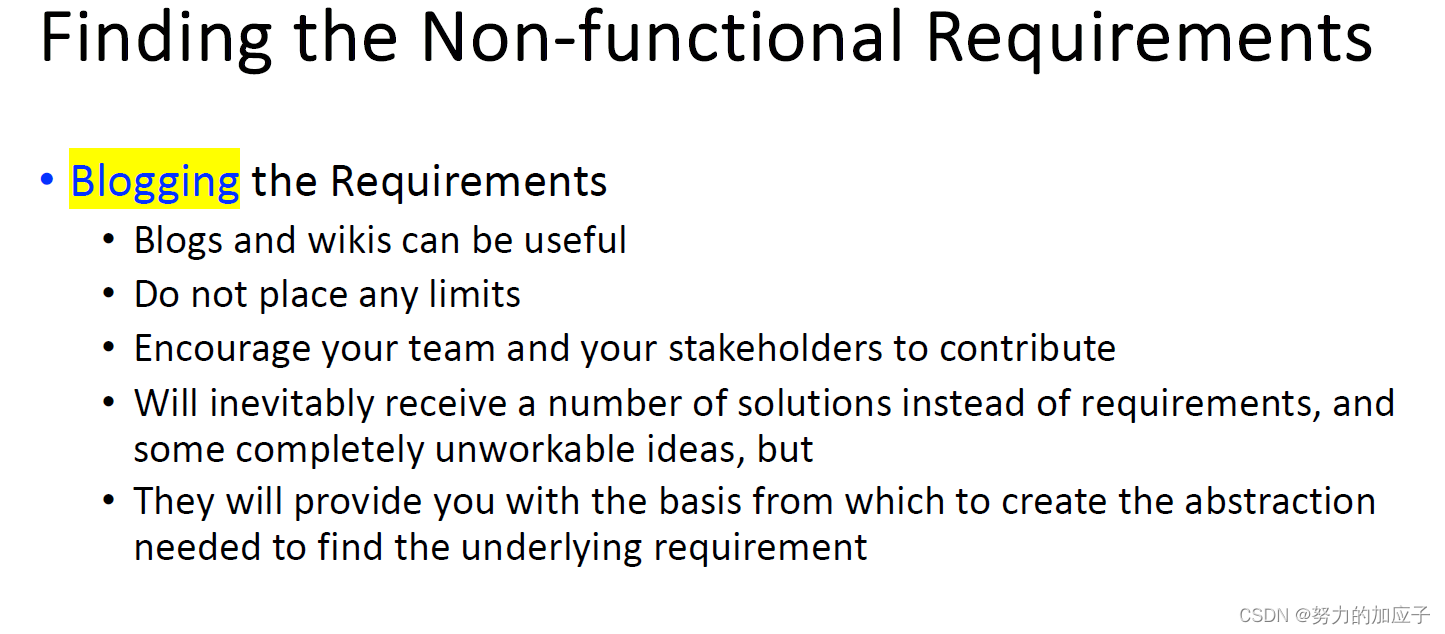
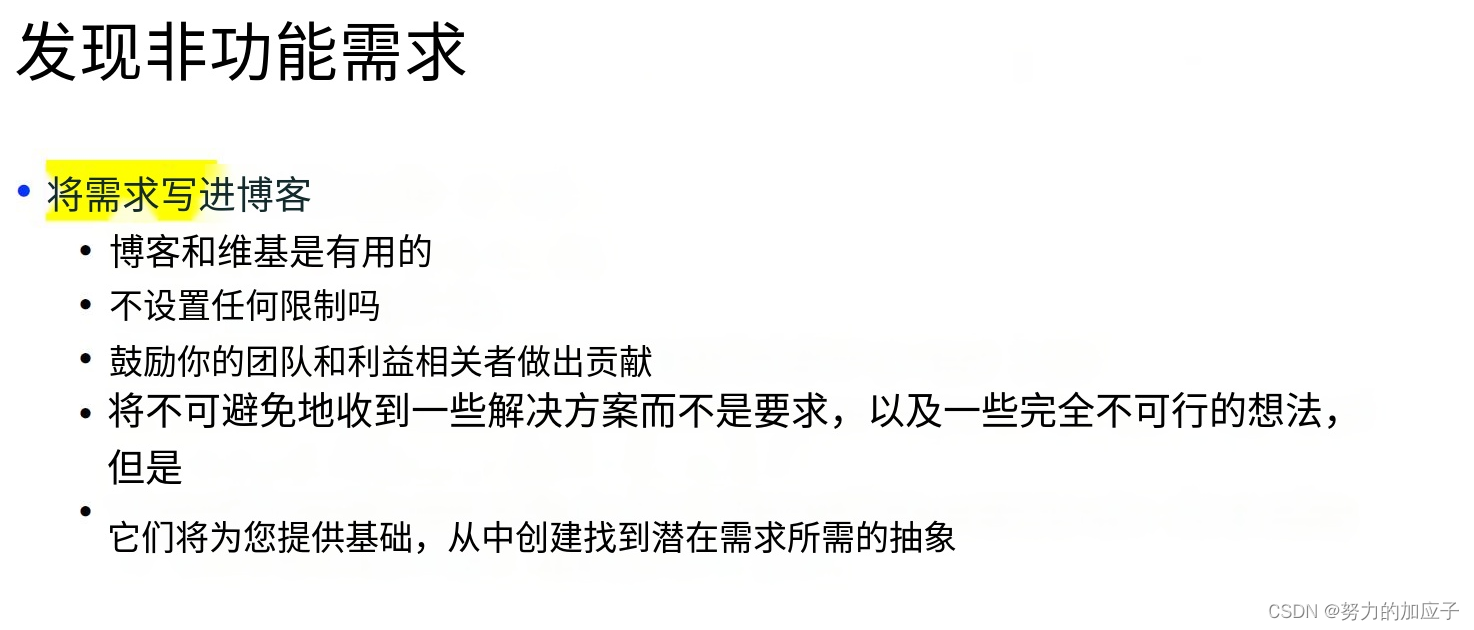
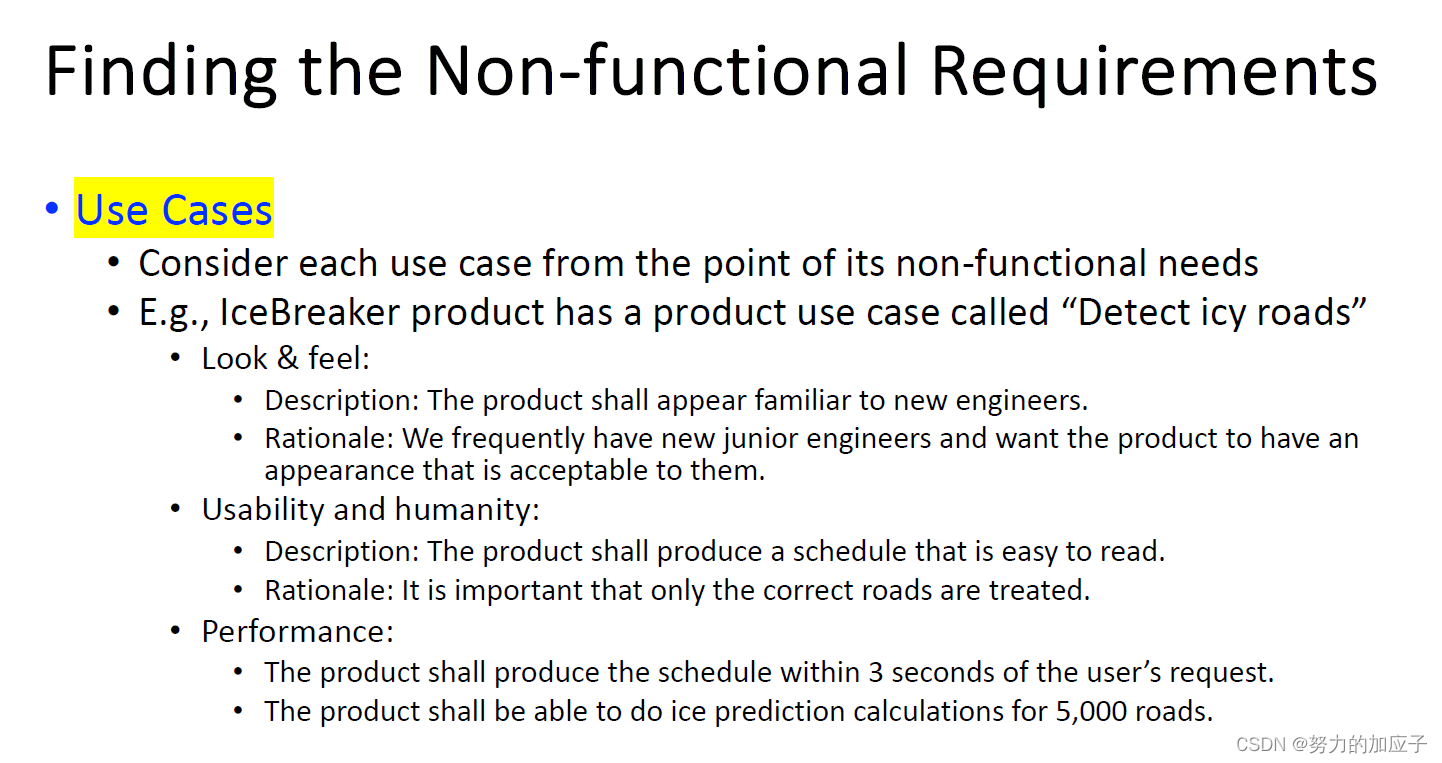

30
31
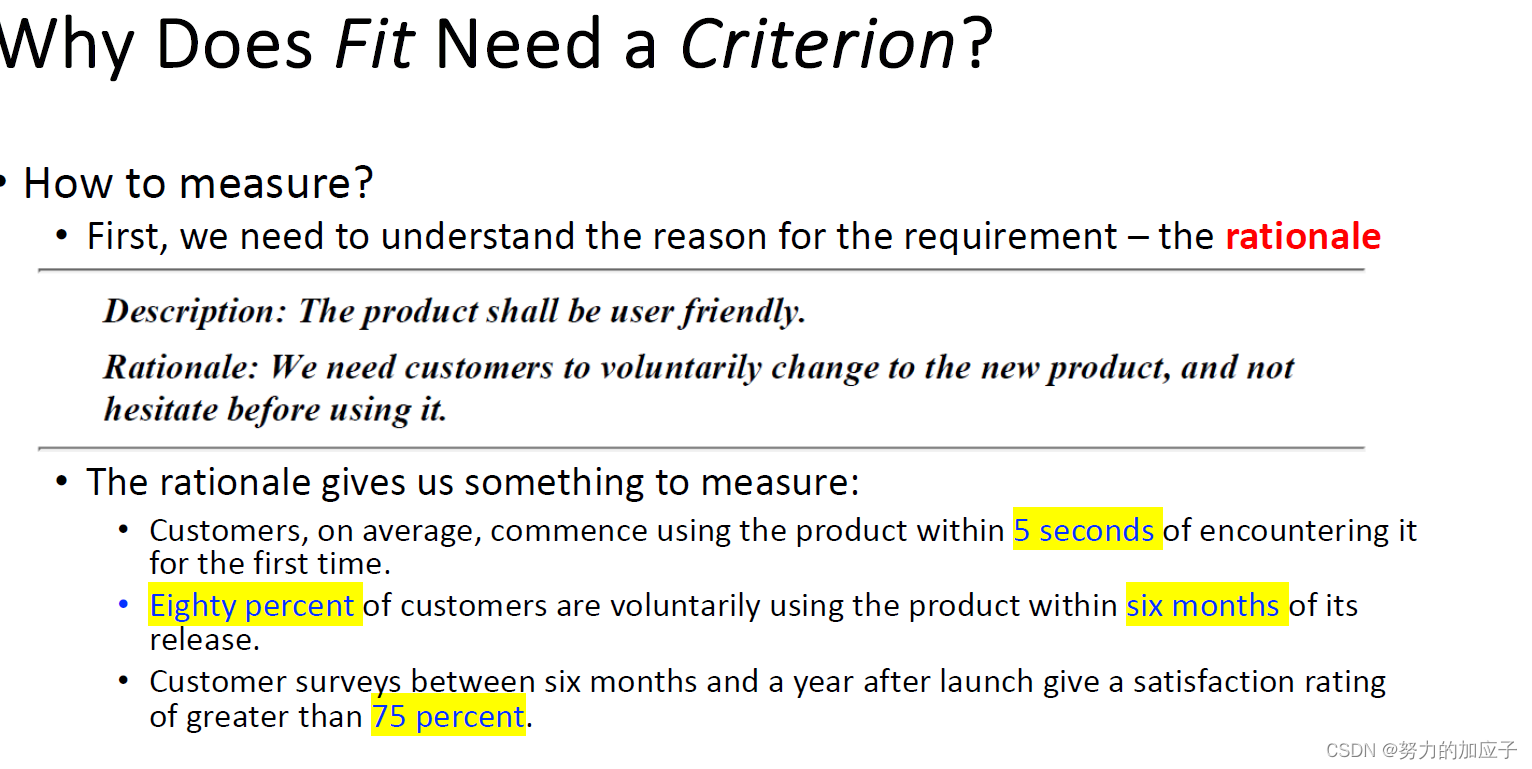


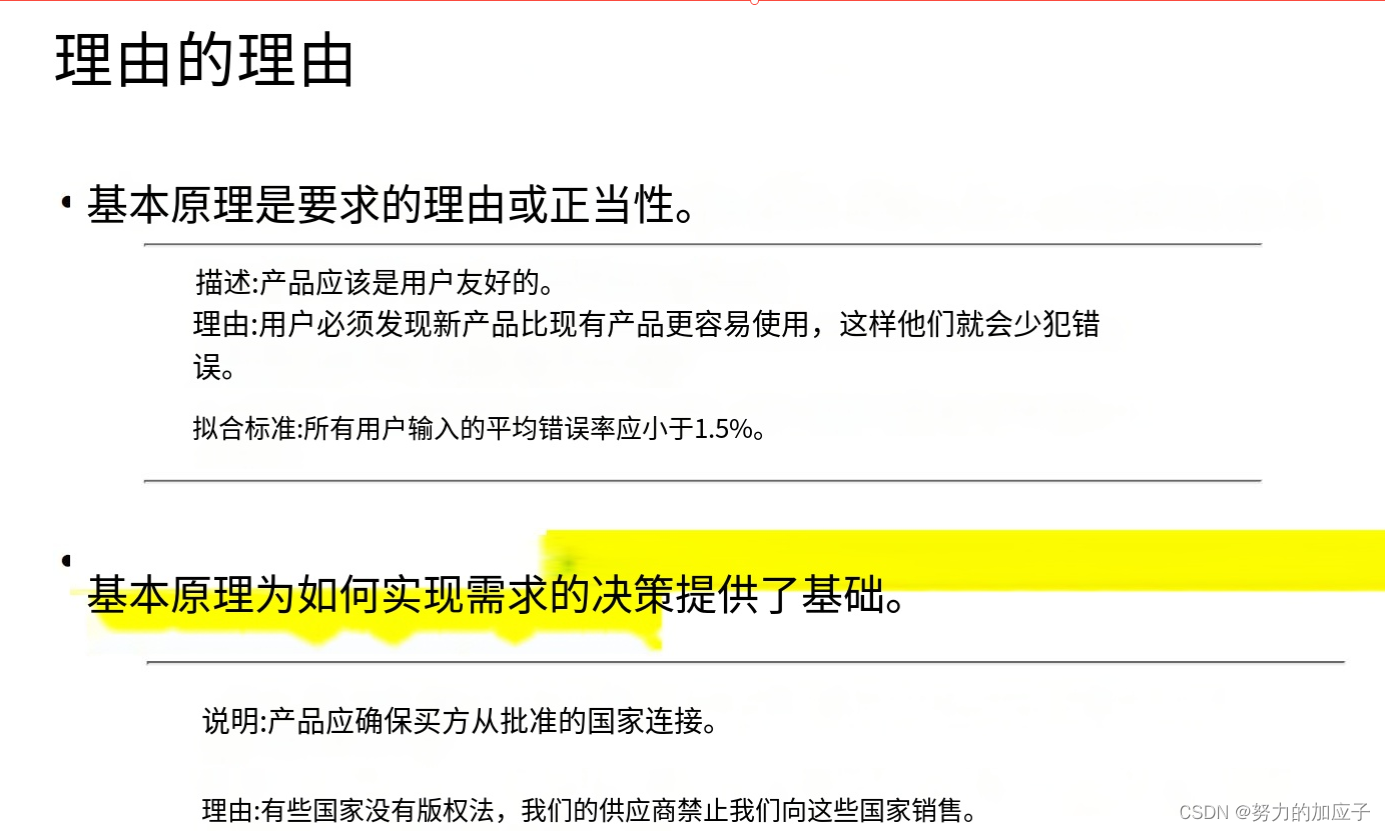
33
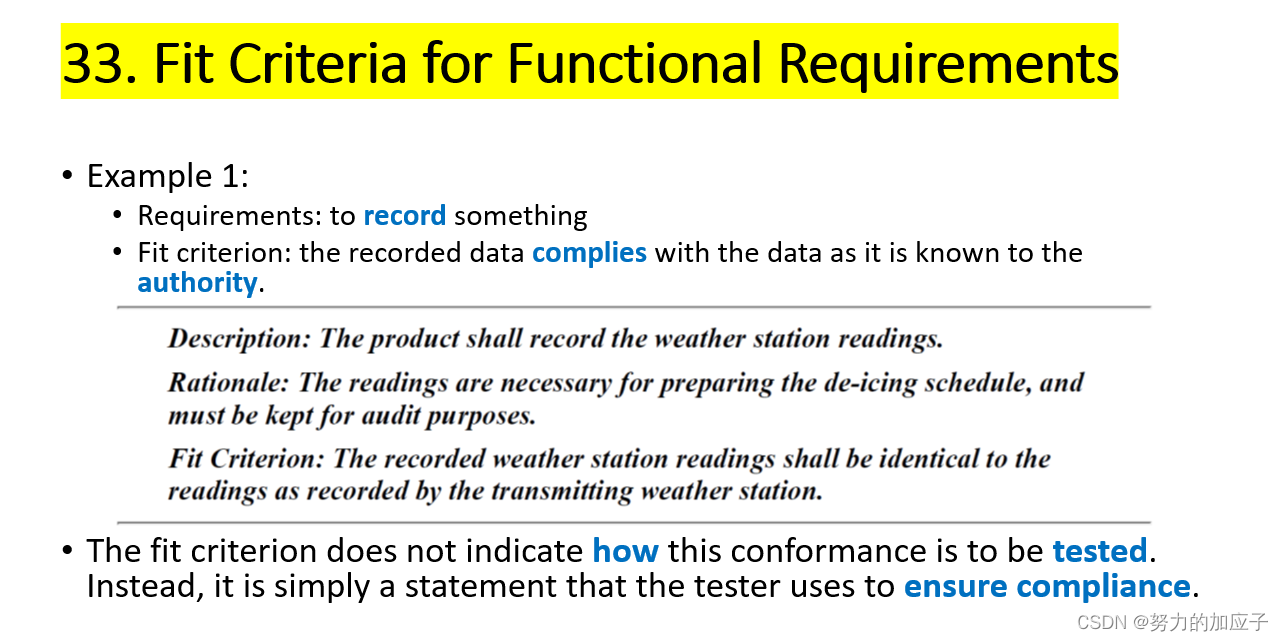























 2482
2482

 被折叠的 条评论
为什么被折叠?
被折叠的 条评论
为什么被折叠?








